|
Death Valley
Historic Resource Study A History of Mining |

|
SECTION IV:
INVENTORY OF HISTORIC RESOURCES--THE EAST SIDE
B. The Funeral Range
1. Introduction
The canyons and hillsides of the Funeral Range, running down the east side of Death Valley, have seen a wide and varied mining history. One of the first mines in the Death Valley region, the Chloride Cliff, was discovered and worked here in the early 1870's, and one of Death Valley's most productive mines, the Keane Wonder, is also located in this area. But the real burst of activity within this region, lie so many others within Death Valley National Monument, was a result of the great Bullfrog boom.
In a sense, the Funeral Range and the Bullfrog Hills areas had a symbionic relationship. Although we cannot be sure, it is a good possibility that one of the reasons that the locators of the Keane Wonder mine chose the Funeral range to prospect in was their knowledge of the Chloride Cliff mine, which had operated briefly some thirty years before. Although the original Chloride Cliff mine was never really successful, that was due more to the difficulties and costs of transportation in the nineteenth century than to the lack of ore content at the mine, and the knowledge that there definitely was ore in the area probably drew the attention of early twentieth-century prospectors. We do know that once the Keane Wonder Mine was located, its early fame drew other prospectors to the region, two of whom went on to discover the Original Bullfrog Mine, which kicked off one of Southern Nevada's most spectacular mining booms.
The great success of the Bullfrog boom, in turn, stimulated a secondary rush to the Funeral Range, as prospectors fanned out over the adjacent territory on the theory that one good discovery would lead to another. In fact, as the Mining World wrote in January of 1906, when the rush to the Funeral range was well under way, "Death Valley is the best prospected section in the world. For many years the danger accompanying the investigation has lured men to prospect this ground, hoping that the danger had kept other men away."
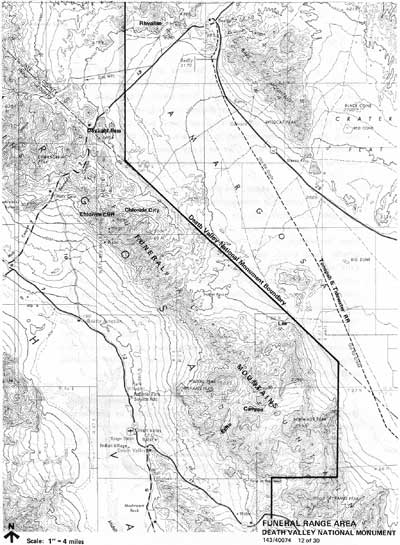
|
| Illustration 77. Map of Funeral Range Area. |
Although there is no doubt that the Funeral Range was covered with a swarm of prospectors during this time, their expertise was an arguable point. Another publication, the Mining & Scientific Press later called for a more thorough investigation of the possibilities of Death Valley, on the theory that the first mad rush to the region had been made by prospectors of questionable skills. "On the side favoring further prospecting around Death Valley it should be said that the prospectors have previously been the laziest lode-hunters on the desert. Much of the alledged prospecting has been done by "desert-rats," those half-mad desert tramps who never made more than a pretense of looking for ore. Their search was generally confined to trails between water-holes." The writer had a point, for many of the prospectors of the western mining frontier were no better than out-door bums, who followed the booms from one camp to another in order to cash in on the free-spending days of boom fevers. They were a representation of the losers of society, who found it easier to wander the hills in a vague search for gold while living off someone else's grubstake, than to look for a steady job.
At any rate, whether experienced or not, dedicated or bums, the Funeral Range was thoroughly prospected in the years between 1905 and 1907, as the Bullfrog boom rose to its peak. Numerous mines and mining camps were established during that period, enough to cause the formation of two distinct mining districts subsidiary to the Bullfrog District. The South Bullfrog District was centered around the Keane Wonder and Chloride Cliff mines, in the northern half of the Funeral Range, and the Echo-Lee Mining District straddled the lower Funeral Range from Schwab on the west to Lee on the east. Between Daylight Pass on the north and Furnace Creek wash on the south, there was hardly a square mile of territory which did not contain a mine or prospect during this period. There was gold in the hills.
Unfortunately, there was not enough gold to support the number of miners who wanted some. The mines and prospects of the region were greatly exaggerated and over-publicized, due to the excesses of the boom fever. Every new location within these booming districts was hailed as the new Comstock lode, while similar discoveries in isolated regions which were not booming were totally ignored. Once that fever began to subside, however, the smaller mines were quick to fade away. Their demise was helped by two disasterous events which affected all of western mining: the San Francisco earthquake and fire in the spring of 1906 and the Panic of 1907. To a lesser extent the San Francisco disaster cut short the amount of investor funds which were available to the young mines of the two districts for exploration and development, but the real disaster was the Panic of 1907. It hit the booming districts just when the mining companies needed money the most, in order to build mills, improve roads, invest in machinery, and continue development.
These two events, coupled with the gradual demise of the Bullfrog District itself, foretold the eventual end of the South Bullfrog and the Echo-Lee districts. The smaller mines were the first to go, but they were soon followed by the larger ones, before any really had a decent chance to find out whether the ore in the ground was rich enough and extensive enough to make a real producing mine. The towns of the districts, such as Lee and Schwab, likewise died with their mines, and never were given the opportunity to develop into substantial mining camps.
By 1910, the South Bullfrog and the Echo-Lee districts were almost deserted, with the notable exception of the Keane Wonder Mine, which steadily produced gold bullion throughout the years of discovery, boom and bust. But it, too, ran out of ore in the mid-1910s, and closed down. The Funeral Range was then left much as it had been found, except that uncounted shafts, tunnels, and prospect holes now dotted the countryside. Between 1920 and today, no significant mining has taken place within this region, although brief efforts were made to revive several of the larger mines. The scene today around most of these mines is much the same as it was seventy years ago. The only access to most of the region is along the old wagon roads and burro trails blazed by the Bullfrog era miners, and as years and washouts help the desert to slowly reclaim these roads, travel to the old mines and camps becomes more and more difficult.
But the South Bullfrog and the Echo-Lee districts were more typical than not of the life and death of mines and mining camps anywhere in the American west. For every famous mine and town, such as Goldfield and Tonopah, there were always hundreds of other mines and camps which tried and failed. The Funeral Range is, by and large, the history of such. [1]
2. Chloride Cliff
a. History
Chloride Cliff is a term which has been applied to a geographic area, a series of mines, a town, and a mining district. For the purposes of this discussion, Chloride Cliff will be used in its geographic sense, to define an area four miles square. This area starts at the Cliff itself on the south, where one may stand on an old mine dump and gaze down upon a spectacular view of Death Valley some 5,000 feet below, if the wind does not blow you off the side of the cliff. From here, the mining area stretches northwest beyond the site of Chloride City, with old mines and dumps covering the ridges and shallow valleys along the way.
The oldest mine on the east side of Death Valley National Monument, and one of the oldest within the entire Monument, is the original Chloride Cliff Mine. It was discovered on August 14th, 1871, by A. J. Franklin, a civil engineer employed by the U.S. Government to assist in surveying the Nevada-California state line. Although the story varies--some say he picked up a rock to kill a rattlesnake and found ore--Franklin somehow found what he thought was a vein of chloride of silver. He immediately staked out seven claims, called the Franklin Group, and the following October formed the Chloride Cliff Mining Company.
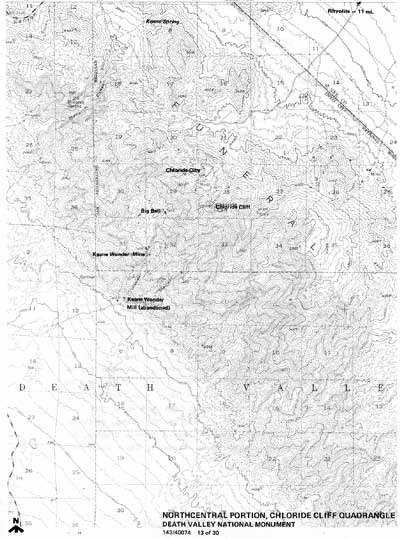
|
| Illustration 78. Map of North Central Portion of Chloride Cliff Area. |
In April of 1872, Franklin returned to his locations and began to work. Crude on-site tests indicated that his silver ore was worth between $200 and $1,000 per ton, and he began to dig a shaft. By July of 1873, when Franklin was employing seven miners, the shaft had been sunk to seventy feet, and he had nearly 100 tons of ore on the dump, ready for shipment. Transportation, however, was a definite problem, for there were as yet no distinct roads connecting Death Valley with any point of civilization. The mine was dependent upon San Bernardino, 180 miles away, for food and supplies, and although one man set a record for riding the distance in fifty-six hours, the normal string of pack mules took considerably longer to cover the route.
During 1872 and 1873, when the Chloride Cliff Mine was operating, pack trains arrived with supplies about every three months. As these mule teams traveled back and forth, they slowly identified the best route between Death Valley and San Bernardino, and by 1873, Franklin was proudly able to boast that a fully laden wagon could travel to within three hundred feet of his mine. This early route into the heart of Death Valley was subsequently used during the first years of borax mining at the Harmony and Eagle borax works.
But even with a new road to follow, the great expenses of packing in supplies and hauling out ore made the Chloride Cliff Mine unprofitable, unless a cheaper method of reducing the ore could be found. A newspaper reporter who visited the mine in 1873 summed up the situation facing Franklin. "in many things the prospects seem favorable, they have unquestionably struck a vast amount of ore but as yet the ledge is not sufficiently prospected to justify a great expenditure of capital in erecting works . . ." And while Franklin was trying to make up his mind, the great Panamint boom started on the west side of Death Valley, which made his small mine relatively unattractive to those who had capital to invest. After nearly two years of operation, the Chloride Cliff Mine shut down.
Given the poor records which have survived from these early days of mining, we have no estimate of production from the mine. The papers mentioned several times that pack mules were bringing out ore, but nothing more definite can be stated. But Franklin and his mine had a decided effect upon the future history of Death Valley. The wagon road blazed by his suppliers was used and improved by the large borax teams in later years, and Franklin had proved that there was ore in the Funeral Mountains. Thirty years later, when the Nevada mining boom began at Tonopah and Goldfield, prospectors remembered the old Chloride Cliff Mine, and came back to have another look at the area.
Franklin, in the meantime, did, not abandon his mine. Every year, he traveled back across the desert to perform the annual assessment work on the Chloride Cliff Mine, until his death in 1904. Then his son, George E. Franklin, followed in his footsteps, and kept the claim active via the required assessment work. Thus when the Bullfrog boom hit southwest Nevada, the younger Franklin held an active and valid claim, which could once more be profitable as transportation and supplies became cheaper through connections at the new boom town of Rhyolite. [2]
With the exception of the Franklins, the Chloride Cliff area was virtually deserted between 1873 and 1903, when the Keane Wonder Mine was located about two miles to the southwest of Chloride Cliff. Then, in 1904 the Original Bullfrog Mine was discovered, and the great Bullfrog boom was on. As the ground around the Bullfrog Hills was soon covered with locations, prospectors gradually spread farther afield and their attentions were naturally drawn rather quickly to the Chloride Cliff area. This region, after all, had already produced two mines, the Franklin Mine in 1873 and the Keane Wonder in 1903.
George Franklin was on the scene, and the new excitements caused by the Keane Wonder and the Bullfrog boom made him redouble his efforts on the old Chloride Cliff Mine. In the meantime, numerous other mining companies were appearing, as locations were made, bought and sold, and consolidated. The area around Chloride Cliff, from Daylight Springs in the north to Furnace Creek in the south, and from Death Valley on the west to the Amargosa Valley on the east, was swarming with prospectors, and in September of 1905 the South Bullfrog Mining District was formed. The old Chloride Cliff Mine, which was now commonly called the Franklin Mine, was included in the new district.
George Franklin soon had plenty of company. In the immediate vicinity of his mine, the Mucho Oro Mining Company began operations in April of 1905, the Bullfrog Cliff Mining Company was formed in October, and the Death Valley Mining and Milling Company appeared in November. These three companies, along with Franklin's mine, soon dominated the best ground in the Chloride Cliff area, and squeezed out the smaller companies and prospectors. By the end of 1905, the Mucho Oro had a tunnel in sixty feet and reported assays of $25 per ton. The Bullfrog Cliff Company, described as being "near" the Franklin Mine, was working ten miners, had a fifty-foot deep shaft, and reported ore values from $30 to $100. The Death Valley Mining and Milling Company, operating on ground next to the Bullfrog Cliff, reported five miners at work on two tunnels, with ore worth $40 to $60 a ton. George Franklin, still carrying on alone, reported average ore values in his old mine of $28.
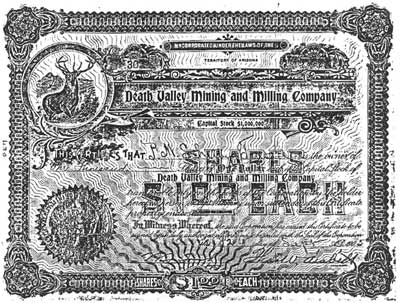
|
| Illustration 79. Copy of an early stock certificate, date September of 1905. Courtesy Dr. Richard Lingenfelter. |
All this mining activity, naturally, called for a supporting townsite, or at the very least a small mining camp, and Chloride City was born in 1905. Located in a shallow and wide saddle 4,800 feet above Death Valley, the little town was placed in a very picturesque spot, for those who could stand the winds which constantly whipped across the Funeral Mountains and brought snow and blizzards during the winter months. Chloride Cliff is depicted on a 1905 map as being a few blocks square, and surrounded by mines and prospects. Water for the mines and miners was packed in from Keane Springs, three miles north, and wood for the barren Chloride Cliff region was brought in from ten miles away. Prospects were promising, however, and the Chloride Cliff area had all the indications of becoming another boom camp. [3]
During the first months of 1906, developments proceeded at the Chloride Cliff mines. The Bullfrog Cliff reported that it had enough ore in sight to support a small mill, and purchased water rights near Keane Springs. J. Irving Crowell, the mine's principal owner, went to San Francisco to conduct mill tests and arrange for financing. The Death Valley Mining and Milling Company continued to drive its two tunnels and reported in February that it had fifty tons of $50 ore on the dumps, and one hundred tons of lower grade. The company announced that it would send its ore to the new custom mill at Gold Center for processing, when that mill was completed. While awaiting that time, the mine shut down temporarily. The Franklin Mine also continued to work, reporting in March that its shaft was 150 feet deep, with average ore values of $17 per ton.
In April The Death Valley Company began mill tests upon its ore, to determine the best method of treatment, and let a contract to have its tunnel extended another 350 feet. Then, the San Francisco earthquake and fire occurred, and the Chloride Cliff mines cut back on operations, as everyone waited to see what effect the destruction of the West Coast's financial center would have upon the mines. Very little work was done through April and May, and in June the Death Valley Mining & Milling Company owned the only Chloride Cliff mine which was able to resume operations.
The San Francisco disaster seemed to be the last straw for George Franklin. In July he finally gave up and sold the mine which had been in his family since 1871 to a Pittsburgh syndicate for a reported $150,000. The new owners, however, made no immediate moves to reactivate the mine. The Death Valley Mining & Milling Company, however, forged ahead with its development plans and work, and began considering a mill of its own, since it was becoming evident that the Gold Center mill would never be completed. The company inserted large advertisements in the Rhyolite newspapers, pointing out to potential investors to opportunities presented by the promising mine. But the post-San Francisco climate was not conducive to investment in a small and unproven mine, the advertisements proved futile, and the Death Valley Company abruptly shut down operations in late July. All the Chloride Cliff mines were now idle. [4]
The mines of Chloride Cliff then went through a period of hiatus. During the last half of 1906, and all through 1907, 1908, and 1909, while the rest of the Bullfrog District and the South Bullfrog District were experiencing their biggest boom years, the Chloride Cliff mines lay idle. Despite the fact that the Keane Wonder Mine to the west was now producing gold month after month, and that the Chloride Cliff mines were surrounded by the boom and bust cycle taking place elsewhere in the South Bullfrog District, these mines saw no activity. The Death Valley Mining and Milling Company did announce plans to resume work in April of 1907, but it never did.
During this period, however, one thing did happen, for most of the Chloride Cliff mines were slowly consolidated into one large company. Exactly when this took place is unknown. The Franklin group was sold again in February of 1907, but the transactions involving the Bullfrog Cliff and the Mucho Oro mines are unrecorded. By December of 1907, though, the Chloride Cliff Mining Company had been formed, which included the properties of the Franklin Group, the Bullfrog Cliff and the Mucho Oro companies. J. Irving Crowell, the former president of the Bullfrog Cliff Mine, was the president of the new company. Crowell announced that work would be resumed on the combined property in December of 1907, but his promise went unfulfilled.
All during 1908 the only activity at the combined mines was the required assessment work, and the same was true in 1909. !n December of that year, however, Crowell was finally able to announce that work would be resumed shortly and this time his promise was met. The mines had been leased to the Pennsylvania Mining and Leasing Company, which intended to develop the properties of the Chloride Cliff Mining Company. The stockholders of the Pennsylvania company, said Crowell, were "disposed to put the property into producing condition," and had ample funds available for the task. [5]
Finally, in December of 1909, after an interval of over three years, serious work began on the property of the Chloride Cliff Mining Company. Development work began that month, and by the first week of 1910, the company was beginning to sack ore for shipment. The mine made a small twelve-ton shipment to a Rhyolite mill for testing purposes, and began to consider the construction of a mill at Chloride Cliff. The Rhyolite Herald proudly announced the resumption of work and described the holdings and prospects of the company in glowing terms. The Chloride Cliff Mining Company, it reported, had leased its entire holdings to the Pennsylvania Mining and Leasing Company. Prior developments on these properties, which included the claims of the former Franklin Group, the Mucho Oro Mine and the Bullfrog Cliff Mine, consisted of four tunnels ranging from forty feet to two hundred feet in length, and eight shafts from eighty to one hundred feet in depth. Prospects were extremely promising, said the Herald and the world would soon see a flow of gold from the long neglected mines of Chloride Cliff.
The ore tests carried out in Rhyolite were successful, with average values of $37 per ton obtained, and in late January of 1910 the Pennsylvania Company announced definite intentions to build a mill. During February the company began improving the road between its estate and Rhyolite, in order to facilitate the delivery of mill machinery. The Nevada-California Power Company, which was considering the extension of power lines to the Keane Wonder Mine, promised to extend another branch line to the Chloride Cliff mines when the Keane Wonder line was built. In late March the company's small mill arrived and was installed. It was only a one-stamp prospecting mill, with a ten to twelve ton daily capacity, but its purpose was to enable the company to conduct ore tests on the spot. The mine had a small supply of high grade ore, and hoped that by running it through the little mill, funds would be generated to build a larger one. The mill was installed on the side of the cliff below the old Franklin Mine, which was the main group of claims being worked.
By the end of April, the Rhyolite Herald was able to announce that the Chloride Cliff Mine was finally making good. The Pennsylvania Mining and Leasing Company had now expended $10,000 on improvements and developments on the property, and the new mill was installed. Hardly was it placed in operation, however, than the company found that the available water supply was too small to run the mill, and it was shortly abandoned. With its new mill useless, the company shifted gears and proposed to lease one of Rhyolite's idle mills, and to haul its ore into town for reduction there.
But developments came slowly. The company succeeded in leasing the Crystal Bullfrog Mill at Rhyolite, and obtained a 12-horse team to haul ore to the mill site, but as June stretched into July, no ore shipments were made. The company was employing eight miners at the mine, but developments proceeded at a rather slow pace. In the meantime, the Pennsylvania Mining and Leasing Company was undergoing internal reorganization, and in August J. Irving Crowell, president of the Chloride Cliff Mining Company, emerged as president of the Pennsylvania Company. Crowell was thus in charge of the company which was leasing ground from the mining company of which he was also president.
After the reorganization, activities quickened. One hundred tons of ore were treated at the Crystal Bullfrog Mill in August, and Crowell announced that the mine could keep the mill well supplied for quite some time. Average values of the ore taken to the mill were $35 per ton, and the mill reported savings of 90 percent of the value of the ore. Taking these figures, the mine should have received returns of $3,250 for the ore which was treated in August. With the initial successes, the company announced plans to increase its ore shipments in the near future, and searched for more horse teams to haul ore. The company still owned a good water right about three miles from the mine, but the cost of installing pipe and pumping water uphill to the mine would be high. Nevertheless, the company planned to do just that, provided that the ore values in the mine held up with development. Although sporadic work was being done on all the company's claims, the main mining effort was still being concentrated on the old Franklin Mine.
From August to October of 1910, the company continued to work. Ore output was increased, and the company soon had four sets of horse teams hauling ore from the mine to the mill. The dumps at the mine contained over 200 tons of milling ore, and seven tons were delivered to the mill each day. During September, the Pennsylvania Mining and Leasing Company also began to ship some high-grade ore directly to the smelters at Needles, California and Goldfield, Nevada. Then, in the middle of October, work stopped while more plans were made.
The company announced that it had decided to enlarge its own one-stamp mill at Chloride Cliff. Three hundred tons of ore had by now been processed at the Crystal Bullfrog Mill, but the average mill savings had only been 60 percent on the average $30 ore. The company was obviously losing much of its ore content, which it could not afford to do. The company planned to continue sending selected high-grade ores directly to the smelters, but would add two. more stamps to its own mill, as well as concentrating tables and cyanidation treatment. Water development was in progress at the company's source near Keane Springs, and the enlargement of the mill was of necessity dependent upon the delivery of water to the mill site. To do this, the Pennsylvania Company intended to install a four-mile pipe line and a pump at the springs. The costs would be high, but J. Irving Crowell stated that the ore uncoverings in the mine justified this kind of expenditure. The Rhyolite Herald supported Crowell's plans, for more development meant more work for local miners. Although only nine men were employed at the Franklin Mine, the company had hired as many as nineteen while ore shipments were being made, and the enlargement of the mill at Chloride Cliff would mean work for double that number of miners. [6]
As often happens, when a mine ceased work in order to develop future operations plans, it really meant that the company had no clear idea of what to d next. This was the case of the Chloride Cliff Mining Company and the Pennsylvania Mining and Leasing Company. Neither company had the resources to develop a small and isolated mine into a paying proposition, even if there was enough ore in the ground to warrant such expenditures. As a result, the Pennsylvania Company let its lease expire, and the mine lay idle as the Chloride Cliff Company searched for another source of capital. The solution was not found until April of 1911, when it was announced that the Chloride Cliff property was to be sold to an English corporation "of considerable financial strength."
J. Irving Crowell, who had been in London to negotiate the deal, told the Rhyolite Herald upon his return that a company was being formed in London to take over the property, and that a fund of several hundreds of thousands of dollars would be provided for a thorough prospecting and development of the twenty claims of the Chloride Cliff property. As soon as sufficient ore was uncovered, suitable machinery for reduction would be installed. This would likely involve the erection of an extensive wire tramway which would stretch from the mine to a new mill site, which would be located near the water source. In the meantime, the old Bonanza Hotel would be removed from Rhyolite and rebuilt on the Cliff property to house the miners.
The new company evidently meant business, for a representative of the Lechion Cable and Tramway Company of Denver, which had built the aerial tramway for the Keane Wonder Mine, arrived in mid-April to inspect that tramway and to propose plans for building another one for the Chloride Cliff Mine. But snags developed in the negotiations for the sale of the Chloride Cliff mines, and towards the end of May, the Rhyolite Herald was forced to announce that "negotiation for the ultimate purchase of the Chloride Cliff property is still in progress . . . ." The purchase was still expected to be completed, however, which would "result in activity on an extensive scale very soon."
For the next two months, negotiations lagged. Although the Herald reported that the second of three payments for the property had been made, final transactions were still stalled, and the paper speculated that the deal would be made in time for mining to start with the cooler weather of October. But during the following month of September, the sale was still not completed, although Crowell announced that the final payment of the $250,000 purchase price was expected soon, and that the new company intended to spend at least another $250,000 in developments and improvements on the property. But still the sale was not completed. Crowell made another trip to London in October, and reported on his return that everything was progressing well. The English syndicate in turn sent a mining engineer to inspect the property in November, and Crowell again announced that the deal was progressing satisfactorily.
By late December, the patient Herald was able to announce that the deal had finally been closed, and that the English managers were expected in town early in 1912, when work would be started. But in February the paper was still saying the same thing. By March of 1912 it became apparent that the sale had not been made, and that it never would be. Crowell worked the property himself for a short time, before announcing in June that "Permanent operations on this property are again placed in the future. . ." [7]
At this point our knowledge of the detailed activities at the Chloride Cliff become less perfect, as the Rhyolite Herald ceased publication. Still, even with the death of the Bullfrog District, Crowell hung on and worked the property by himself from time to time. In April of 1916 a small Lane mill was constructed on a group of claims just west of the abandoned site of Chloride City, but the mill operated only a few days, due to the shortage of water. A sixty-foot deep well which Crowell had dug about a mile from the new mill site went dry almost as soon as the mill was started. The mine and mill were listed as idle in 1917.
But Crowell still held on. Annual assessment work was done on the property through at least 1922, although Crowell was forced to sell a portion of his claims that year to satisfy some debts. In 1926 the mine was reported to be idle, and in 1928 it was sold to Louis McCrea of Beatty, who made several shipments of ore to a Salt Lake City smelter. The only recorded shipment during this time resulted in a profit of $47 per ton for thirty tons of ore. Between 1928 and 1931 several more shipments were made, but all were of small quantities, and in 1931 the property was being operated by the Chloride Cliff Mining & Milling Company, a new organization, which leased the mines from Louis McCrea. The new company, as usual, had grand plans to develop the mines and to pipe in water from twenty miles away, but as usual, nothing happened.
The mine, however, was still active in 1935, when six men were employed, who shipped 100 tons of ore in that year. At this time, all the mining work was being done on the surface, and it was reported, in an understatement, that the company needed "further equipment." In 1938, the California Journal of Mines and Geology reported that the mine, still owned by McCrea and his associates, had shipped about thirty tons per month between 1932 and 1936, before leasing the mine to the Coen Company who operated it from 1936 to 1937. After a few years of inactivity, McCrea was again reported to be shipping gold ore to a mill at Benton, California, in 1941.
During that same year, the Chloride Cliff area saw yet another mine make its appearance, when cinnabar was discovered a short distance northwest of the Chloride City site. The Crowell Mining and Milling Company undertook to develop this discovery, and erected a five-ton Cottrell mercury plant. But before more than an estimated 150 tons of ore could be processed, the small mercury plant caught fire and burned to the ground. The loss was too much for the company to absorb, and the cinnabar mine in turn was abandoned. This marked the last gasp of the Chloride Cliff area mines. Although intermittent prospecting and a few very small operations continued for several more years-forty-four claims were filed with the National Park Service between 1956 and 1960--no further significant activity took place. [8]
b. Present Status, Evaluation and Recommendations
The entire Chloride Cliff area is cluttered with old shafts, adits and dumps, as well as collapsed buildings, dugouts, and several rather modern shacks. Some of these old mine sites indicate that activities were carried out over a period of several years, but most point to efforts lasting little more than several months. The mines were scattered over a four-mile square area, and significant remains may be found in five distinct groups.
At the southern end of the mining area, the site of the original Chloride Cliff Mine, or the Franklin Mine, can be positively identified. This mine group, which consists of four or five adits, with large stoped out areas in between, is situated on the very edge of a steep cliff (hence the original name), from which a spectacular view ranging from Badwater to Mt. Whitney may be seen. This is the, site of the original discovery of the Chloride Cliff Mine by A. J. Franklin in 1871. The mine was worked for two years by Franklin, and was then revived by his son and succeeding owners in 1905-6 and 1910. There are no structural remains at this site, and there is no way to identify which part of the mine was worked in the 1870s and which in the 1900s.
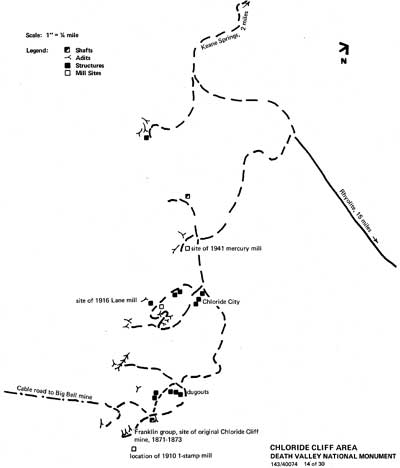
|
| Illustration 80. Map of Chloride Cliff Area. |
Part way down the cliff below this mine group stands the 1-stamp mill erected in 1910. There is very little evidence of a trail leading from the mine to the little mill, although a trail does descend from the mill site down into the ravine below. Remains of a primitive ore chute can be seen stretching from the mine about half way down to the mill site. The ore chute was obviously constructed of very cheap materials, and was used for a short time to slide ore from the mine down to the mill site. Several short exploration adits may also be seen along the trace of the ore chute. In addition, remnants of one inch pipe are scattered down the cliff side, tokens of the ill-fated effort to pipe water to the mill.
The 1-stamp mill itself is in excellent shape. Undoubtedly this is due to its inaccessibility, for anyone climbing the hill from the mill to the mine above would rue the addition of any extra weight. The mill machinery bears the markings of the Union Tool Company of Los Angeles, and the main support timbers stand twenty feet tall. The total lack of debris, waste rock or tailings around the mill indicate that it was briefly, if ever, used. When operations were abandoned at the mine above, only the engine and flybelt were salvaged. With a little oil, it looks as if the mill could run today, for virtually all its parts are intact.
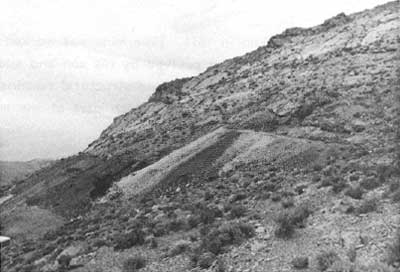 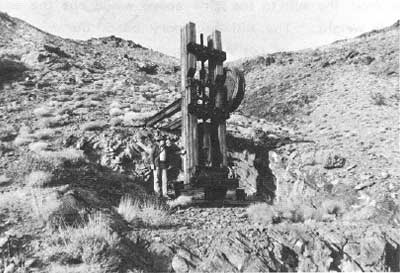
|
| Illustration 81-82. Top: Dumps of the Franklin Mine, site of the original 1871 discovery of silver ore. The floor of Death Valley, 5,000 feet below, can be seen in the background. Bottom: The one-stamp mill below the Franklin Mine, erected in 1910, but apparently never used. The Franklin Mine is over the top of the ridge in the upper background. The individual standing beside the stamp is six feet, two inches in height. 1978 photos by John Latschar. |
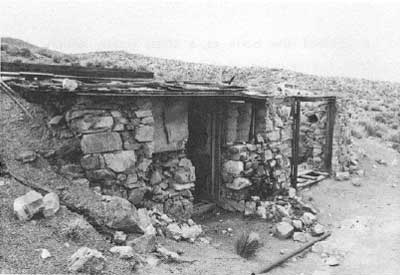 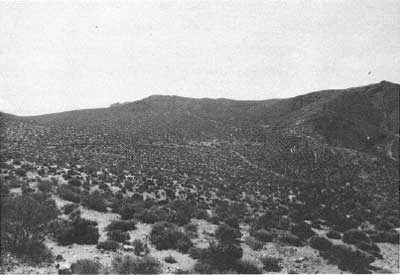
|
| Illustration 83-84. Top: One of the three dugouts located about one-half mile north of the Franklin Mine. This structure, which measures twelve feet by twenty feet, was divided into two rooms. The roof over the far room has been blown away, as the rocks which weighted down the tin roof had gradually disappeared. Bottom: Chloride City, viewed from the north. The town site itself was centered around the bare area in the center of the photo. The Franklin Mine is located on the south side of the ridge in the background, the 1916 Lane millsite is near the road visible in the right background, and the 1941 site mercury mill is to the right of the photographer. |
About one-half north of the Franklin. Mine is a group of three dugouts, obviously the homes of several miners during some stage of Chloride Cliff mining activity. The dugouts are lined up against the bank of a small wash, which shelters the structures from the ravages of the constant winds which sweep over the Funeral Mountains. The dugouts are constructed of native rock, stone, wood, and tin, and are in reasonably good shape. Although the historical data is unable to identify these dugouts with any particular phase of mining, bottles from a small dump down the wash date mostly from the 1930s, although some purple glass is evident. The relative intactness of these structures, one of which measures twelve feet square, and the others which are approximately twelve by twenty feet, would indicate that they were probably built in the 1930s.
The third major grouping of structures is the site of old Chloride City. The town at its height in 1906 contained no more than four wooden structures, but two dugouts and numerous tent sites may be found in the area. Chloride City died in late 1906, when the local mines shut down for several years, and when mining returned to the area in the 1910s and the 1930s, the remnants of the building were used for whatever purpose seemed necessary. The wooden structures are now all collapsed, and have been stripped of most of their lumber. The largest of these collapsed structures, which undoubtedly was the boarding house, measures twenty-four by thirty feet, and the rest are about eight by twelve feet in size. The area around the old town site is heavily covered by prospect holes, adits and dumps, and it appears that the major mining efforts during the 1905-06 period took place in the general vicinity of Chloride City. Near one of the old adits, just south of the town site, is the grave of James Mckay, who died at an unknown age, at an unknown time, and of an unknown cause. His gravesite, situated in the midst of a long-forgotten mining camp, seems like a symbolic "tomb of the unknown miner."
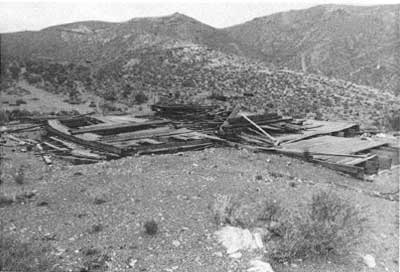 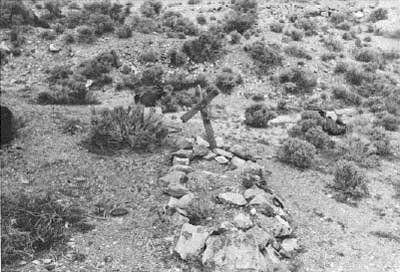
|
| Illustration 85-86. Top: Chloride City, showing the remains of the boarding house. Bottom: Grave of James McKay, located about a quarter mile south of Chloride City. 1978 photos by John Latschar. |
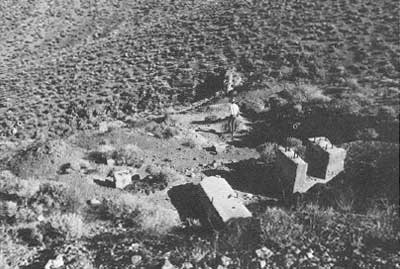 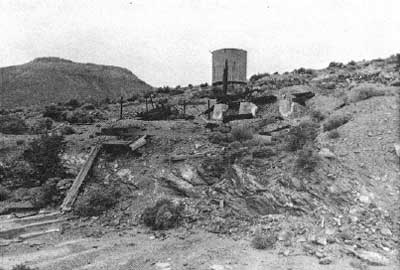
|
| Illustration 87-88. Top: Ruins of the 1916 Lane mill, located just southwest of Chloride City. Photo was taken from the dump above the mill, showing the remnants of several concrete pedestals. The mill tailings are visible to the right front of the person in the photo, and the stone wall built to contain those tailings are just above his head. Bottom: Ruins of the 1941 mercury mill, showing the water tanks, and several levels of workings. 1978 photos of John Latschar. |
To the southwest of Chloride City, across the top of a small ridge, is the site of the 1916 Lane mill, built by McCrea and his associates. The mill is built on a medium-sized mine dump. A water tank was positioned on the side of a hill across from the mill, site, and a four to six foot high stone wall was built below the mill, to prevent the tailings from being washed down the mountain. The mill site itself occupies an area about thirty feet square, but only concrete foundations and posts remain to mark the site. Several adits, a leveled tent site, a dugout and an old frame and tin shack may be found in the vicinity of the mill.
Finally, about a quarter mile northwest of Chloride City, is the site of the 1941 mercury plant. There are more physical remains to mark the site of this mill, for a galvanized water tank, extensive concrete foundations, and the ruins of a brick furnace are easily identified. Although erosion makes it difficult to judge, the amount of tailings around this mill would seem to indicate a life of several months before the complex was destroyed by fire.
In summary, the structural remains in the Chloride Cliff area include three mill ruins, several dugouts, several wood and tin shacks, and the collapsed buildings at Chloride City. Together with the proliferation of mine dumps, adits and shafts too numerous to describe, these remains present an interesting panorama of mining efforts carried out in this region between the 1870s and the 1940s. Although the total output of all the Chloride Cliff mines is estimated to be only $35,000 during all these years, the variety of efforts represented in the area, together with the identification of the original 1871 Chloride Cliff Mine, make this property eligible for nomination to the National Register as a historic district. In addition to the remains described above, the ruins of the Big Bell Mine, situated one mile southwest of Chloride City, will also be included in the Chloride Cliff Historic District. The Big Bell Mine itself is discussed in a subsequent chapter.
The entire Chloride Cliff area cries out for protection. At present, there, are no attempts being made to protect the valuable and fragile historic resources remaining at the area, and the combined efforts of motorcyclists, four-wheel drive enthusiasts, bottle-hunters, and general scavengers are fast destroying the area. At least one of each type was seen in the vicinity when the author was examining the sites. The area should be thoroughly posted and regularly patrolled to discourage and prosecute destructive users.
In addition to protection, the Chloride Cliff district also presents Death Valley National Monument with a unique opportunity to interpret mining from the 1870s to the 1940s. The area is perfect for a self-guided tour, with visitors wandering the wind-swept region, stopping at various unmanned interpretive sites to reflect upon its long and varied history.
3. Keane Wonder Mine
a. History
in December of 1903, two prospectors wandered into the Funeral Mountains on the east side of Death Valley. Like so many others, these two men were among the horde of prospectors scanning the deserts and mountain ranges of southern Nevada for gold, spurred on by the. fabulous riches discovered shortly before at Tonopah and Goldfield. What brought them to this particular area is unrecorded, but perhaps they had heard about the old Chloride Cliff Mine, which had operated briefly in the Funeral Range in the 1870s.
At any rate, the two prospectors, named Domingo Etcharren and Jack Keane, found an outcropping of silver ore in the northern Funeral Range in December of 1903. The two men worked their discovery for several months, attempting to trace the outcropping to a silver lode, but they were unsuccessful. Then, quite by accident, Jack Keane discovered an immense ledge of free milling gold ore a short distance from the original silver location. The discovery was aptly named the Keane Wonder, and represented Keane's first major strike after eight years of desert prospecting.
Like the 1870 operators of the Chloride Cliff Mine, which was located only two miles above the new Keane Wonder, Etcharren and Keane were dependent upon Ballarat for supplies. But unlike 1871, eastern California and southern Nevada were prepared for a gold rush in 1904, and when the two men came into Ballarat in May of that year for a rest and re-equipment, news of their strike touched off a genuine gold rush. Other prospectors rushed to the Funeral Mountains to get in on the strike, and promoters began to negotiate with Keane and Etcharren for the purchase of their locations. By late May, the strike was "confirmed--that is, other prospectors and experts in the employ of mining promoters had examined the site--and Keane and Etcharren began to receive offers to sell their eighteen claims.
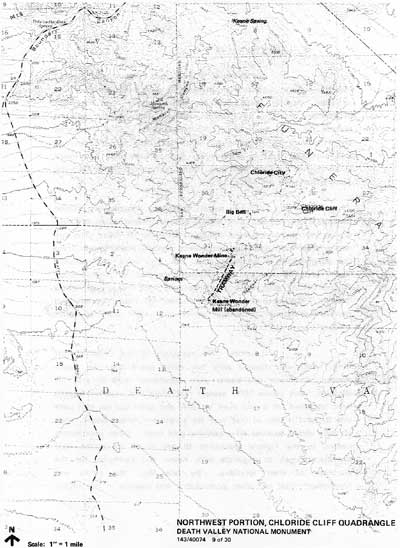
|
| Illustration 89. Map of Northwest Portion of Chloride Cliff Area. |
The two men, however, knew that they had something big, and decided to wait until the right offer came along. It did not take long, for within a few weeks the Keane Wonder was bonded to a well-known California mining operator, Captain J. R. Delamar. The terms of the bond called for Delamar to pay the locators $10,000 in cash immediately, for which Delamar obtained the rights to develop the locations for one year, with an option to purchase the mine at the end of that time for $150,000. The bond agreement was signed, sealed, and placed in the Inyo County Recorder's office on June 24, 1904, even though no one seemed to know for sure whether the mine was located in California or Nevada--a telling indication of the great lack of knowledge about the Death Valley region.
Delamar at once went to work, and shipped machinery and supplies to the mine. By the end of July he had thirty men working on the property. In the meantime, a decided rush was on to the Funeral Mountains, several other important discoveries had been made, and the Inyo newspapers reported that there "is a rush for the field from Ballarat and vicinity and pack jacks and canteens are in demand." By the end of July, one paper estimated that there were five hundred prospectors in the general vicinity of the new discovery. Two of these were "Shorty" Harris and Ed Cross, who were soon to discover the Original Bullfrog Mine. [9]
During the rest of 1904, Delamar's men feverishly worked the Keane Wonder Mine, racing against the one-year deadline to determine if it was worth the purchase price of $150,000. An assay office and a general office building were built at the site, and a wagon road was cut across the desert to within a mile of the mine, which was situated mid-way up the steep Funeral Range above Death Valley. By early 1905, their efforts to develop the mine were frustrated by the beginnings of the great rush to Bullfrog, which made horses and wagons almost impossible to obtain, and development work of necessity was slowed down. Nevertheless, enough teams were found to make the sixty mile haul from Ballarat, and fifteen men were still employed in driving two exploratory tunnels in March of 1905. The results of this work made the Keane Wonder look like a truly great prospect. "There is," reported the papers, "enough quartz in this mountain, and float, if it carries sufficient value, to run a 100 ton-a-day plant for twenty years."
By this time strikes were popping up all around the Keane Wonder. Stimulated both by it and the even greater Bullfrog strikes, literally hundreds of prospectors were swarming through the Funeral Mountains. In an effort to maintain some order and to record the numerous locations being made, the South Bullfrog District was soon created, encompassing within its boundaries and Keane Wonder Mine. Just to its north, the Chloride Cliff Mine had been reopened, the Big Bell had been discovered between the Keane Wonder and the Chloride Cliff, and numerous other mines began operations. Inevitably, these peripheral mines included one incorporated as the Keane Wonder Extension Mining Company.
As May 15th approached, when Delamar's bond on the Keane Wonder would expire, he started negotiations with Keane and Etcharren. In late April, he offered to buy the mine, but at less than the $150,000 stated in the bond agreement. Unfortunately for him, Keane and Etcharren had closely watched the development work done by his men during the past year, and they fully realized that they had a real mine on their hands. Such a thing happens only once in a lifetime, and they refused to accept a penny less than $150,000. Delamar either could not or did not want to pay that sum, and his option expired.
After Delamar's men left the property, Keane and Etcharren performed only sporadic work during the excessive heat of Death Valley's summer, while awaiting a new purchaser. They knew that their mine was too big for them to develop properly on their own, but all available investment money was being poured into the booming Bullfrog mines, and the Keane Wonder became almost forgotten. The two men, however, were patient and bided their time.
With the advent of cooler weather in September, Keane and Etcharren resumed work on their own. A small shipment of high-grade ore was sent to the smelter, and with the $28,000 which they received for it (which amounted to $1,867 a ton), they were able to employ a half dozen miners. Costs were comparatively low, since the mine could be worked through tunnels, thus avoiding the expenses of sinking and timbering shafts and hoisting the ore. With a bit of good luck, the shipment of occasional high-grade batches of ore would thus pay for the development of the mine on a small scale. With this plan in mind, the two men continued to work on their own through the remainder of 1905, employing five or six men, and waiting for the dust to settle around the Bullfrog boom, after which men with money would be able to see that their mine also had great potential. [10]
In early 1906, the prospectors' patience won out, as offers for the purchase of the mine were again made. L. L. Patrick obtained a bond for the property, similar to Delamar's of the previous year, with an option to purchase. Patrick immediately announced grand plans for the mine, including the erection of a 20-stamp mill at the foot of the Funeral Range, a mile from the mine and two thousand feet below it. Patrick and his men worked the mine for several months, while his engineers prepared surveys for an ore tram from the mine down to the mill site. But for an unknown reason Patrick decided not to exercise his option to purchase, and his bond expired in early March.
But by now promoters were standing in line for a chance at the mine, as soon as Patrick's bond expired, John F. Campbell and his associates jumped in. Campbell and his backers bought the Keane Wonder Mine outright, for a reported price of $250,000, $50,000 of which was paid to Etcharren and Keane in cash, and the rest given in form of stock in a company to be organized to develop the mine. The new company was incorporated in late March, with a capitalization of 1,500,000 shares. Jack Keane, who held a controlling stock interest, was elected president of the new company, with Campbell serving as vice president and Domingo Etcharren as secretary. The new company claimed to have forty to eighty thousand tons of gold ore on its twenty claims, and within a week, full page ads began to appear in the Rhyolite newspapers, offering stock for sale to the general public. The initial response was quite favorable, with Keane Wonder stock selling for 42¢ on May 4th, and 50¢ a week later.
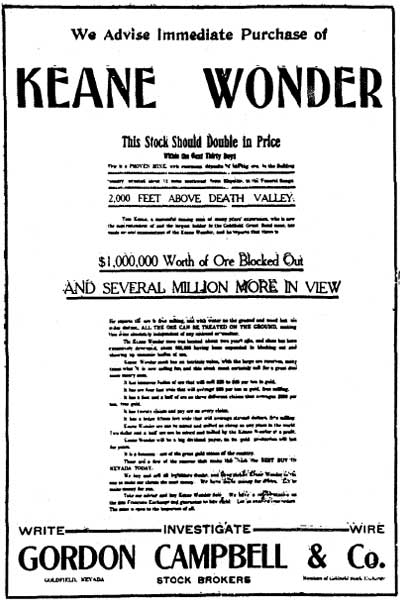
|
| Illustration 90. Rhyolite Herald, April 6, 1906. |
The new owners immediately resumed development on the property, and new ore strikes were soon made. Prospects looked extremely favorable for the company, for both wood and water were available within a reasonable distance from the mine, and the ease of tunnel mining indicated that development and extraction costs at the Keane Wonder would be relatively low. Within a short time the company had two mining camps established, one at the mine high on the side of the Funeral mountains, and the other located on the floor of Death Valley below. [11]
The Keane Wonder was by now receiving attention from papers as far away as Denver, Colorado. The mine had grown to twenty-two claims, comprising 240 acres of land, but even with the expenditure of $35,000 over the past year in development work, still only five of those twenty-two claims had been explored at all. But just when things looked brightest, disaster struck. The great San Francisco fire and earthquake of April 1906 effectively wiped out Campbell's fortune, which had an immediate effect upon the finances of the Keane Wonder Company. Development abruptly slowed down, and within a month reports were printed that Campbell was meeting in California with parties interested in buying the mine.
Campbell and his associates had no difficulty in finding a buyer. In late June, Homer Wilson, president of the Sildman Consolidated Mines Company of San Francisco, was in the Bullfrog District looking at various investment possibilities. On August 10th it was announced that Wilson and his associates had purchased the Keane Wonder Mine. The sale was heartily approved of by the local newspapers, which by this time had realized the financial distress caused Campbell by the San Francisco disaster. Wilson, who owned a string of mines in the Mother Lode country of California, was extolled as "one of the boldest and most successful operators" in California. The sale price was not released to the newspapers.
After several disappointments arising from previous sales, Jack Keane and Domingo Etcharren were now ready to sell out all their interests in the Keane Wonder, and this time they accepted full payment in cash, thus terminating their interests in the Keane Wonder Mine which they had discovered. Etcharren dropped completely out of sight and was never heard from again, but Keane's subsequent career can be sketchily traced. With the money from the sale of the Keane Wonder, Keane "who recently joined the ranks of those living on Easy street," invested in almost fifty claims in the Skidoo District on the west side of Death Valley. Within a few month's, however, Keane's luck turned sour. In September he was involved in a shooting affair in Ballarat, California, where after a night of drinking he wounded two local peace officers. Shortly after that he disappeared, to surface in Ireland in the fall of 1907, where it was reported that he was sentenced to seventeen years in jail for killing a man. The Rhyolite papers sadly commented upon this tragic end for one of the region's few lucky prospectors, but noted that when "drinking he usually resorted to his gun on very slight provacation." [12]
In the meantime, Homer Wilson and his associates went to work. The Homer Wilson Trust Company was incorporated, as a holding company for the Keane Wonder and other Wilson interests, and the new Keane Wonder stock was offered to the public. Advertisements in December of 1906 claimed that the first allotments of stock offered for sale at 50 per share had been oversubscribed in forty-eight hours, and that stock was now for sale from the company at 65¢ per share. Work was resumed at the mine in early November, and the company immediately ordered a 20-stamp mill and auxiliary equipment. The milling plant, announced Wilson, would consist of crushing by stamps, with amalgamation, concentration and cyanidation, and was expected to cost between $75,000 and $100,000. Wilson promised the press that his mill would be the first one in the Bullfrog region to begin operations.
Ten men started preliminary grading work for the mill buildings in early December, and plans were drawn for a gravity tram to bring the ore down from the mine on the mountain to the mill site in the valley below. By late December, mill machinery began to arrive over the new railroad, including an 85-horsepower Coreless oil burning steam engine, which would be used to power the mill. The aerial tramway from the mine to the mill was surveyed, and the company decided to install a Riblet gravity tram, 4,700 feet long, wherein the loaded ore buckets coming down the mountain would pull the empty ore buckets and supplies back up to the mine. By the end of December, construction on both mill and tramway was under way, and in addition twenty men were still employed in the mine. The company announced that it had $650,000 worth of ore blocked out, which would suffice to feed the mill for several years. [13]
As 1907 began, luck stayed with the Keane Wonder Mine, sometimes in almost unbelievable proportions. The mine continued to look well, for as more tunnels were driven, more ore was found. Then, when some men began sinking a well near the mill site below the mine, they struck another gold ledge instead of water. The well was immediately turned into another working shaft. Twenty-five men were employed by the company in early January, and the foundations for the mill buildings were excavated.
During February, more mill machinery and equipment arrived over the Las Vegas & Tonopah Railroad. The machinery contract had been let to the Risdon Iron Works of San Francisco, and Walter Lyons, formerly employed by the rival Union Iron Works of the same city was hired as construction superintendent. The Porter brothers of Rhyolite, after intense competition, won the contract to haul some 255 tons of machinery, timbers and supplies from Rhyolite over Daylight Pass to the mill site, twenty-six miles away. As February and March progressed, machinery and supplies continued to arrive with regularity, and the Keane Wonder Mill began to take shape. As the framework for the main mill building began to rise above the desert in early April, the price of Keane Wonder stock rose with it, for investors were impressed by the final resources and energetic management of Homer Wilson. Keane Wonder stock was sold for 75¢ in early April, and 80¢ late in that month.
As equipment arrived, mill construction took priority over development of the mine, and all available labor was put to work at the mill site. The framework for the mill building was finished in April, the ore bins were built and the mortar blocks set. More men were added to the payroll, which reached $3,000 per month. Final costs for the mill were estimated at $85,000. At the same time, a group of men were put to work on the water supply for the mill, which was being developed in several different spots. As a hedge, the Keane Wonder Company purchased Keane Springs, about seven miles away towards the top of the Funeral Range, as well as the young townsite at the springs. The company also bought up several claims adjoining its own, in order to obtain a right of way for its aerial tramway between the mine and the mill, bringing its total holdings to twenty-six claims, comprising some 450 acres. Arrangements were made to extend a telephone to the mill site, from the Rhyolite-Skidoo line. As construction proceeded, stock demand rose, but few shares were offered for sale. "The holders of this stock are evidently willing to wait for the dividends which seem sure to come within a few months," surmised the Rhyolite Herald.
By mid-May, all the mill equipment and machinery had arrived, and most had been installed. In addition, the company had finished the construction of a new boarding house at the mill site, to accommodate the construction crew and the. future mill crew. Then, in July, with the mill essentially completed, the construction crews were shifted to the building of the aerial tramway. This would prove to be a long and laborious task, especially with the intense heat of summer, but the Keane Wonder Company pressed on, for it was in a decided race with the Montgomery Shoshone Company of Rhyolite to see who would have the first running mill in the Bullfrog region. The Keane Wonder was at a disadvantage in the race, for in addition to building a mill, it was also required to complete a tramway and many other auxiliary features. For example, in mid-July, a huge 25,000 gallon galvanized iron tank was built beside the railroad tracks in Rhyolite, to be used as a storage tank for the crude oil which would be hauled to the mill site to fuel the plant. According to the Bullfrog Miner, "This is the largest tank of the kind in the country."
But the construction proceeded well. By late July, the tramway towers were beginning to arise along the ridgeside, and the company predicted that the mill and tramway would be completed by September 1st. In the meantime, some miners had been put back below ground, and another strike of ore almost immediately resulted. Delays on the delivery of the huge tramway timbers slowed construction for a while in July and August, but other construction continued. The water and crude oil tanks at the mill were completed in early August, and the timbers for the tramway were laboriously dragged up the mountainside. Twenty-one thousand board feet of lumber were required for the upper tramway terminal, 28,000 for the lower, and 25,000 for the intermediate towers. The tramway had thirteen towers, with the longest span between them being 1,200 feet, and the vertical fall from top to bottom was 1,500 feet. During the height of tramway construction, the Keane Wonder Company employed no less than five mill wrights for framing the timbers for the terminals and tramway towers. Each tower rested upon a foundation measuring twenty-four feet square, in many cases blasted out of solid rock.
Despite the 105 degree temperature at the construction site in mid-August, the workers toiled on, with most work being accomplished during early morning and late evening hours. Finally, on September 14th, the last load of equipment for the towers was hauled out to the mill site, making a total of 1,500,000 pounds of freight which had been hauled from Rhyolite during the course of construction at a cost of $11,000.
Work was delayed somewhat in mid-September, when several men quit, stating that the food served at the Keane Wonder boarding house was "absolutely the worst ever put before a crew of working men on the desert." Mrs. Hull, the company cook, took exception to the accusation, and replied that "the provender is good and the parties making complaints are soreheads." Nevertheless, new men were found, and construction continued. In early October the tramway cable was stretched, and only the hanging of the buckets remained for the tramway to be completed. Homer Wilson arrived in town to witness the first days of the mill tests, and also to award a contract to the Porter brothers of Rhyolite for the transport of crude oil from the storage tank in Rhyolite to the mill site. Two tank wagons, holding twenty-one and twenty-seven barrels respectively, would make nine trips each per month, in order to satisfy the demands of the big steam engine. The tank wagons, which were owned by the Keane Wonder Company, were special heavy duty Studebaker models.
Finally, in late October, everything was ready for the machinery to be turned on for the first time. Homer Wilson, in an understandably pleased mood, told reporters that he hoped the 80-ton capacity mill would turn out $1,000 worth of gold per day when running at full speed. All mill tailings, he said, would be impounded, for the company expected to add cyanide tanks within a year in order to rework the tailings and thus extract the utmost in gold savings. In the meantime, the miners had 2,000 tons of ore broken down in the mine, ready to feed the mill. But due to the Panic of 1907, which had just hit the Nevada mining fields, Wilson was forced to make an emergency trip to Goldfield on October 27th, the day that the Keane Wonder Mill began to operate.
For the next month, everyone involved held their breath, waiting to see if the huge investment in labor and equipment would pay off. The equipment was turned slowly at first, as constant checks were made for defects in the machinery, and only forty tons were treated per day. But all the equipment worked well, and soon the tonnage was increased. On November 11th, the first bars of gold bullion were brought into Rhyolite, the result of the first three weeks run, and were estimated by one local paper to be worth $40,000. That figure was undoubtedly exaggerated, however, for the Keane Wonder Company did not announce its production figures, and another paper estimated the total output for all of November at only $25,000. But regardless of figures, the tramway and mill were evidently working well, and the company formally invited reporters and interested miners to visit the site and take a ride in its tramway.
In early December, a Rhyolite Herald reporter made such a visit. The mill was now running twenty-four hours a day, he reported, and was treating seventy to seventy-five tons per day. The ore being treated at the mill averaged $18 to $20 per ton, and the present mill equipment was saving 65% of the gold content. The tailings, which were being saved for later cyanidation, assayed at $3.95 per ton. Homer Wilson estimated the known ore reserves at 100,000 tons, and development work in the mine was increasing that figure faster than the mill could reduce it.
The ore bin at the upper tramway had a capacity of 100 tons, and an especially unique feature. Power from the gravity pull on the tramway was used to operate a preliminary ore crusher at the upper terminal, through which the rock passed before descending to the mill. In addition, a supplementary 13-horsepower gas engine was installed on the upper tramway terminal, so that the ore crusher could be operated when the tramway was idle. The tramway was supported by twelve towers and one breakover station. The highest tower was thirty feet, the lowest eighteen. The longest span between towers was 1,280 feet and was 500 feet above the floor of the canyon below. Each ore bucket on the tramway carried 600 pounds, and was loaded automatically. The material for the tramway included 95,000 board feet of timber and fifty tons of wire rope and terminal material, and the tramway rose on a grade of 1,000 feet per mile.
The ore buckets dumped automatically into the mill bin at the lower tramway terminal, which had a capacity of 200 tons. From there the ore passed onto suspended Risdon feeds, and under the Golconda pattern batteries, whose twenty stamps weighed 1,000 pounds each and dropped 100 times per minute. Inside amalgamation was by back plate and chock block with the ore passing from the screens onto a lip plate, and then falling into distributing pots and onto the apron plates. From the plates the pulp passed into the amalgam trap, and the sands went to the original classifier, with the coarse sands sent to two Wilfleys vanners and the fine sands to four Johnson vanners. Tailings were pumped into four Callow tanks, each eight feet in diameter, where 75% of the water was secured and pumped back into the tanks for use in the stamps. The tailings were impounded in dams and allowed to settle, with remaining water again recycled back through the mill. The amalgam was retorted and melted at the mill and finally converted into gold bullion.
Water for the mill was drawn from a well shaft 285 feet from the mill, and was pumped into a tank above the mill by an artesian pump. The mill itself was driven by a Corliss steam engine, with steam generated in a 126-horsepower Sterling boiler. The exhaust from the engine was used to heat a 100-horsepower Cochrane feed water heater, which heated the water to 210 degrees, thereby driving off the soda and other minerals which would have clogged the boiler. Crude oil was used to fire the boilers, and the works were lighted by electricity generated at the mill site.
The mill building was framed, and covered with galvanized iron. All the floors were concrete, with concrete foundations, mortar blocks and retaining walls. The tramway materials were from the Leschen Brothers & Company, a St. Louis outfit specializing in aerial tramways. Over forty different designs and combinations, said Wilson, were studied before the company finally decided upon this arrangement. Finally, the reporter concluded, the Keane Wonder Company had a fine camp established at the mill site, where Mr. and Mrs. Wilson lived. Other families included those of Vice-president and Mrs. Rogers, and mill superintendent and Mrs. Lyons. The Kimball brothers had established a twice-a-week stage line between Rhyolite and the mill, to satisfy transportation demands. [14]
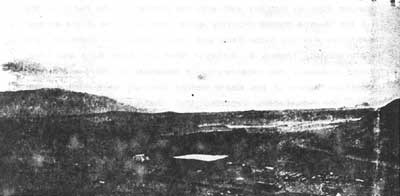
|
| Illustration 91. The left half of the Keane Wonder Mill complex, which should be matched with the opposite photo. Note the piles of lumber and other materials, which would soon be used for the support buildings of the mine complex, the two small tent structures, and the large storage building. The cyanide plant, which would be built several years later, would stand on the slightly higher ground behind the large storage building. Photo from the Rhyolite Herald, 6 December 1907. |
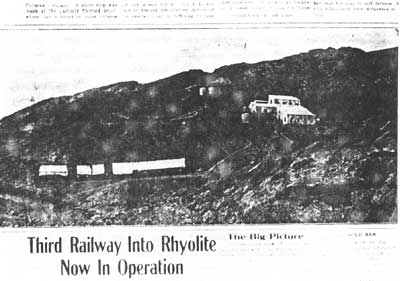
|
| Illustration 92. The new Keane Wonder Mill, as photographed for the Rhyolite Herald in December of 1907. Although it is not a very good picture, it is one of the few remaining. The basic mill buildings have just been completed, but none of the support buildings, such as the building which later covered the lower tramway terminal (which is located behind the mill), have yet been erected. The tent houses in the foreground were boarding and bunk houses. |
But despite the excellent success of the Keane Wonder Mill, all was not well with the company. The Panic of 1907 hit the Nevada mining industry quite hard, and one of the earliest casualties was the State Bank and Trust Company of Goldfield, and its president, Thomas B. Rickey. When the State Bank and Trust failed and went into receivership in November of 1907, the effects upon the future of the Keane Wonder Company were made evident when the newspapers reported that the bank had loaned the company $200,000 for the construction of its mill and tramway. President Rickey promised that the loan would be made good, but as the Inyo Register pointed out, "The Keane Wonder is now practically owned by the State Bank and Trust Company," and the future of the company's finances was much in doubt.
But while waiting for the financial picture to become clearer, the Keane Wonder Mill continued to produce. It is difficult to give a reasonable estimate of mill output, since Homer Wilson was not in the practice of announcing bullion figures, but we do know that the mill was working steadily. Wilson brought in a bar of gold bullion to Rhyolite on December 7th, the result of twelve days' run, and the papers estimated its worth at around $16,000. Another gold brick was brought in on December 21st, estimated at $6,000. As a unique feature of the Keane Wonder operation, the gold bullion was shipped to the mint, which processed it and shipped back gold coins to the company, which were used to pay the Keane Wonder employees. The mill was still not running at full capacity by the end of 1907, due to difficulties in obtaining enough of a water flow to satisfy the mill demands. Average daily runs through the latter part of 1907 averaged seventy-five tons per day. But still, based upon a compilation of the more conservative newspaper estimates, the Keane Wonder Mill produced around $36,000 in gold bullion in 1907. [15]
As 1908 opened, the Keane Wonder Mill continued to produce, although the lack of an adequate water supply kept the mill from running at full capacity. Bullion estimated at $15,000 was brought in or January 9th, and another shipment estimated at $8,000 was sent to Rhyolite on February 5th. Even without being able to run full time, the mine and mill seemed to be operating most efficiently, for the entire costs of mining, traming and milling the ore was put at a mere $3 per ton. This efficiency, of course, was greatly helped by, the fact that the soft rock being mined at the Keane Wonder was being pulled out of horizontal tunnels and stopes, which alleviated the costly necessity of sinking and timbering shafts and of installing and operating hoisting machinery.
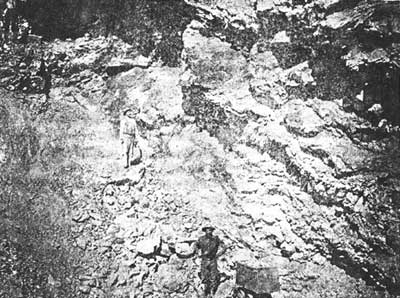
|
| Illustration 93. View of one of the working faces of the Keane Wonder Mine, showing the ease of mining. The ore at this point could be stripped directly off the face of the cliff, which saved the company thousands of dollars over the costs of tunneling, shafting, and timbering. From a booklet, "Bullfrong Mining District," published by the Rhyolite Chamber of Commerce, 1909. |
As could be expected, the troubles of the State Bank and Trust Company, which received wide publicity, caused a number of rumors to circulate concerning the Keane Wonder Company. The Inyo Register reported on February 13th that the mine and mill would close, due to those complications, but Homer Wilson hotly denied the rumor, stating that the mine had ore reserves sufficient to supply the mill for two more years. Two days later, as if to prove his point, Wilson brought in another gold brick estimated at $4,000.
By late February, the newspapers were able to begin untangling the affairs of the Keane Wonder Company and the State Bank and Trust. The Rhyolite Daily Bulletin reported that T. B. Rickey, the former president of the bank, had personally taken over the debt of the Keane Wonder Company to the bank, which amounted to $195,000. Since Rickey was also a heavy stockholder in the Keane Wonder Company, this seemed to bolster the future of the mine, for such a move would enable the Keane Wonder to avoid the long drawn out receivership settlement affecting the bank and all those connected with it. Further good news followed, for the discovery of an additional water source enabled the mill to begin running around the clock in late February. It immediately began to treat almost 80 tons per day, near full capacity, and Homer Wilson brought in another gold brick on March 5th, estimated at $7,500, bringing February's production to an estimated $15,000.
Further bullion shipments were made later in March, as an estimated $5,000 was brought in on March 19th, and another $1,700 on March 28th. A short time was lost for minor repairs, but the mill continued to function well. In late March, Homer Wilson, realizing that the continued rumors connecting the State Bank and Trust Company with his mine were having a detrimental effect, granted a long interview to a reporter from the Rhyolite Daily Bulletin.
The Keane Wonder, he said, had two years of ore supplies already blocked out, and further development work would undoubtedly increase those known ore reserves. The average ore in the mine, like that which had already been run through the mill, was around $16 per ton. The company would soon begin the construction of a cyanide plant to treat the mill tailings. At present the mill, without cyanidation, was saving about 62 percent of the ore content, and the addition of a cyanide plant would increase that savings ratio to 92 percent. When the plant was completed, Wilson hoped for a monthly production of $25,000 from the combined works.
Water shortages, however, were continuing to plague the company. Even with the addition of a new water supply, and with the unusual recycling arrangements built into the mill, full time operation was impossible. Thus the mill had settled into a schedule of twenty-four hour operation for four days, followed by sixteen hours for the next three, while the water supply was built back up.
Concerning the rumors connecting the mine and the bank, Wilson was most specific. The finances of the Keane Wonder Company, in his opinion, were in good shape. With the output of the property the last three months the company had paid off every cent of its indebtedness, and would be able to begin paying dividends the next month--unless, of course, such profits were put back into the expansion of the facilities, such as a new cyanide plant. The Keane Wonder Company, said Wilson, had absolutely no connections or entanglements with the State Bank and Trust Company. The mine did not owe the bank a penny, and whatever troubles Mr. Rickey was having involved only his personal stock in the Keane Wonder, and not the company itself. Rickey and Wilson together owned 875,000 of the 1,500,000 shares in the Keane Wonder, and whatever happened to Rickey's portion of those shares would have no effect upon the mine itself. In addition, the company still had 350,000 shares of treasury stock. These shares, which the company had never put on the market, could be sold at any time when the company faced financial difficulties. In summary, Mr. Wilson quite candidly put his mine into perspective. "We have not got what may be called a big mine or a high grade mine," he said, "but a nice little proposition that will clear good and dependable money every month in the year, and from the looks of things, for many years hence." [16]
April proved to be another good month for the Keane Wonder. Homer Wilson brought in three gold bricks estimated as being worth $30,000. The output for future months looked even better, for during April yet another source of water was located, which the company said was sufficient to supply a 60-stamp mill. Pipe line and pumping machinery were ordered, for the new water supply was 3,500 feet from the mine and 100 feet below it. Work on the cyanide plant, the company announced, would begin after the new pipe line was laid.
In addition, new ore bodies were discovered in the mine, which increased the company's ore reserves. Some of the new ore was high grade, and was called the best discovery in the history of the mine. Homer Wilson essentially agreed with that assessment, and stated that there "is perhaps enough ore in sight to wear out the 20-stamp mill that we now have in operation on the property." Even the announcement that a disgruntled stockholder named E. H. Widdekind had filed suit in the Esmeralda county district court, asking for a receiver to be appointed to the Keane Wonder Company, failed to dampen the enthusiasm surrounding the mine. Widdekind alledged "all kinds of crooked work," chiefly that Wilson had appropriated large amounts of the company funds to himself, but no one seemed inclined to believe the accusations.
During May, the mine and mill continued to produce, with an estimated total of $21,600. The decrease in bullion was due to continuing water difficulties, as the heat of summer cut down on the available water supply. Material for the new pipe line, however, was delivered in late May, and the company hoped to solve that problem shortly. But delays began to plague the. company in June. Leaks in the new pipe line delayed its utilization, although pumps and even a windmill was installed at different water sources. Still the twenty-five employees of the mine and mill managed to produce an estimated $15,200 during the month, with the mill running only about half the time. The long awaited cyanide plant was not yet started, due to the water problems.
In July, the extreme heat of Death Valley's summer began to take its toll. At the end of that month, the company announced that temperature had not been below 90 degrees for weeks, and was often above 124 even at midnight. Daily temperatures were usually up to 112 by breakfast and 124 by noon. Most men slept out of doors, and even eating was difficult, since the silverware was often too hot to handle. The boarding house cook flatly refused to allow a thermometer near his kitchen. The hot weather kept the water at near boiling temperatures, which made mill operation difficult. Still, over $11,000 was produced that month, and the ore reserves were enlarged. In addition, three new buildings were added to the camp, including a sixteen by forty-two foot residence for Homer Wilson and his family, a two-room office building and a new cook house. [17]
In August, a peculiar side-effect of the labor struggles currently running through Nevada hit the Keane Wonder. Early that month, the Rhyolite Miners Union adopted the Tonopah scale of wages, designed by the Nevada miners unions to set standard pay scales across the state. The Keane Wonder Company soon announced that it would honor the new scale. Unfortunately for its employees, the Keane Wonder had formerly been paying higher wages than the scale called for, and the move meant that the average miners' wages were cut from $5.00 to $4.50 per day. When the company announced the new rates, along with only a 25¢ reduction in the daily room and board charges, twenty men quit the mine. Wilson, however, had no trouble in hiring additional men, and even the former foreman of the Keane Wonder Mine, who quit on principle, told the papers that the Keane Wonder was "unquestionably one of the greatest mines in this section of the country."
Thus production and development went on, and in late August Wilson announced that the "biggest strike in the history of the Keane Wonder has just been made," when over eighteen feet of high grade gold ore was uncovered. In addition, some of the water problems were resolved, and in spite of the continued heat, average mill days of twenty hours were possible. Partly to alleviate the heat and discontent of his miners, Wilson made arrangements to put in a small ice plant at the mill.
Production in August was estimated at $14,000 worth of gold bullion.
In late August, the Mining & Scientific Press, the esteemed San Francisco mining journal, printed a quite reasonable assessment of Keane Wonder mine, although it was not one designed to endear that paper with local boosters. "Death Valley has one actual mine," wrote the paper. "It is the Keane Wonder, a wonder if for no other reason than that it is the only producing property of the region. While not a bonanza, it is paying. Forty miners are busy supplying $20 ore for a 20-stamp mill. Now and then a gold bar finds its way to Rhyolite, and figures in the press dispatches . . . ."
A week later, the Keane Wonder found itself in yet another national magazine, when the Engineering & Mining Journal printed an assessment of the suit of Edward Widdekind against Homer Wilson. In essence, Widdekind claimed that he had once held an option on the mine, and that Wilson had illegally manuevered him out of the deal. In addition, he charged that through complicated and shady stock transactions, Wilson had pocketed some $100,000 of the mine's money. He asked that a receiver be appointed while the case was heard, and also asked for half of Wilson's stock which he claimed was due according to their original agreement.
Wilson ignored the allegations and continued to supervise the work at the mine and mill. The easing of the summer's heat helped with the water problems, although they were still not completely solved, and the Rhyolite Herald estimated September's production at $13,000. In the meantime, the stockholders of the company met in Phoenix and ratified several actions of the board of directors, among which were the election of two members of the Thomas Rickey family to positions on the board. [18]
In October, the full extent of the financial troubles of the Keane Wonder Mining Company in relation to Thomas Rickey and his defunct bank became apparent. The Rhyolite newspapers had attempted to stay clear of the turmoil, but the much more aggressive Goldfield papers gave them full coverage. According to one, the Goldfield Chronicle Rickey was a financial manipulator of the first order. Even today, sifting through the accusations of the papers and the statements of the individuals involved, it is difficult to piece together the financial puzzle. Someone, it is evident, had borrowed money for the Keane Wonder to use from the State Bank and Trust Company, and had pledged several hundred thousand shares of Keane Wonder stock against the note. When the bank failed, Rickey had personally taken over the responsibility for that debt, which indicates either that he had borrowed the money from his own bank in the first place, or that he was trying to protect the Keane Wonder Company, of which he was a heavy stockholder, from the results of his bank's failure. Along with the debt, Rickey had also taken from the bank vaults the Keane Wonder stock which the bank had held as a lien against the debt.
But other interests felt that they had first call on the stock of the Keane Wonder. One such was D. Mackenzie, president of the Francis Mohawk Company of Goldfield. His company had lost a large amount of its deposits when the State Bank folded, and Mackenzie claimed to have exchanged his company's claims against the defunct bank for the bank's claims against the Keane Wonder. Thus Mackenzie felt that the Francis Mohawk Company had first rights to the stock which the Keane Wonder had left in the State Bank as security for its loan. Mackenzie wanted to hold that stock, which would force the Keane Wonder to either repay its debts to the Francis Mohawk, or to come under the control of the latter company.
But according to the Goldfield Chronicle Rickey had played yet another trick.
Rickey and his ubiquitous and perpatetic attorney, J. F. Peck, put their heads together. They conceived the idea of having the company make a short time note for some of its indebtedness and mortgage the company's mines and mill as security for its payment. So they called the stockholders together at Phoenix, Ariz., on August 22 last. A note for $43,000 was made to the Rickey Land and Cattle company, and to secure it a trust deed conveying all of the company's magnificent holdings to Peck was delivered to that individual. This note will fall due on Sunday, the 25th day of this month, and on that day Peck can, under the terms of a trust deed, for the comparatively paltry sum of $43,000, sell the mine, the aerial tram, the mill, Keane Springs--in a word, gut the Keane Wonder Mining company to its last farthing.
Homer Wilson denied the "sensational story from Goldfield," but did little to clear up the confusion, since he refused to comment upon the details of the Keane Wonder's financial picture. He did, however, intimate that a reorganization of the company was imminent, and he pledged to protect the interests of everyone concerned. "You can say for me," he told the Rhyolite Herald that if I don't get killed in this matter, every stockholder in the Keane Wonder Mining Company will be fully protected." Wilson also stated that he knew for sure that Rickey had no intention of foreclosing on the company and with that, left for San Francisco to try and straighten out the mess.
In the meantime, the Keane Wonder mine and mill continued to hum along, and October's production was estimated at $15,000. Although the company was continuing to try to find a solution to the water problem, the mill was still unable to run full time. But even with good production figures, the uneasiness about the various court suits involving the company had a disasterous effect upon its stock, which plummeted all the way to 8¢ per share by mid-October. Stockbrokers, even when taking into account the various rumors concerning the mine's future, could not understand this climatic fall. How, asked one, can stock in a mine which is producing an average of almost $20,000 per month fall to such a ridiculously low figure?
Despite these financial questions, Homer Wilson seemed to be sure that his property would survive intact, and work proceeded normally. Gold bullion was regularly brought into Rhyolite during November, and production for that month was estimated between $16,000 and $25,000 by the Rhyolite newspapers. In the meantime, the Nevada-California Power Company began negotiations with the Keane Wonder to extend a branch line to its property, and the company finally began preliminary grading work for the future cyanide plant. The payroll was increased to fifty miners and millmen. A well respected mining engineer made a thorough examination of the mine for Wilson and reported that the Keane Wonder was "one of the greatest mines in the state, and one capable of much better results than even the great showing it has already made."
But at the same time, the various lawsuits surrounding the Keane Wonder and the State Bank and Trust grew more complicated. Early in November, D. Mackenzie was granted a temporary injunction preventing Rickey from foreclosing on the Keane Wonder for his $43,000 trust deed. A week later, Mackenzie and F. L. Wildes brought joint suit against Rickey and Homer Wilson, charging that they were using the mine to further their personal interests. The suit asked for a restraining order, and that the company be put in the hands of a receiver, in order to protect the stockholders of the Keane Wonder as well as the stockholders and creditors of the State Bank and Trust Company. Wildes, who was the bank examiner for the state of Nevada and also the appointed receiver of the State Bank and Trust, claimed that the large stock holdings of Rickey in reality belonged to the assets of the bank, and thus should be returned to it, for division among the banks creditors and stockholders.
But in mid-November, when the case was heard, the decision was decidedly in favor of Wilson and Rickey. The complaints were ruled out of order, and the judge remarked that he "failed to see wherein a receivership would be justifiable, when the Keane Wonder company is doing business, meeting its bills and making a profit upon its operations." In reporting this decision, the Rhyolite Herald continued to extend its sympathy towards Homer Wilson, and printed his version of the complications. The Keane Wonder Company, according to Wilson, was not indebted to the State Bank and Trust company. Its only indebtedness was to Rickey, in the form of the trust deed for $43,000, which had been extended to help cover the costs of mill construction. The complications surrounding the 975,000 shares of stock held by Rickey and Wilson were merely personal matters between Rickey and D. Mackenzie, and Wilson hoped that Ricky would resolve these soon, in order to enable those treasury shares to be returned to the control of the company. Other people, however, were not so trusting of Rickey as was Wilson, especially after the Inyo Register printed a rumor that Rickey was selling out his real estate interests in the Reno area, and transferring his funds to Germany. [19]
Whatever the case, the legal complexities settled down for several months, and Wilson was able to return his attention towards production and the construction of the new cyanide plant. In early December, Wilson announced that the machinery for that plant had been assembled at Los Angeles and was being shipped. Construction, with good luck, would be completed by February 1st. The plant would have eleven tanks, including six 25-foot diameter leaching tanks, each five feet tall, two 18-by-10 foot solution tanks, two 12-by-10 foot settling tanks, and one wash water tank. Zinc boxes would also be installed, with the equivalent capacity of another tank. When completed, the plant would be able to process a minimum of 100 tons of tailings per day, although the company hoped that the capacity would reach 200 tons. With a capacity of at least 100 tons at the cyanide plant, compared with the maximum 80-ton daily capacity of the mill, the cyanide plant would spend the rest of its time processing the 20,000 tons of tailings impounded from the mill during the previous years of mill operation. Thus it would be several years before the cyanide plant ran out of work.
In the meantime, development in the mine continued apace. Although Homer Wilson rarely gave out ore reserve figures, one of his shift foreman told the Bullfrog Miner in early December that the Keane Wonder mine now had a three years ore reserve in sight. Production at the mill proceeded fairly smoothly during December, despite a rare snowfall in the middle of the month, accompanied by a drop of. the thermometer to 36 degrees, the lowest anyone could remember. Final production figures for that month were $12,000, an estimate for once agreed upon between the Rhyolite Herald and the Bullfrog Miner. Total 1908 production, according to figures released by Wilson, amounted to $140,092.37. Average monthly production, based upon Wilson's calculations, was $11,674, which indicates that both Rhyolite newspapers had been overestimating production figures throughout the year. $140,000 was enough, however, to mark the Keane Wonder Mine as the largest producer of gold in the county of Inyo, California, during 1908, which emphasizes its relative importance to the local economy. The Engineering & Mining Journal ironically noted that "judging by the complicated litigation over the stock of the Keane Wonder Mining Company, it out to be a good property."
With the law suits thrust to the background through the early months of 1909, the Keane Wonder mine and mill continued to grind out ore and bullion. January's production was estimated at between $13,400 and $15,000, and February's at $13,000. No production estimates are available for March, but Homer Wilson announced on the 24th of that month that the mill had produced $35,000 during the first three months of 1909. Mine development continued apace, and "though nothing of a sensational nature has been uncovered, yet the steady and consistent advancement made in the showing of mineral wealth justifies the official statement that the property never looked so good."
During this period, construction of the cyanide mill finally began. The first carload of machinery for the mill arrived in early January, and more supplies and equipment followed. By the end of February, the mill was virtually completed, and test runs began. Delays in the delivery of some items of equipment, however, kept the new mill from entering full production runs until March 18th. Although Wilson admitted that it would take several months to determine the full capacity of the plant, which depended upon the always unreliable water supply, he hoped that the addition of cyanide treatment would increase the company's production by 80 percent, to around $20,000 worth of bullion per month. With the cyanide mill in operation and the stamp mill and mine looking good, Wilson again extended open invitations to reporters and miners to visit and inspect his complex. The visitors were also invited to take a ride over the aerial tramway, "provided they assert that they are not afflicted with heart disease." [20]
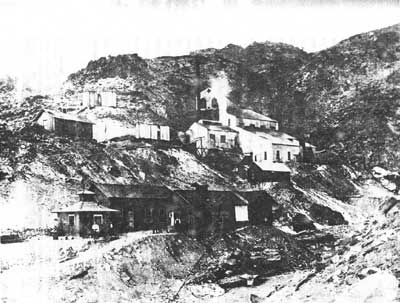
|
| Illustration 94. The Keane Wonder Mill, at the height of its activity, in March of 1909. Note the new buildings erected since 1907, especially the lower tramway terminal building, with its two distinctive horseshoe openings, above the mill. When the mill was salvaged in 1937, the tramway building was left, and today its framing timbers are the dominant feature of the Keane Wonder mill ruins. Photo courtesy of Stanley Paher collection, copy from Death Valley National Monument Library. |
But in April, the complicated financial affairs of the Keane Wonder Company again spilled into the courts. Sometime during the early part of 1909, T. B. Rickey and D. Mackenzie, the former antagonists, had made a deal, whereby Mackenzie dropped his claims against the 975,000 shares of Keane Wonder stock. In return Mackenzie received a new joint trust deed with Rickey for nearly $195,000. The new trust deed also replaced Rickey's older trust deed of $43,000. The deal enabled Homer Wilson to regain control of the commanding block of Keane Wonder stock, if he could meet the interest obligations of the new trust deed.
But due to financial demands for the construction of the cyanide mill, Wilson failed to meet the interest payments, and Rickey and Mackenzie advertized the entire property of the Keane Wonder Company for sale in order to satisfy their demands. Earl Clemens, the publisher of the Rhyolite Herald then entered the fray on behalf of minority stockholders of the Keane Wonder Company, asking for a restraining order on the sale of the Keane Wonder property, and also for a thorough accounting of the finances of the company. Clemens' motive was to protect the minority stockholders, who would be left holding worthless stock if the mine were sold to satisfy the trust deeds, and also to help clear up the tangled affairs of the Keane Wonder, since the continued active production of the mine was important to the prosperity of Rhyolite and the Bullfrog mining area.
Clemens' first moves were successful, for an injunction was granted by the Superior Court at San Francisco, forbidding the sale of the mine under the terms of the new trust deed until a full accounting could be produced before the court. Apparently, the judge tended to agree with Clemens that the personal indebtedness of Homer Wilson and the Homer Wilson Trust Company, which had originally promoted the Keane Wonder Mine, should be entirely separated from the legal debts of the Keane Wonder Mining Company itself. Clemens claimed that although the personal debts of Homer Wilson and his Trust Company could amount to as much as $150,000, that the only legal debt of the Keane Wonder Company itself was the $43,000 owed to T. B. Rickey. The picture was extremely complicated, for it was very difficult to sort out the personal and the public debts of Homer Wilson vis a vis the Homer Wilson Trust Company and the Keane: Wonder Mining Company. Likewise, it was just as difficult to delineate between Thomas Rickey's personal and public debts, since he was a major stockholder of the Keane Wonder and also the former president and major stockholder of the State Bank and Trust Company. The key to the puzzle was whether the trading between Wilson, Rickey and Mackenzie for the famous 975,000 shares of Keane Wonder stock was done by private individuals or by company officials. Clemens, at least, was certain that all the dealing had been done by the three men acting as private individuals and if the court accepted his interpretation, then the Keane Wonder Mining Company itself would emerge from the entire affair virtually debt free.
Later in April, another favorable aspect came into the picture when F. L. Wildes, receiver of the State Bank and Trust Company, entered the suit with a motion to force both Rickey and Mackenzie to return their stock to the assets of the bank, from which he said it was illegally obtained. This suit, if successful, would mean that Homer Wilson would have to return the 975,000 shares of treasury stock to Mackenzie and Rickey, which would void the new trust deed held by those men. Mackenzie and Rickey would then in turn be forced to return all that Keane Wonder stock to the bank, which would parcel it out among all the former shareholders and deposits of the failed bank. This would leave Rickey and Mackenzie with no claims upon the Keane Wonder Mine.
Although the rest of the story is not quite clear, since much of the private maneuverings and court proceedings did not reach the ears of newspaper reporters, final settlements were made in late May. Apparently the accounting requested by Earl Clemens resulted in a favorable decision for the Keane Wonder Company, and the court found that all the dealings involving the 975,000 shares of treasury stock were private contracts between individuals, for which the Keane Wonder Company could not be held responsible. As a result, bank receiver Wildes dropped his suit to obtain those shares of stock, and Homer Wilson retained them in trust for the company. Mackenzie, as a result of this suit, lost all his claims towards the Keane Wonder stock, and Thomas Rickey's original trust deed, which was reinstated by this court decision, was paid in full by an affluent Keane Wonder stockholder. Thus it appeared that the Keane Wonder Company was free and clear of any outstanding debts. As the Rhyolite Herald happily wrote, the "honesty of Homer Wilson" had been upheld, since he had made good on his promise to protect the company's stockholders.
In the meantime, the mine and mill had kept on producing. On April 19th, Homer Wilson brought in bullion worth $25,000, the result of one month's cleanup at the mill and new cyanide plant. The production was the largest ever in the Bullfrog region for one month, with the exception of the Montgomery-Shoshone Mill at Rhyolite. On May 19th, Wilson brought in more bullion estimated at $18,000, the result of twenty-one days' work, as the mill pushed towards the magic figure of producing $1,000 per day.
Other developments kept pace. A new body of ore was found in the mine on May 22d, and the long awaited ice plant was completed ate that month. All the miners and millmen now had resource to free ice supplies to help alleviate the heat of summer. A new hoisting plant was ordered and when received was put to work on another shaft. The Keane Wonder Company now had a total of twelve power plants ranging in size from the 150-horsepower steam boiler and the 126-hp steam engine down to a 25-horsepower gas engine, two 13-horsepower, two 10-horsepower, two 5-horsepower, and three 2-1/2-horsepower gas engines. [21]
As the summer progressed, it seemed that the Keane Wonder had only been awaiting the settlement of all its financial difficulties before making great surges forward. May's production continued to push towards the $1,000 per day mark, as bullion worth $22,000 was brought in, the result of a mill run of twenty-five days. The continuing water shortages had caused the mill to lay idle the remainder of the month. The payroll of the mine reflected its prosperity, as it was estimated by the Bullfrog Miner to be $7,800 per month.
The demands for supplying the men and the mill machinery began to exceed the capabilities of the Porter brothers, who held the hauling contract, especially as the heat of summer began to take its toll on the horses. To solve this problem, one enterprising individual named J. R. Lane bought an old traction engine from the Tonopah & Tidewater Railroad and brought it up to Rhyolite. The engine was a Best Traction Engine, with 110 horsepower, and it burned crude oil. The engine was slow but powerful, and after improving the road to the mine, Lane hoped to be able to make one trip per week, carrying out up to fifty tons of supplies and equipment per trip. The Keane Wonder Company was interested and promised to buy the engine from Lane if he could demonstrate its practicality through several demonstration runs.
Then, on June 3rd, more good news came from the mine. "IMMENSE WEALTH DEVELOPED IN KEANE WONDER MINE," blared the headlines of the Rhyolite Herald. "NEW ORE BODY OF SUCH IMMENSITY THAT BIG PRODUCTION IS ASSURED FOR YEARS TO COME. MAKES THIS PROPERTY TAKE RANK AS ONE OF NEVADA'S GREATEST MINES." The mill immediately shifted over to begin milling ore from the big new discovery, which was located 150 feet below ground in a new shaft. On July 7th, Homer Wilson brought in the bullion returns from the new ore body, which totaled $10,000 as the product of eleven days' run. A second shipment brought July's production to $22,000, but August's dropped slightly to $18,000, as more and more time was lost due to water shortages intensified by the extreme heat of summer. July's payroll amounted to $8,000, paid to forty-five men. Lane's traction engine completed its first test run on July 31st, despite the poor shape of the road, and hauled in a cargo of twelve tons. Impressed, the Keane Wonder Company began to negotiate a two-year hauling contract with Lane.
By mid-September, the traction engine had completed several more successful test runs, and the Keane Wonder Company ordered an oil storage tank for emplacement at the mill site as a refueling source for the big traction engine. The storage tank was a necessity, for when loaded the engine required over fifty gallons of fuel to make one trip to the mine. Mill returns for August were estimated at $17,000, and the company announced that its ore reserves were still sufficient for two more years of production at the least. All of the company's property, Wilson pointed out, was still not explored.
As the fall progressed, Lane's traction engine continued to demonstrate its worth. After more test runs, the first true trip to the mill was made in late October, with four trailers hauling twenty tons of freight. The engine made the twenty-six-mile trip to the mill in 7 hours, and returned to Rhyolite the next day. Two trips per week were planned, which would be sufficient to satisfy the demands of the mine and mill, and also would make the enterprise profitable from Mr. Lane. Lane, in turn, was so satisfied with the prospects that he began to organize the Keane Wonder Traction Company in order to sell shares of his business. But on November 13th, the business ground to a halt, when the boiler of the engine burst while climbing over Daylight Pass.
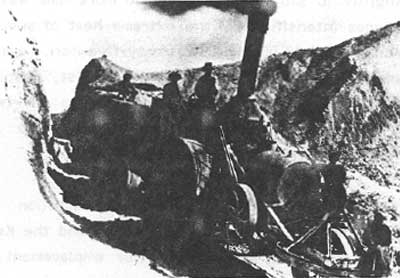
|
| Illustration 95. "Old Dinah," the steam tractin engine purchased by J. R. Lane in 1909 to haul supplies in to the Keane Wonder complex. The engine is here pictured ca. 1898, hauling borax. Photo courtesy Western Regional Office, NPS. |
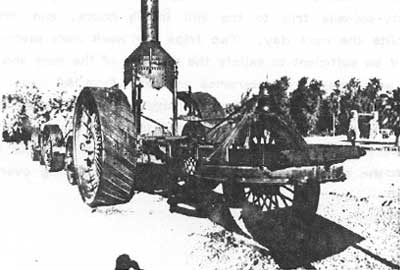
|
| Illustration 96. "Old Dinah," as she appears today, resting outside Furnace Creek Ranch, minus her boiler. 1978 photo by John Latschar. |
Lane blamed the accident on the age of the machinery and the poor quality of water which he was forced to use, and left for California to purchase a new gasoline engine to install in the tractor. But apparently his resources were not adequate to the task, and the traction engine was not again used. The engine stood idle on Daylight Pass for many years, until two employees of the Pacific Coast Borax Company hauled it from Daylight Pass to Furnace Creek Ranch in 1932.
In the meantime, the mine and mill continued to produce. October's gold production reached $20,000, and ten more miners were added to the work force in early November. New strikes, although not as big as the summer's discovery, were found in the mine, which maintained the company's ore reserves. Minor accidents shut down the cyanide plant for a week, but such interruptions were not unusual for a desert mining operation, and production continued. November's output was estimated at between $24,000 and $25,000, the second largest amount produced in a month since the mill had begun operations in 1907. December's yield was somewhat smaller, being $20,000, due to water pipes which froze and broke. The Keane Wonder's total production for 1909 was announced by Wilson to be $220,000, nearly double the previous year, and the average monthly output was $18,333.
The success of the mine and mill was largely due to the very efficient methods used to extract and process the ore. The costs of mining were only two dollars per ton, mostly due to the ease of stoping directly from the side of the mountain. Milling costs, for both the stamp mill and the cyanide plant, were calculated at $3.10 per ton. When the costs of fuel, transportation and supplies were added up, total production costs at the Keane Wonder mine and mill were about $10 per ton, indicating that the company could make a profit upon any ore assaying above $10 to the ton. On November 27, 1909, Homer Wilson reported that since the mill had opened in 1907, it had treated 25,000 tons of ore, with an average value of $12 per ton, and that the mill and cyanide plant had extracted 94 percent of the ore content. Based upon Wilson's figures, the total net profit for over two years of production at the Keane Wonder was about $47,000.
With the mine and mill looking very successful, and with the financial complications finally resolved, investors once. again began to buy the limited amounts of Keane Wonder stock which found their way to the trading boards. Stock which had fallen as low as 9¢ per share when it appeared that the mine would be sold to satisfy the trust deeds had risen to 25 by the middle of December and to 30 by the end of 1909. [22]
As the Keane Wonder Mill began its third year of operation in 1910, conditions remained optimistic. In early February the company applied for United States' patents for twenty-seven of its claims, totaling over 413 acres of land. February bullion returns were $20,000, and for the first time the mill reached the magical figure of $1,000 production per day, as only twenty days' run was possible that month, due to water freeze-ups. March's production was even better, as the mill turned out $25,000, and April's was again over $20,000. After Homer Wilson made several trips to Los Angeles, the Rhyolite Herald discovered more about the financial settlements which had been made the previous year. As the dust settled, it appeared that the Keane Wonder Company did indeed owe money to the receiver of the State Bank and Trust Company. But the debt was being paid off steadily, and the Herald concluded that the Keane Wonder would soon be out of debt.
May's production figures were somewhat less than $20,000, and no figures were given out for June. The mine and mill, though, continued to operate through the hot summer months. The Tadich brothers of Rhyolite, who had established a general store at the mine and another one at the mill site, reported continued good business. The high number of miners employed by the company resulted in one of their number being chosen as a delegate to the Inyo County Democratic convention in August, and the Keane Wonder boarding house was listed as a polling place for Inyo County during the general elections the following fall. On September 1st, 1910, seventy-five men were employed at the mine and mill.
In September, the company announced that the water supply had finally been improved enough to support the mill full time. This was due to the clearing out of several stoping areas, which enabled the company to pump more underground water than before. In addition, Homer Wilson purchased and installed a 75-horsepower steam engine and compressor to drive a new set of machine drills. This soon resulted in a short-lived labor dispute, as twenty-four miners quit in a protest against the cut-back in jobs brought about by automation. The Keane Wonder Company, however, had no trouble in replacing the striking miners, especially since the majority of mines around the Rhyolite area were dead or dying by the fall of 1910, and unemployed miners were easy to find.
In the meantime the bullion shipments continued. By now the arrival of bullion from the Keane Wonder was no longer a striking news item, and the Rhyolite papers printed bullion estimates only sporadically. August's returns were reported to be "about usual," and Octobers was merely assessed as "large." November's shipment was estimated at $20,000, which was said to be close to the average monthly yield throughout 1910. Although no accurate production estimates are available for 1910--one paper reported $350,000 for the year, which is obviously much too high--the Keane Wonder mine once again was listed as the largest producing gold mine in Inyo County, California. [23]
The Keane Wonder entered 1911 as one of the only two surviving and producing mines of the Bullfrog region, and ended the year as the only one, for the big Montgomery-Shoshone Mill shut down in May. Thus the Keane Wonder, which had preceeded the great Bullfrog rush, had succeeded in outliving the rise and fall of Rhyolite and the Bullfrog boom. As the sole surviving paper in the Bullfrog District in 1911, the Rhyolite Herald continued to cover the Keane Wonder Mine, but as the paper shrank from the twelve-page spread of balmier days to four pages, half filled with canned material, coverage of the Keane Wonder grew sparser.
Still, we do know that Homer Wilson reported average bullion yields of $18,000 to $20,000 during January, February and March of 1911, and that on April 15th he stated that "General conditions at the Keane Wonder mine are the best in the history of the property." The mill processed about 75 tons per day during that time, near its peak capacity of 80 tons, but profits were not large, since the overhead was high. The air compressor and other equipment installed late in 1910 had cost the company $20,000, and the expense of hauling fuel oil and distillate was the company's heaviest fixed expense. Still, said Wilson, the "Keane Wonder will be a notable little producer for many years to come."
For a few months during the summer of 1911, George Wingfield, the famous Goldfield mining promoter and politician, held an option to purchase the Keane Wonder property, but the option was allowed to expire. Although no one knew for sure, the Rhyolite Herald speculated that Wingfield had been discouraged due to the manner in which the stock in the company was dispersed. He probably was not discouraged, by the output of the mine, for production figures soared during that summer. April's cleanup netted the company $25,000 and May's totalled an estimated $22,600. Then, during the first two weeks of June, the Keane Wonder broke all its previous records, producing nearly $30,000 during a 15 day run, or almost $2,000 per day. Total production for June was estimated at almost $50,000.
The mill was disabled for a week in July when a cylinder head was blown, but it was soon fixed and running again, and on August 5th the Rhyolite Herald quite properly called the property the "King of the Desert." Privately and quietly, the paper reported, "Keane Wonder stock is increasing in demand and value." Production figures were not listed for the fall months of 1911, although the papers inferred that the monthly averages were around $30,000. The force of miners was maintained, and the Porter brothers found themselves unable to satisfy the supply demands of the company, so another hauling contract was let. Once again, the number of miners employed at the property was sufficient for the Keane Wonder office building to be designated as a polling place for the Inyo County general election.
In October of 1911, the estate of the Keane Wonder was greatly increased by the purchase of the Big Bell property, situated to the north, between the Keane Wonder and Chloride Cliff. The Big Bell Mine, which had fallen into bankruptcy, was sold at auction by the receiver of the First National Bank at Rhyolite, for the bank had also closed, and Homer Wilson purchased its claims for a mere $1,600. A force of miners was soon dispatched to the property for exploration work.
October's production run was estimated at $30,000, which was said to be slightly less than September's, and November's was estimated again at $30,000. No final production estimates for 1911 were listed by the Rhyolite newspaper, although the averages mentioned throughout that year by the Herald would total to about $326,000 for the year, if valid. The Herald's natural tendency to exaggerate is emphasized by a 1938 report in the California Journal of Mines and Geology, wherein 1911s production was conservatively estimated at $161,000. The true figures are probably somewhere in between those two estimates, and only Homer Wilson knew what they were. The totals were enough, however, for the Keane Wonder to tie with the Skidoo Mine, on the west side of Death Valley, as the leading gold producers of Inyo County in 1911, the fourth year in a row wherein the Keane Wonder had appeared at the top of the list. [24]
The mine and mill continued production in 1912, but the end was beginning to come into sight. The Rhyolite Herald reported in January that the mine had only three months of ore reserves in sight, and development work was being pushed on the unworked claims of the company, some of which had never been explored since the early days of 1905. Ore was discovered on one claim, the Whipsaw, and the company began to shift operations around the ridge towards it. Surface tramway tracks were laid to take the Whipsaw ore to the upper aerial tramway terminal. In addition, development work was continued on the Big Bell claims, purchased by Wilson the previous year.
In late January the cyanide plant was temporarily shut down, as it had finally finished processing all the accumulated tailings which had been collected before the construction of the plant. The cyanide works would be idle, said Wilson, until another such accumulation had been gathered, since it was not economical to run it on a part time basis. In the meantime, the 20-stamp mill kept on crushing ore, at such a rate that another freight team was started between Rhyolite and the mill to supply the engines with oil. January's production once again reached an estimated $30,000 worth of bullion, and February's almost reached that figure. Fifteen thousand dollars of that sum was reported to be pure profit for the company.
Then, on February 24th, disaster struck. The mile-long cable of the aerial tramway snapped and several ore buckets fell into the ravines below. All work on the mine and mill had to be stopped while the old cable was taken down and a new one restrung and the ore buckets placed back on line. The new cable weighed 26,000 pounds, and cost $7,280. Railroad freight to get the cable to Rhyolite amounted to $780, with additional wagon freight charges of $350 just to haul it from Rhyolite to the mine. Total costs and delays set back the Keane Wonder Company almost $10,000 before the tramway was again operating in late March.
In the meantime, the Keane Wonder Company received its patent for twenty-eight claims, which constituted "the largest territory comprised in one title that has been issued by the land department for many years." With the new patent on hand and the cable restrung, the mine and mill began running again at full capacity, and the Rhyolite Herald was fulsome in its praise for Homer Wilson, who had operated the Keane Wonder for so long. "Mr. Homer Wilson is entitled to all the credit, and for having struggled against adverse conditions for several years, never losing faith in the property, but steadily forging ahead and overcoming difficulties, and now his efforts are being crowned with deserved success." The accolades seemed warranted. As an example of Wilson's economical management, he had used the down time caused by the cable misfortune to rework and retool all the machinery in both mine and mill.
With the mine and mill running at full capacity again, but with the ore reserves dropping rapidly, the Keane Wonder Company began to think of selling its property. T. B. Rickey, who still held a large interest in the company, negotiated with a group of Philadelphia capitalists in early April, and the sale was made towards the end of that month. The purchase price was reported to be $600,000. Half the payment was made immediately, and all the company's stock, together with the resignations of all its officers and directors, were placed in escrow until the second half of the payment was made on or before May 5, 1912. According to the agreement, Homer Wilson would stay on the property as supervisor while the new owners investigated the feasibility of several capital improvements, such as the addition of twenty more stamps to the mill and the conversion from oil to electric power. Once these improvements were made, Wilson was to turn over the property and end his long association with the Keane Wonder. As the news of the sale and the anticipated infusion of new capital into the mine was spread, a corresponding rise in the price of Keane Wonder stock was recorded on the trading boards, rising from 16¢ to 35 in a few days.
As May turned into June, no improvements were made, although the mine and mill continued to operate. Homer Wilson was forced to leave the mine for a month, to attend his sick daughter in San Francisco, thus delaying the expansion plans. But upon his return in late June he assured the Rhyolite Herald that plans were being perfected, and that the improvements at the Keane Wonder would soon take place. In the meantime, production continued. May's bullion returns were said to be satisfactory, although no figures were given, and June's was reported as slightly smaller than May's.
Then, on August 22d, the end came. As the Inyo Register blazed in its headlines, "NOTED MINE'S DAYS OVER. KEANE WONDER HAS WORKED OUT ITS ORE BODIES." The Keane Wonder mine and mill, after running successfully since November of 1907, had finally shut down. The paper reported that the operations had been closed for an indefinite period, "and doubt is expressed whether t will ever resume production. It is said that for some time past the operations of the company have failed to yield a profit, and that development of the Whipsaw claim have not been successful." The final cleanup had been made, which netted $10,000, and the ore pillars had been broken down, to save their contents. This was a sad sign, for with the removal of the ore pillars from areas which had been stoped so long, large portions of: the underground workings of the mine complex would soon collapse: The Keane Wonder, said the paper, had exhausted all the ore in sight, and had no prospects of finding any more.
Four men were retained from the large work force to treat the remaining tailings in the cyanide plant, and Wilson said that when cooler weather returned in the fall that development and exploration work would be done under contract, in the hopes of finding new deposits. "The news of the suspension of operations comes as a great surprise to mining men here," wrote the Inyo Register, "as reports from the property have been highly encouraging for a long time past." Remembering the past dealings of Rickey, the paper went on to accuse him of dumping a gutted mine upon a group of poor dimwitted Philadelphia capitalists. "Persons who have taken an interest in the matter declare that some one has been "handed a lemon" and that Thomas B. Rickey is not that individual but more probably the one who disposed of the fruit." It is doubtful, however, if the paper's suspicions were true. The Rhyolite Herald had stated several months earlier that the known ore reserves of the mine consisted only of three months' supply. Such a published report would have been impossible to keep from the eyes of any businessman who knew what he was doing. In addition, the subsequent actions of the new Philadelphia owners, who retained the services of Homer Wilson, quite decidedly indicate that they did not feel deceived when their new mine shut down. [25]
The first segment of the Keane Wonder's history had ended. The mine, which had first been located in 1904, had been consistently worked for over eight years, and the mill had steadily produced gold bullion from November of 1907 to August of 1912, longer than any other mill in the surrounding Bullfrog territory, or any mill on the east side of Death Valley. Final production figures for these years are necessarily unreliable, but can be estimated. The mill probably produced about $75,000 in 1912, which when coupled with the California Journal of Mines and Geology's conservative estimate of $682,000 for the years 1907-1911, would bring total production to at least $750,000.
But although the major period of production at the Keane Wonder was over, the mine and mill were not yet finished. Unfortunately, the subsequent history of the property is much less recorded, for the death of Rhyolite and its newspapers leaves us without the weekly coverage of the early years. In addition, as the Keane Wonder became less important to the economy of Inyo County, its newspapers concerned themselves less and less with the several subsequent attempts to revive the mine. Thus our information becomes rather sketchy.
We do know, however, that the first attempt to revive the mine came less than a year after it had closed down, in June of 1913. At that time, the new owners of the Keane Wonder held a meeting in Philadelphia, and a new board of directors was elected. Reports released to the Inyo newspapers indicated that the new company was in relatively good financial condition, and that the company had some new ore blocked out in the mine. In a rather confusing statement, Homer Wilson, who had been elected president of the Philadelphia company, stated that the mine had over 3,000 tons of ore blocked out, and that ten stamps and cyanide equipment would be added to the mill.
In July of 1913, another mining journal stated that the new management had perfected a plan to put in ten additional stamps and other equipment. Foundations were in place and installation of the machinery was about to start. In addition, a new shaft was being sunk on the property. We then hear nothing of the mine until January of 1914, when Homer Wilson told the Inyo Register that a new water supply had been developed. The capacity of the stamp mill was still given as 80 tons per day, however, which indicates that no new stamps had been added. But the mill was evidently active, from the tenor of Wilson's statements, for he claimed that the Keane Wonder had produced over $1,000,000 through the end of 1913. Then, the case of the State Bank and Trust Company reared its head, as the newspapers reported in February of 1914 that the Keane Wonder was still paying off its debt to the receiver of the bank. Evidently the mill was running, in order to produce the bullion to make those payments.
If it was operating, profits evidently were not very large, for the Keane Wonder Company failed to pay $503.23 in taxes to the Inyo County Treasurer in June of 1914. Then, evidently the mill again shut down, for the company was forced to quit making payments to the State bank. As a result, the Keane Wonder mine and mill was sold at a sheriff's auction in about November of 1914, in order to satisfy the debt due to the bank. The purchaser of the property was the Francis Mohawk Mining Company, whose president, D. Mackenzie, had been one of the original litigants in the 1908-1909 suits revolving around the ownership of Keane Wonder stock. Homer Wilson, as usual, landed on his feet, and was named as superintendent of the mine and mill by its new owners, and the Francis Mohawk Company began to operate the complex once again. The new owners had a distinct advantage over their predecessors, for they were operating without any debts hanging over the company. To a mining concern operating on the fringe of profitability, as the Keane Wonder now was, this was important. The new owners, this time, made improvements to the property, chiefly an addition to the cyanide plant, which brought its capacity up to 300 tons per day.
Production runs at the Keane Wonder began again in earnest in the fall of 1915, as well as development work on some of the unexplored claims of the company. A new superintendent was appointed at that time, as Homer Wilson finally ended his long, identification with the Keane Wonder mine. The new ore bodies lasted only about six months, however, for the mill was again closed in May of 1916. The cyanide plant continued to run through July of that year before exhausting the tailings piles, after which the entire Keane Wonder complex lay quiet. The Francis Mohawk Company announced in July that a new reorganization was under way, and that endeavors would soon be made to open a large tonnage of ore which they believed to lie beneath the present workings. But the new plans were never carried through, and in 1917 the mine was still reported to be idle, and the company was still reported to be considering reorganization plans. The California State Mineralogist, in 1917, reported that all the known ore bodies were worked out, and estimated that the mine and mill had produced a total of $1,100,000 in gold bullion through the end of 1916. If his figures are accurate, total production between 1912 and 1916, when the mill was operated sporadically, amounted to about $87,500 per year. [26]
After the revival efforts at the Keane Wonder failed in 1916, the mine and mill lay idle for many years. Edna Perkins, one of the very few writers of western lore who can be trusted, visited the complex in 1922. She described the mill site as a mass of deteriorating buildings, half blown down, with broken water pipes and other debris scattered around the area. The superintendent's house, she wrote, was obviously a fine residence at one time, but she and-her companions preferred to sleep outside.
The large boarding house was almost completely ruined. The mill building, however, was still in relatively good shape, as it was locked and guarded. The watchman was John Cyty, who had been identified with the Funeral Range area ever since the Bullfrog boom, and he kindly unlocked the mill building for them and showed them an extensive array of machinery still intact inside.
The Keane Wonder mine and mill lay idle through the rest of the 1920s and the first half of the 1930s. W. R. McCrea of Beatty, who owned the Chloride Cliff Mine, tested the old tailings of the Keane Wonder mill in 1930, but he decided that their contents were not valuable enough to reprocess. Then, in 1935, the Keane Wonder complex underwent another attempt at revival.
During 1935 and 1936 the Coen Company bought and leased mining rights to the Keane Wonder and Big Bell mines, and carried out several testing programs. Most of the work was done on the Big Bell claims, but the company did employ eight men for some time in reworking the old mill tailings of the Keane Wonder by cyanide. Since the old Keane Wonder tramway was described as being deteriorated beyond repair, the company established its camp at the Big Bell site, which was its center of operations. The operations at the Big Bell were successful for several years, but no attempt was made to reopen the Keane Wonder Mine, beyond the reprocessing of the mill tailings. By November of 1937 the Coen Company had ceased operations, and the Keane Wonder mill and its contents were sold to George Ishmael, who dismantled the old stamps and hauled them to Los Angeles. Thus ended the proud history of the Keane Wonder Mill, for with the exception of the heavy foundation timbers of the tramway terminals, almost all the mill complex was salvaged.
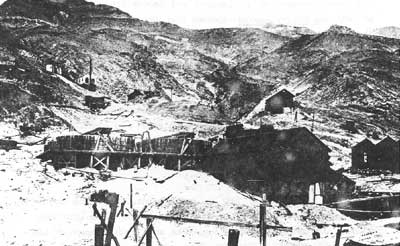
|
| Illustration 97. View of the Keane Wonder Mill area, circa 1938. The lower tramway terminal building is standing in the upper left of the picture, just behind the smokestack, but the mill building itself has been torn down and salvaged. In the foreground are several buildings and tanks of the cyanide plant, showing the deterioration of two decades of neglect. Photo courtesy of Death Valley National Monument Library, #8633, with credit to Stovepipe Wells Hotel, which misdated the photo as circa 1908. |
In 1938, the Keane Wonder Mine was sold to E. L. Cord, the automobile manufacturer, who in turn leased it to two Denver miners, W. D. Leonard and George Schriber. In April of 1940, the Mining Journal reported that five men were employed at the mine in reconditioning the machinery and repairing the camp buildings in preparation for active development work. The aerial tramway was refurbished that fall, and preparations were made by ten employees to put in a new mill on the site of the old one. Camps were erected at both the mine and the mill site. By June of 1941 a new 150-ton mill was under construction and it was nearly completed by July. But the new mining effort was short-lived, for the operation was closed down in March of 1942, when all the machinery, with the exception of the new aerial tramway, was hauled away to another site.
From 1942 to the present, the Keane Wonder Mine has been idle. E. L. Cord held title to the estate until 1969, when it was sold to the Title Insurance and Trust Company of Los Angeles for $25,000. The Title Insurance Company, in turn, sold the property to the National Park Service in the early 1970s.
Total production at the Keane Wonder mine and mill has been estimated by several different sources at $1,100,000. Of this figure, most agree that between $625,000 and $682,000 was produced in the years between 1907 and 1911, during the greatest years of prosperity for the Keane Wonder Mining Company. [27]
b. Present Status, Evaluation and Recommendations
There can be no doubt that the Keane Wonder mine and mill complex should be put on the National Register. The Keane Wonder Mine represents one of the two largest producing gold mines within the vicinity of Death Valley National Monument (the other being the Skidoo), and in addition represents the longest running gold mine of the entire Bullfrog boom region. In a sense, the Keane Wonder can be given part of the credit for starting the great Bullfrog boom, since it was Domingo Etcharren's and Jack Keane's discovery that drew "Shorty" Harris and. Ed Cross to that particular area. With a production of over $1,000,000, the Keane Wonder was vitally important to the local economy of both Nye County, Nevada, and Inyo County, California, during the gold boom days of the early nineteen hundreds. In addition, the Keane Wonder mine and mill had several unique features, rarely found elsewhere, such as its mile-long aerial tramway. Although the mill itself is no longer standing, the Keane Wonder complex includes numerous structures and ruins which should be preserved and interpreted.
At the mine itself, located high up the slope of the Funeral Mountains above the mill site, extensive structures remain. It is not hard to look at the mine complex and realize that the entire area was continuously mined for a number of years. The side of the mountain is completely pitted with adits and stoped areas, and in places an entire section of the mountain has collapsed into the underground workings below. Several tent platforms dot the area, as well as a couple of rock-walled living quarters, and a collapsed wooden building. A water tank is perched high on the hillside, and two concrete hoisting foundations are below, one of which still has an engine, a cable spool, and hoisting mechanisms attached.
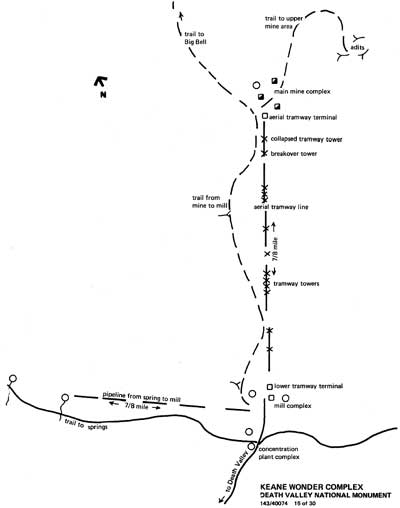
|
| Illustration 98. Map of Keane Wonder Complex. |
The upper tramway terminal is quite impressive. The structure is approximately thirty by sixty feet in size, and is composed of very heavy timbers, which were originally the foundation and framing timbers for the terminal. Although most of the covering material is gone, it is still quite easy to see how the terminal operated. Wire cables run in and out of the terminal, upon which the ore buckets rode. When the buckets entered the terminal, they were guided by an iron track, which carried them in and around to the ore bin, where they were automatically loaded. The ore buckets then continued around on the cable, back out the terminal and down the mountain. The gearing and other mechanisms are still visible, as well as a small electric motor, added in later years. An ore chute leads down into the ore bin, which stands just next to and above the upper terminal.
The tramway line is in fairly good shape, and as best can be determined, the 1940 reconstruction of it did not greatly alter its original configuration. Twelve of the towers are still standing, although the one nearest the upper terminal has collapsed. (It has collapsed since 1975 and should be restored immediately.) All the terminal towers have a base measuring twelve feet to a side, and some rise to thirty feet in the air. The heavy framing timbers of the towers are bolted directly into the rock, or into concrete foundations laid on the rock. The two main support cables of the tramway are still strung from the upper to the lower terminal, but the bucket cables have fallen to the ground between most of the towers. On the few sections where the bucket cables are still in place, ore buckets can still be seen hanging from the line.
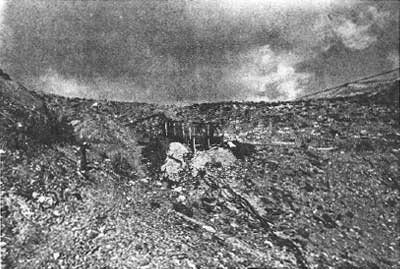
|
| Illustration 99. Upper tramway terminal and ore bin, from below. Note strings of bucket cables and support cables lying below the terminal. The pipeline leading above the terminal towards the dumps in the upper left corner is also visible. 1978 photo by John Latschar. |
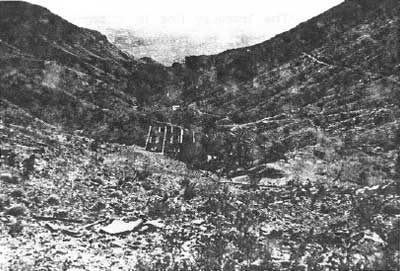
|
| Illustration 100. The upper terminal and ore bin from above. The main support cables can be traced fom the terminal down to a tramway tower on the edge of a ridge. Halfway between is the platform for the first cable tower, which has collapsed. The main trail from the mine to the mill is in the upper right corner of the picture. 1978 photo by John Latschar. |
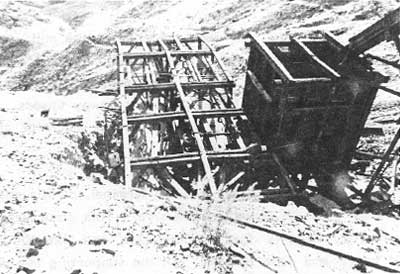
|
| Illustration 101. Close up of the ore bin (right) and the upper tramway terminal (center). Close examination will reveal the path of the ore buckets, which entered at the left front and traveled around to the ore bin and back out of the right front. Much of the gearing mechanism which operated the automatic loading facility is still visible. 1978 photo by John Latschar. |
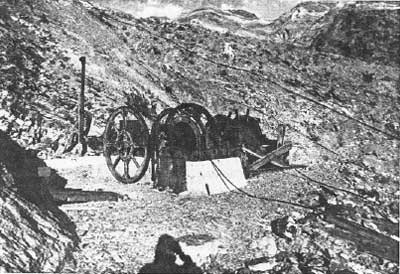
|
| Illustration 102. Remnants of one of the hoisting plants at the mine area, showing a cable spool at the right, the cable reel in front, and the engine in the rear. The pipeline leading up towards the top of a dump is clearly visible. 1978 photo by John Latschar. |
The trail from the mine to the mill, cut during the construction of the tramway in 1907, is in very good condition. The main trail is clearly evident and easily walked, and branch trails can be seen leading to each of the tramway towers. Sections of a two-inch pipe line can be seen along much of the trail, including periodic expansion joints.
The lower tramway terminal, on the edge of the Death Valley wash, is equally impressive. This structure is about twenty-five by seventy feet in dimension, and like the upper is built of heavy and solid timbers. All the supporting mechanisms at the lower terminal have been salvaged since it was much easier to do so here than at the upper. The area below the terminal, where the original mill stood, has nothing left beyond a series of concrete foundations, water and fuel tanks, the ruins of several wooden structures and a series of leveled areas, upon which the original floors of the mill stood. Close to the mill site is the ruins of a twenty-five by forty foot frame building, which has completely collapsed. After viewing the mine and upper terminal area, the lower complex is a disappointment, for the upper looks relatively intact, but the lower bears the marks of years of salvage and souvenir hunters.
The cyanide plant is almost totally destroyed. The only remnants of this sprawling structure are the ruins or outlines of half a dozen tanks scattered over a wide area of heavily eroded mill tailings. Several level tent or building sites mark the area, and the ruins of another pipe line can be followed northwest towards a spring.
In summary, the remnants at the Keane Wonder mine and mill site are extensive, and offer the Monument an unusual opportunity to interpret the story of desert gold mining in the early twentieth century. At present, this story is not being told.
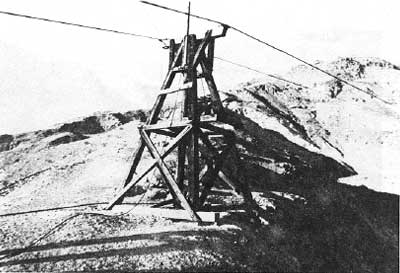
|
| Illustration 103. Close up of a terminal tower, showing details of construction. The main support cables, upon which the buckets rode, are still in place, but the bucket cables, which pulled the buckets along, can be seen dangling from the tower. 1978 photo by John Latschar. |
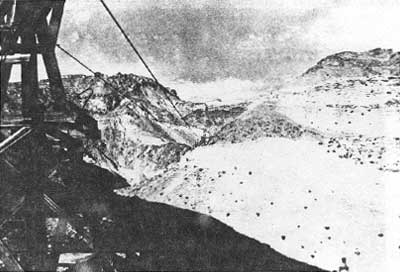
|
| Illustration 104. View from the same tower, looking up the mountainside, showing the relative distance between towers. The Keane Wonder Mine is located below the farthest distant rounded mountaintop, above the towers barely visible in the distance. 1978 photo by John Latschar. |
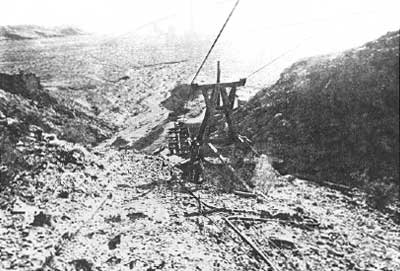
|
| Illustration 105. View of the #1 tower, looking down upon the lower tramway terminal, with Death Valley in the background. Again, note the bucket cables lying on the ground, next to the pipe line, with one of its expansion joints. 1978 photo by John Latschar. |
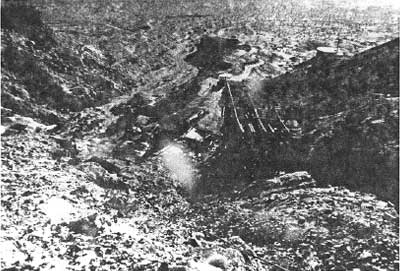
|
| Illustration 106. View of the lower terminal and mill complex from above. The step-like graded levels to the left of the lower terminal were the floors of the original mill, which no longer exists. Some of the foundations, and a fuel tank, may still be seen. At the top right of the picture, beyond the water tank and telephone pole, is the area of the former cyanide plant, now marked only by eroded tailings and tank remnants. 1978 photo by John Latschar. |
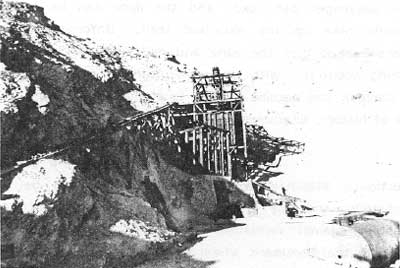
|
| Illustration 107. A closer view of the lower tramway terminal, from below. Some of the foundations, walls, and other remnants of the mill complex can be more clearly seen. 1978 photo by John Latschar. |
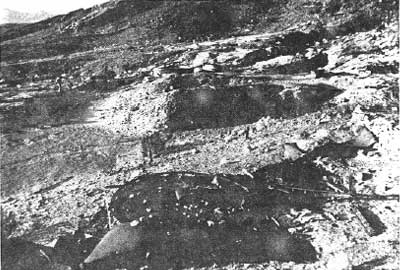
|
| Illustration 108. A typical view of a portion of the former cyanide mill complex, showing tailings and the ruins of several tanks. 1978 photo by John Latschar. |
The mill complex is easily reached from the Monument headquarters via a passenger car road, and the mine can be reached by an energetic hike up the excellent trail. Unfortunately, few park visitors realize that the mine and mill exist, and fewer still know anything about it. With the expenditure of a relatively small sum, this complex can become a major tourist attraction, and also a major point of historic education.
In the meantime, the mine and mill sites need protection. Stabilization of the tramway should be undertaken immediately, and the area should be protected and patrolled to protect it against vandalism and theft. Extreme care should be shown by the Monument when the mine and mill sites are readied for visitor use, particularly when the site is cleaned up. Although there is a degree of modern trash around the Keane Wonder site, most of the debris on the ground is of a decidedly historic nature, and only a trained professional, on the ground, should be allowed to make the key decisions regarding the dispositions of the Keane Wonder mine, mill, and tramway complexes.
4. Johnnie Cyty and the Big Bell Mine
a. History
1. Big Bell Mine
One of the more colorful participants in the South Bullfrog District mining boom of the early nineteen hundreds was a man named Johnnie Cyty, also known as "Johnnie-Behind-the-Gat," for his fondness of resorting to his machine pistol to solve various difficulties. Cyty had been prospecting and mining for several years before his arrival in the Funeral range, and had lived for a time at the raw mining camp of Bodie, California. Following his stay there, Cyty found and developed a small mine in Snow Canyon, west of Death Valley, and for a few months produced bullion at a small mill which he built. But in the summer of 1904, the lure of the new strike at the Keane Wonder caused Cyty to abandon his Snow Canyon mine and to join the wave of prospectors combing the hills around the Keane Wonder.
With a partner named Mike Sullivan, Cyty left Ballarat, California on June 1st and headed towards the Keane Wonder country. Within two weeks the two men had located ten claims on the west slope of the Funeral Mountains, approximately half-way between the Keane Wonder and the old Chloride Cliff mines. Before another, month was out, Sullivan and Cyty had optioned their brand new strikes to a Mr. Gaylord for a down payment of $25,000 and an option to purchase for $250,000. Although the details of the arrangement were not recorded, it seems apparent that Gaylord had one year to develop the mine, before his option to purchase it expired. [28]
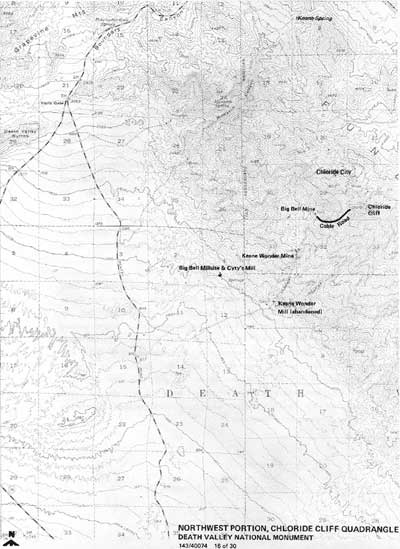
|
| Illustration 109. Map of Norhtwest Portion of Chloride Cliff Area. |
Gaylord never did much work on the Big Bell Mine, as it came to be called. During the year of his option, no mention of either the man or the mine can be found. For whatever reasons, Gaylord was either unable or undesirous of exercising his purchase option, and the original locators regained control of the Big Bell in September of 1905. But Sullivan and Cyty did not work the prospect either, for in early November the mine was again bonded, this time to Walter O'Brien of Goldfield. O'Brien, said the Rhyolite Herald "was one of the lucky fellows at Goldfield, where many snug fortunes have been and are being made, and he is now turning his attention to the more remote [regions] with the hopes of opening another bonanza."
Under O'Brien, the Big Belt Mine finally began to undergo development. By mid-November, O'Brien had organized and incorporated the Death Valley Big Bell Mining Company, and had sold several thousand dollars worth of stock in San Francisco, at 25¢ each. The stock sales were obviously made on the basis of the Big Bell's proximity to the Keane Wonder Mine, for the southern most claim of the former came to with 330 feet of the northern end line of the Keane Wonder property. O'Brien announced plans to put six men to work immediately, and talked of building a mill in the near future, complete with a 1-1/2 mile tramway to carry ore from the. mine to the proposed mill site. "The consumation of the . . . deal is believed to mean a fortune for Mr. O'Brien," reported the Herald.
During the remainder of 1905, O'Brien started hauling supplies to the mine site, and work began. Tunnels were started, and a camp was established. By the end of the year, O'Brien estimated that the company had 30,000 tons of ore beneath the ground, and with water only two miles away, prospects looked good. [29]
During the first half-of 1906, work on the Big Bell proceeded smoothly, as O'Brien energetically exercised his option rights to develop the mine. Rich specimens of ore were brought into Rhyolite, some assaying as high as $60 to the ton, most of which came from the ground located nearest to the Keane Wonder property. Playing upon the proximity of the two mines, the Rhyolite Herald ran headlines such as "BIG BELLE IS A WONDER," and reported that O'Brien had left for the east coast, in order to arrange for additional financing for the erection of a mill.
In the meantime, Johnnie Cyty, in partnership with L. D. Porter of Rhyolite, began work on some claims north, of the Big Bell, which they inevitably called the Big Bell Extension. Two men were employed on this property, and a shaft was sunk in hopes of catching the Big Bell ore leads. During the spring and summer months, the efforts were successful, and Cyty in turn brought in ore specimens for display in Rhyolite.
But as September approached, and O'Brien's option year on the Big Bell mine drew to a close, he and Cyty were unable to reach an agreement regarding the eventual purchase of the mine. Cyty, who was nobody's fool, obtained the legal assistance of Senator William Stewart to look after his interests, and after several months of negotiations, a new company was formed. O'Brien was essentially frozen out of the new Big Bell Company, as two prominent Rhyolite merchants, L. D. Porter and J. R. McCormick, were the leading officers, with Johnnie Cyty listed as a director. Under the new management, work was resumed. A force of miners was put to work under the supervision of Cyty, who retained the controlling interest in the company. As 1906 drew to a close, more men were added, encouraging progress was made in the mine, and shares in the new Death Valley Big Bell Mining Company were advertised for sale, at 25¢ each. [30]
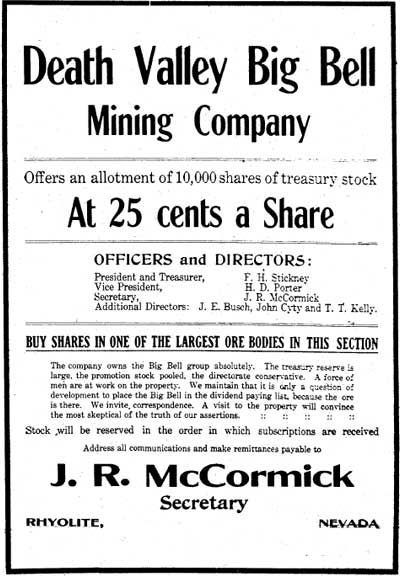
|
| Illustration 110. Advertisement from the Rhyolite Herald, December 14, 1906. |
In January of 1907, the Big Bell Company expanded its operations to a five man crew, and hired T. J. Kelly as the mine superintendent, in order to give the development of the property a more professional guidance than was possible under the direction of Cyty, who was basically a prospector. The miners began sacking ore for future shipment, and company officials confidently told the press that sufficient treasury stock had been sold to furnish funds for an extensive development campaign. "There are many who consider the Big Bell one of the biggest propositions in the country," wrote the Rhyolite Herald "and under the new and able management it should come into even greater prominence as the work progresses."
In February, with the mine beginning to look permanent, the Big Bell Company started to build several stone boarding and bunk houses on the property, and applied for a patent on three of its five claims. By March 1st, over 100 sacks of high grade ore had been filled at the mine, and before work was interrupted by the heat of summer, good progress was made in the company's tunnels.
Work was resumed on the mine in November, somewhat later than usual for that part of the country. By the end of 1907, the Rhyolite Herald was able to report that the company had considerable amounts of ore sacked and ready for a future shipment, and great quantities of milling grade ore in sight. It was evident, however, that the Big Bell was not being worked very energetically during the latter part of 1907, a possible result of the Panic which hit Nevada's mining frontier that fall.
In the meantime, although Johnnie Cyty was still the principle stockholder in the Big Bell Mine, he became less and less identified with the running of the operation. After his replacement as superintendent of the mine, Cyty took his money into Rhyolite and invested in the Unique Dance Hall, where lonely miners could pay to dance with Cyty's girls, one of Rhyolite's more innocent forms of entertainment. The dance hall, however, was not particularly successful, partly because Cyty employed non-union girls, at a time when the aggressive western mining unions were attempting to unionize every facet of every mining town. Cyty's use of non-union girls resulted in a boycott of his hail, called for by the union girls of other dance halls and supported by the majority of the unionized labor forces of Rhyolite's mines.
Consequently, Cyty was unable to pay his rent, and was expelled from the building which he had leased. He refused to leave,, however, and broke back into the building, which resulted in his arrest and a fine of $25, after he paid court costs and promised to be good. The affair was an indication of Cyty's temper, which he always found rather hard to control. By the end of 1907, as a result of these problems and a fondness for the gaming tables of Rhyoiite, Cyty had evidently squandered most or all of the money received from past Big Bell transactions, for he was unable to pay $6.68 in property taxes to the Nye County treasurer. [31]
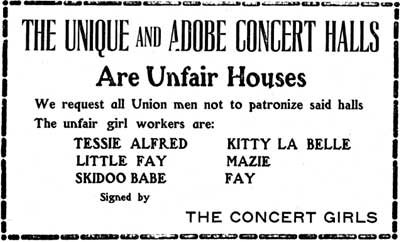
|
| Illustration 111. A broadside, calling for a boycott of Rhyolite's non-union dance halls, sponsored by the unionized girls of the Concert Dance Hall, ca. 1907. Courtesy Nevada Historical Society Manuscript Collection. |
As 1908 began, the Big Bell Mine was not having much better luck than was Cyty. Evidently the new company had run out of development funds, for very little work was done on the property. The mine, however, had very good prospects, which were realized by outside sources, and several times the Rhyolite newspapers printed rumors about the imminent purchase of the mine. But with the mining depression caused by the Panic of 1907 still effecting the region, investment money was extremely difficult to find.
Then, in April, Cyty lost control of his mine, in a manner made traditional by western movies. In a twelve hour roulette game lasting through a Saturday night and into Sunday morning, Cyty lost all his stock in the Big Bell Mine to C. E. Jones, proprietor of Rhyolite's Stock Exchange gaming rooms. It is indicative of Cyty's lack of common sense that he played against the owner of the gambling house himself. Cyty lost a total of 250,000 shares to Jones, valued at 4¢ each, or a total of $10,000. No one seemed particularly sorry for Cyty, another evidence of his standing with the local community. In fact, most of Rhyolite seemed downright glad to see Cyty out of the picture, as witnessed by this editorial in the Bullfrog Miner
Local mining men generally are exulting over Cyty's loss, since they believe that it means the sale of the property to people who have the means to go ahead with its development . . . . In times past there have been numerous attempts made to acquire control of the property, but invariably Cyty had checkmated every transaction proposed. He had acted as a dog in the manger, neither making any effort to develop the mine himself, or allowing others to take the control of the stock at an equitable figure.
Just to rub salt into the wound, the Inyo Independent reported that the 250,000 shares which Cyty had gambled away at the value of 4 each, he could have sold only a few months earlier for 30 each, or $75,000.
Within a week, the papers reported negotiations pending for the sale of the Big Bell property, and surveyors finally began surveying the property for a patent. But even with Cyty out of the way, a quick sale was not possible. In August, rumors were still floating concerning the sale of the mine, although the Big Bell Company was still considering developing it on their own. An agent of the Leschen & Sons Rope Company of St. Louis, which had built the Keane Wonder aerial tramway, inspected the property and submitted plans for an aerial tramway for the Big Bell Mine, which was virtually inaccessible to anything larger than a mule. At the time, the property was described as having a thirty-foot tunnel, which indicates that little if any work had been done since early in 1907.
During the fall of 1908, rumors about the sale of the Big Bell property continued, as representatives of an English concern arrived to inspect the mine. But nothing happened, and in October the property was analyzed by a local stock broker. "This splendid property," he reported, "with proper equipment will yield as big returns as the Keane Wonder. Some little of this stock can be purchased at a low figure, and as a speculative buy it has few equals." Speculative was the key word. [32]
As 1909 opened, it was evident that the Big Bell Mining Company was in trouble. The annual statement of the company showed that total revenue for stock sales and other sources during the previous year had been a mere $1,097.17. Expenditures during 1908 had been $1,074, including $525 spent for a patent survey, leaving the company with a balance of $23 to start the new year. On January 16th, the stockholders of the Big Bell Company met to approve the sale of the property. No mention was made as to whom they approved the sale to, but perhaps they were ready to sell to anyone who offered to buy.
Another big flurry of interest came about in February, when the Rhyolite Herald reported that the English syndicate was seriously considering buying the mine. Their representative had examined it the previous year and rendered a favorable report, and was now back on the ground for a more thorough examination. The Englishman reported that he felt that the Big Bell could be developed into a large and profitable mine, since its ore averaged around $20 per ton. He had recommended purchase of the property, as well as the construction of a water pipe line and a mill. "The successful investment of foreign capital in the Bullfrog country," wrote the Herald "is of such great importance that everyone will gladly welcome it."
But again, nothing happened. In March another mining engineer, from an unknown company, inspected the property and said he was impressed, and the papers reported again that a deal was likely. In the meantime, the Big Bell Company was doing little more than the necessary assessment work required to retain title to its claims. In March of 1909 the Rhyolite Herald reported a mere 500 feet of total work done on the property, an insignificant amount for a mine which had been discovered almost four years previous.
In June of 1909, the Herald reported that the London syndicate was again negotiating to purchase the Big Bell, and the paper hoped for a successful conclusion. In a bit of honesty, the editor also admitted some of the problems involved in the Big Bell negotiations. "That the Death Valley country is a rich mineral zone is well known, but lacking milling facilities, transportation and water, have been the drawbacks which have kept this section in the background."
Through the rest of 1909, the situation at, the Big Bell changed little. The mining engineer from the English syndicate was back for yet another look t the property in August, but that company was exceedingly loathe to make up its mind. The Big Bell Company, in the meantime, did put some of its best ore on display at the American Mining Congress convention in Goldfield, and in late October finally filed the application papers for a patent on its property. The company applied for patents on three mining claims called the Big Bell, the Frisco and the Rainbow, and also for the Big Bell mill site, a total of 52.32 acres. The three mining claims were all located mid-way between the Keane Wonder and the Chloride Cliff mines, but the mill site was located about one mile northwest of the Keane Wonder Mill, on the edge of the Death Valley floor, nestled just at the foot of the Funeral Mountains. [33]
The Big Bell's fortunes did not improve much in 1910. The papers reported that a deal was pending on the mine in January, "which may put it into operation very soon," and in February word was received that the Big Bell's patent was approved. The Rhyolite Herald listed the property as one of the area's many "promising prospects" and in April even reported that it was being operated. The work continued for two months, and in June another deal was reported for the sale of the mine. Engineers for the purchasers said that the Big Bell had 25,000 tons of $12 ore in sight and 15,000 tons of "loose" ore. The ore was of such a grade that a milling plant close by would be required to admit of a reasonable profit. Again, in June an July, papers reported deals "on" for the sale of the mine, but again nothing came of the negotiations. The mine shut down operations in June of 1910, and no further work was done that year.
Finally, in 1911, the fortunes of the Big Bell Mining Company, which had been sputtering for the last several years, completely died out. On April 29th, the receiver of the First National Bank of Rhyolite, which had closed its doors, offered 300,000 shares of Big Bell stock for sale at auction, in order to satisfy an outstanding debt of $2,638. The following month, the optimistic Rhyolite Herald reported that there were "some indications of a decided change in the conditions of the Big Bell property." The Herald was more correct than it supposed, for in September the entire Big Bell estate was advertised for sale at auction by the sheriff of Inyo County, California, to satisfy back taxes due on the property.
As noted above, the Big Bell property was purchased for $1,600 by Homer Wilson of the Keane Wonder Mine, who was hoping to use the Big Bell claims to alleviate the shortage of ore in the Keane Wonder Mine, and during 1912 the Keane Wonder Company did exploration work on the Big Bell claims for a few months. But by June of that year, the Keane Wonder had become discouraged over the prospects of the Big Bell claims, for the company failed to pay taxes upon the property, and it reverted to the control of the Inyo County treasurer. [34]
The Big Bell mine lay idle from 1912 to 1935, when the Coen Company acquired mining rights to the property. After a preliminary testing period, the Coen Company opened operations in earnest on the Big Bell site, and established a camp. Eight men were put to work in March of 1936. A ball mill was erected at the property, as well as cyanide tanks, and a pipe line was constructed from Keane Springs down to the mine, via Chloride Cliff. Due to the virtual inaccessibility of the mine, access was primarily down from Chloride Cliff, via an "improved" motorcycle trail, which was little more than a crude inclined cable road. A Mack truck chassis was modified and used to slowly winch supplies and men up and down the steep ridge. Keane Springs was improved and a pump house and pumping machinery installed. Operations at the mine, however, proved that overhead was too high or the ore content too low for profitable operation, and by the fall of 1937, the Coen Company had abandoned its efforts. Due to the extreme efforts required to haul its machinery back out of the mine site, everything was left in place. The Coen Company probably produced a small amount of gold bullion during its period of operation, but no production statistics are available.
The Big Bell Mine lay idle between 1937 and 1940, when it was acquired by K. M. Woods of Beatty, who operated it for a very short period. In March of that year, the mine was reported on the producing list, and plans were made to increase its milling capacity from 20 to 40 tons daily. Woods' effort, however, was short-lived, and the mine shut down again in 1941. In 1952 the California Journal of Mines & Geology reported that the Big Bell was owned by H. D. Porter, the old Rhyolite merchant, and Marie MacPherson, a descendent of another Rhyolite pioneer. The mine was idle in 1952, but was reported to have produced some lead, silver and gold during the period of 1939 to 1941. The last year of operation was 1941, and from then until today the mine has been idle. The property is still held by the Porter family. [35]
2. Cyty's Mill
In the meantime, Johnnie Cyty's luck had not been much better than that of the mine he had discovered. In 1908, after Cyty lost control of the Big Bell, he returned to the prospecting life, centering his attention around the Big Bell Extension claims. Unfortunately, there was some question as to whether or not he had properly performed and filed the annual assessment work on those claims, and some of the ground was also claimed by C. Kyle Smith, the popular recorder of the South Bullfrog Mining District. Smith and Senator William Stewart had formed the Lee Gold Crest Mining Company to develop a group of claims in the Funeral Range, and also another group south of there, in the vicinity of the Lee-Echo mining district.
For several months, as the dispute over the ownership of the ground flared, both men uttered threats against the other, and the matter came to a head in late November, when Smith found Cyty working on the disputed claim. Arguments lead to gunfire, and Cyty killed Smith. The matter immediately became the number one topic of conversation throughout the region, and Cyty did not have a chance in the local press. Smith had been a well liked and successful miner, as compared to the more taciturn and moody Cyty, who seemed not to have a friend for miles around. The coroner's jury returned a verdict of guilty against Cyty, and he was bound over for trial in Inyo County. Feelings ran high, and talk was heard around Rhyolite of lynching the prisoner. The Bullfrog Miner, for one, felt no responsibility for unprejudiced reporting, and in a blazing editorial on November 28th, announced that local sentiment "CONVICTS JOHN CYTY OF COLD-BLOODED MURDER." Past mis-deeds and quarrels of Cyty were re-run through the press, and his long held sobriquet of "Johnnie-Behind-the-Gat" was made much of.
Pretrial hearings, depositions, and other legal maneuvers lasted. from the fall of 1908 into the spring of 1909, and the trial began in March of that year. In early April, the jury convicted Cyty of manslaughter, a verdict which caused the Inyo Register to complain that "Jury Treats Cyty with Distinguished Consideration." Most local folk felt that Cyty had unjustly escaped the hangman, and the verdict caused much grumbling. Only the Inyo Independent maintained its composure, and aptly summed up the conflicting testimony delivered at the trial: "One peculiar fact in the case is that both men were shot from the rear and both men were shot twice."
Sentencing was set for May and then delayed until June. Under current California law, Cyty could receive one to ten years in jail. On June 25th, he was sentenced to ten years in San Quentin, but notice of appeal was at once filed, and a stay of execution pending the appeal was granted. The appeal was heard the following November, and was successful. The California Appellate court reversed the judgement and order of conviction and said that Cyty must be given a new trial, due to technical errors. In March of 1910, Cyty's retrial began, and he was soon acquited. It appears, from the confusing and contradictory evidence, that the jury had finally decided that Cyty was defending his ground, and there was some evidence that Smith had fired the first shot. Cyty, who was finally set free after a year and a half in jail, left for southern Inyo County where he said he had some valuable mining claims. [36]
After his acquittal, Cyty disappeared for about a year, and then returned to the Funeral Range. In February of 1911, he resumed work on the property which had been in dispute with Smith, and made good progress. Since he had little money for development, Cyty entered into an agreement with some Keane Wonder miners, whereby they would work his property for a percentage of the returns. Several men accepted the deal and began sacking ore, which Cyty hoped to have treated at the Keane Wonder Mill.
But by March, indications on Cyty's property were so promising that he changed his mind, and on March 11th, Cyty purchased his own small mill. His luck had changed, for Cyty seized the opportunity to buy a 3-stamp mill at a sheriff's auction for a mere $500. The mill, which had belonged to the Hayseed Mining Company of Lee, California, was situated at the Leeland Station on the Tonopah & Tidewater Railroad, and Cyty was soon busy supervising the move of the mill to his property.
By mid-April, horses and teams were busy moving the mill to the site which Cyty had selected. Due to the lack of water and the inaccessibility of his mine, the mill was installed about one mile northwest of the Keane Wonder Mill, on the Death Valley slope of the Funeral Mountains, where a series of three springs provided an adequate water flow for the mill. Cyty's mill site appears to be the same mill site formerly claimed by the Big Bell Mining Company, an ironic twist. Evidently there were some delays in setting up the little mill, for the Rhyolite Herald promised first in April and again in August that the mill would start crushing ore soon. On September 16th, the same promise was made, and the Herald added that much good ore was on the site waiting for the mill to start.
Finally, on October 14th, 1911, Cyty got his mill operating. The Rhyolite Herald reported that the mill had been running for a few days, but no cleanup had yet been made. The mill consisted of three Nissen stamps, with a twelve to fifteen tonnage capacity per day, and the mine was said to have ore running from $20 to $30 per ton. By now feelings against Cyty had subsided. considerably, and the Herald gave him due credit: "Cyty certainly deserves credit for his persistency and triumph over many difficulties and lack of funds. He is entitled to success, and his pluck and industry may win it for him." On November 25th, Cyty made his first shipment of bullion from the small mill, but the amount of the shipment is unknown. Sadly, for some reason, the mill did not prove profitable, for no more shipments were made, and no further mention of either the mine or mill can be found. [37]
After Cyty left his mine in 1911, little further mention of him is found for ten years, and one can only assume that he spent much of the interim in prospecting. Cyty reappears on the Nye County tax rolls in 1921, as the owner of three burros, a cabin and a house in Rhyolite. In 1922, Edna Perkins encountered Cyty, as described above, working as the watchman for the Keane Wonder Mill, which he kept under lock and key. Cyty told Perkins that he had a gold mine in the vicinity, which although it was not being worked, "was. richer than the Keane Wonder ever dreamed of being. Once some one had offered him $300,000, but his partner would not look at it. His tone implied that it was a paltry sum anyway." When Perkins asked him if he still hoped to sell his magnificent mine, "He seemed not to know what he intended to do. Plainly he was another victim of the "terrible fascination." . . . whether he sold the mine or not, he would hang around Death Valley the rest of his life."
From 1922 until 1926 Cyty continued to split his time between his caretaker duties at the Keane Wonder Mill and his home in the ghost town of Rhyolite. In 1926, he again found himself in trouble, when the "lone hermit of Death Valley" was bound over to the district court of Inyo County for shooting George Dalton. Cyty, it seems, had moved to Beatty at the beginning of the Leadfield boom in 1925, and had built a small hotel with lumber salvaged from several Rhyolite buildings. Dalton, who was new to the region, got into some kind of argument with Cyty, and Johnnie once again resorted to his pistol to settle the dispute. Although Cyty gave his age as fifty-three at the pretrial hearings, the Inyo Independent was sure that he was seventy-five or older at the time. Cyty was convicted of assault with a deadly weapon in December of 1926, and was sentenced to one to five years in the penitentiary. His lawyer immediately appealed the decision, and although the record is unclear, the appeal was apparently successful, for Cyty continued to live in Rhyolite.
From 1926 to 1929, Cyty lived in Rhyolite, an in 1930 he moved to Beatty. From then until 1944, Cyty's name can only be found on the Nye County tax rolls, when he paid his yearly taxes on a house and a lot in Beatty. In 1944, the property was transferred to another owner, and once can only assume that Johnny-Behind-the-Gat had died [38]
b. Present Status, Evaluation and Recommendations
1. Big Bell Mine
The numerous structures remaining at the Big Bell site are fairly well preserved, and are very interesting. The high degree of preservation, as well as the amount of unsalvaged material at the site, are due solely to the mine's geographic location. Access to the Big Bell may be had from only two trails, neither of which is easy to negotiate. From below, one may hike up to the Big Bell site, using the Keane Wonder trail from the mill to the mine, and then following the Big Bell trail on up from the Keane Wonder mine to the Big Bell site. Total distance along this route is about two and a half miles, and demands a constant climb, from an elevation of 1,260 feet to 3,200 feet.
The other means of access is from Chloride Cliff above, wherein the hiker must walk down the old cable road from an elevation of approximately 5,000 feet at Chloride Cliff. Obviously, unless one hikes straight down from Chloride Cliff through the Big Bell site to the Keane Wonder Mill, a visit to the Big Bell Mine will occasion considerable effort. For this reason, few if any souvenir hunters have been able to carry off any momentos from the mine. For the same reason, when the Coen Company ceased operations in 1937, it evidently felt that the effort and expenses of salvaging its machinery was not worth while. As a result, the Big Bell site presents a fine picture of life and work in a mining camp in the late 1930s.
The access road from the Chloride Cliff area, which was the one used by the Coen Company, is unique in itself. A very steep trail follows the edge of a ridge from Chloride Cliff down almost 2,000 feet to the Big Bell site. This trail was improved by the Coen Company and converted into an inclined cable road. Large iron stakes were driven into the rock at several points along the trail, and a converted Mack truck bed, with a winching engine attached, was used to negotiate the climb. The truck hooked onto the lowest cable, and winched its way up to that cable's anchor point, where the first cable was cast off, and the next one hooked on. In this method, the truck slowly and laboriously' inched its way up to Chloride Cliff, where a regular truck took the load and departed for civilization.
The mine itself is divided into three distinct areas. The extensive remnants of a ball mill dominate the first. This section includes a small ball mill, manufactured by the Wheeling Mold and Foundry Company of Wheeling, West Virginia, and includes an ore bin, water tank, fuel tank, mixing tank, two work sheds, a conveyor belt, tailings ponds, and much other miscellaneous equipment. A short aerial tramway, connects the mining area, on the far side of a small but deep ravine, to the ore bin beside the ball mill. Two large settling tanks, each approximately ten feet high and twenty-five feet in diameter, dominate the cyanidation portion of the mill plant. These tanks are set upon a level platform held up by a rock retaining wall, and ore from the mine and from the ball mill was transported to the tanks via a conveyor belt, which fed into another short aerial tramway, which dumped into the tanks. All the mill buildings were constructed of wood and tin, and most still stand. The ball mill, however, was an open-air operation, so there are no buildings of any significant size upon the property.
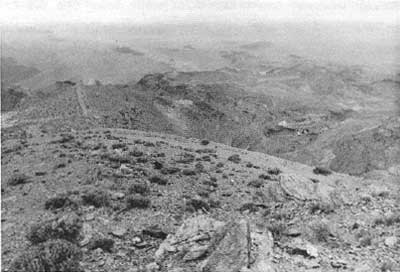
|
| Illustration 112. View of the Big Bell Mine complex from Chloride Cliff, showing its general geographic location. The mine complex can barely be seen in the middle right of the photo where severl black spots are found. The cable road is partly visible in the left middle of the picture, crossing the top of a ridge. The Keane Wonder mine and mill are out of sight, beyond the farthest ridge. 1978 photo by John Latschar. |
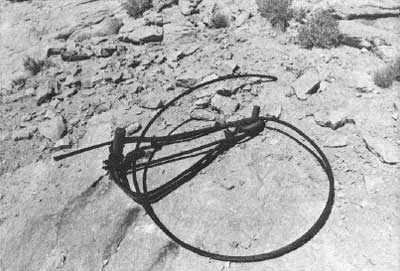
|
| Illustration 113. Detail of one of the anchor points on the cable road. 1978 photo by John Latschar. |
On the opposite side of the ravine from the mill is the major mine area. The mine was developed almost totally by means of short tunnels and adits. Half a dozen of these tunnel entries can easily be seen, most connected by a tramway. The tram cars dumped their loads into an ore bin, after which the ore was carried across the ravine on a short aerial tramway to the ore bin feeding the ball mill. As an example of the kinds of artifacts left behind when mining ceased, a twelve, foot high rock drill stands beside one of the adits with its drill point driven into the rock.
Across the top of a ridge from the mine are the living quarters. Some of these may be the same buildings constructed by the Big Bell Mining Company in 1907, for they roughly match the descriptions printed in the Rhyolite newspapers. A rock wall, approximately fourteen feet deep and thirty-five feet long, surrounds three wood and tin shacks. Two of the shacks are still standing, but one has collapsed. The rock wall was evidently used as a wind break, a precaution which seems justified, for another wooden shack built outside the walls has been completely demolished. In addition, the living area includes a tent platform site, and the inevitable wood and tin outhouse.
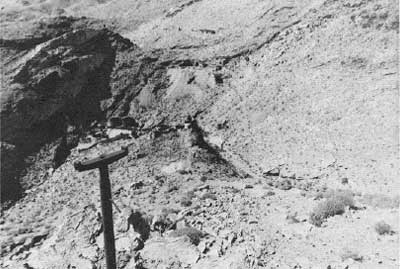
|
| Illustration 114. A closer view of the Big Bell Mine. The mill complex is located in the middle left of the photo, and the dumps of the mining area are visible above the mill. In the top center is the living area, marked by the stone wall surrounding the shacks. 1978 photos by John Latschar. |
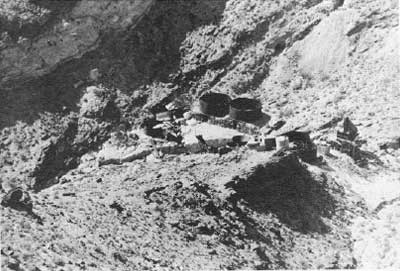
|
| Illustration 115. A more detailed view of the mill complex. The two large tanks dominating the photo are cyanidation tanks, and their tailings may be seen below. The small square structure with a pointed roof in the right center of the photo is the ore bin of the mill, which also acted as the tramway terminal for ore coming from the mine over the short aerial tramway. The small ball mill is located beneath and to the left of the ore bin. 1978 photo by John Latschar. |
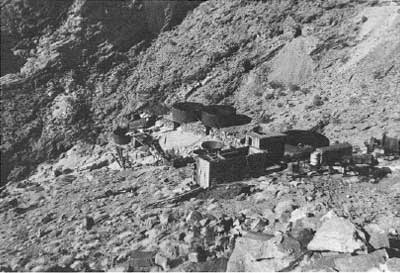
|
| Illustration 116. Another view of the mill structures. The ball mill is seen at the extreme right of the photo, and just in front of it is the Mack truck chassis, used to negotiate the cable road. The two shacks were used for storage and as a repair shop. 1978 photo by John Latschar. |
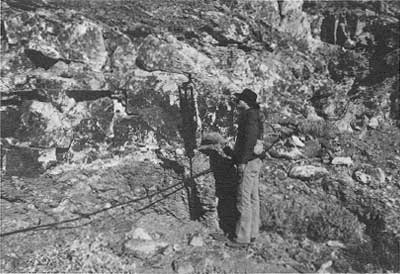
|
| Illustration 117. One of the artifacts left at the mine complex, an eight-foot machine drill. The long bit of the drill is still attached and has been quite solidly driven into the rock. 1978 photo by John Latschar. |
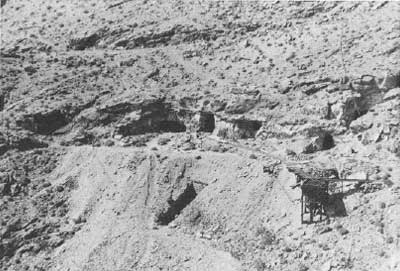
|
| Illustration 118. View of the mine complex, from above the mill. Most mining was done through short tunnels and stoping, and the ore was carried to the bin at the right via a short tramway. From this bin, a short aerial tramway carried the ore across the ravine to the mill complex. 1978 photo by John Latschar. |
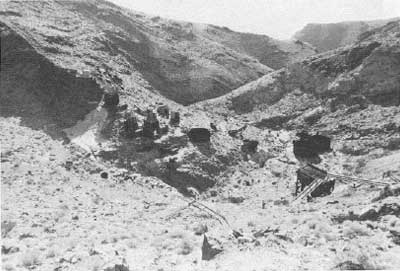
|
| Illustration 119. View of the mine and mill complex from near the living area, showing the relationship between the two. The cables are still stretched between the mine and mill, and may be seen in this photo. 1978 photo by John Latschar. |
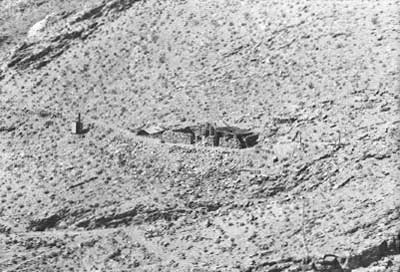
|
| Illustration 120. View of the living area, showing the rock wind break, which protected two of the three shacks built inside. The roof of another shack may be seen to the left, which has been completely demolished by the winds. Just to the left of it is the typical wood and tin outhouse. 1978 photo by John Latschar. |
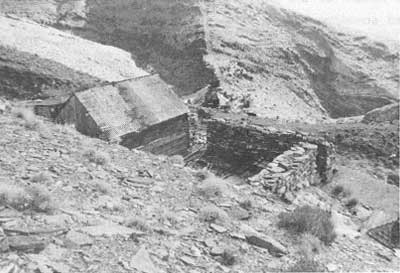
|
| Illustration 121. One of the shacks, from above. The mill may be seen in the distance below the shack, and the cable road leads up from the mill towards Chloride Cliff. 1978 photo by John Latschar. |
In summary, the Big Bell Mill site is extremely interesting, for it presents a vivid picture of a small-time mining operation of the late 1930s. There is little evidence remaining that can be traced directly to the early 1900s, but that is not surprising, since very little mining actually took place during that time. Because of the mine's inaccessibility, it can best be interpreted by some simple signs onsite. However, since the display of mining machinery is extensive, and perfectly exhibits the nature of a depression-era mining effort. The Big Bell mine and mill site will be included as part of the Chloride Cliff Historic District, for nomination to the National Register. Perhaps the best use for the structures and artifacts at the Big Bell would be recording onsite, followed by removal and display elsewhere, on a limited scale. The site itself should be protected, but this probably will not be a major problem, since few if any will want to carry off souvenirs considering the distance and effort involved.
2. Cyty's Mill
Cyty's Mill site contains the remnants of the small three-stamp mill which he imported to the spot in 1911, and a wooden shack. The mill itself consists of a wooden ore chute and ore bin, which fed into the mill. Only the heavy framing timbers remain of the mill, as all the machinery was dismantled and salvaged sometime in the past. Two steel tanks stand next to the mill frame, evidently the water storage facilities, and a short distance away is another tank close to a small spring, with a small tailings pile next to the tank. This latter was probably the spot of a small cyanidation process. The limited amount of tailings indicate that the mill ran for only a short time, and produced a very limited amount of bullion.
Cyty's shack still stands below his mill, and is in relatively good condition. The shack is built upon an elevated and leveled rock platform, and is of wooden construction, measuring about fourteen by twenty-four feet. Unlike most desert shacks, this one had the unusual comfort of finished wooden floors and walls. Finally, across the way from the shack, on the side of a little knoll, are the remains of two rock shelters, used either for living or storage purposes. The walls of the larger shelter are about three feet high, and measure twelve by twenty feet.
In summary, Cyty's Mill is a very interesting site, especially when compared to the much larger Keane Wonder complex less than a mile away. It offers a unique interpretive opportunity, for it represents one of the most prevalent practices of desert mining--the removal of equipment from one site to another as old mines died and new ones were born. The mill at Cyty's site was originally built for the American Mine near Columbia, Nevada. In March of 1910, the mill was purchased by a lessee of the Hayseed Mining Company of Lee, California, and moved to a spot west of Lee, near the Tonopah & Tidewater Railroad. Then, as described above, Cyty purchased the little mill after the Hayseed operation failed, and moved it to its present location. Such transactions involving mining and milling equipment were quite common in the early days of desert mining, and Cyty's mill presents us with an unusual opportunity to document and interpret this practice.
For a combination of the above, along with Cyty's employment for several years as a watchman at the Keane Wonder Mill site, and the opportunity to compare and contrast one of Death Valley's largest and smallest mining efforts, the Cyty Mill site will be included in the National Register nomination for the Keane Wonder Mine and Mill.
Finally, Cyty's Mill is especially interesting due to his personal history as one of the desert's truly eccentric characters, and his story should be told either at the visitor's center or on the site. Perhaps onsite interpretation would be best, for it would give the visitor a chance to see and appreciate the pile of barren rock for which a man was killed.
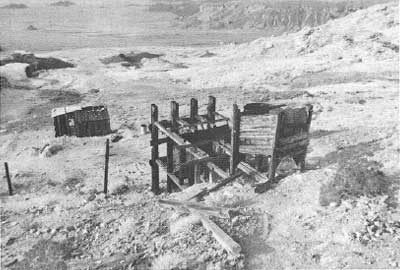
|
| Illustration 122. Johnnie Cyty's three-stamp mill, showing the small ore bin above the mill, and his shack below. 1978 photo by John Latschar. |
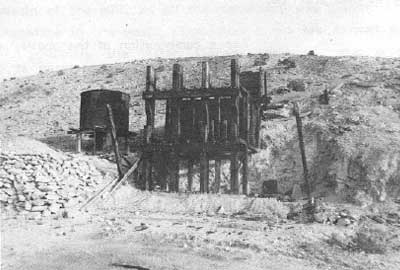
|
| Illustration 123. A closer view of the stamp mill, from the front. The water tank can be seen at the left, and the small concrete engine mounts are visible below and to the right of the mill. 1978 photo by John Latschar. |
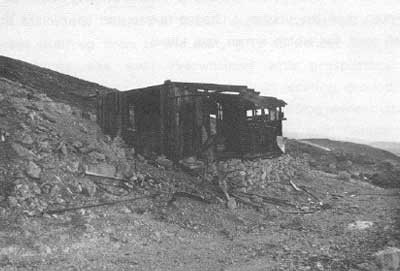
|
| Illustration 124. A view of Cyty's shack, seen from the north. The stamp mill is up the hill to the left, out of the picture. |
5. South Bullfrog Mining District
a. History
With the Keane Wonder strike to the west and the great Bullfrog boom to the east, it is no wonder that the upper Funeral Range was soon overwhelmed with prospectors. Early rushers to the Bullfrog region succeeded in locating ground close to either the Keane Wonder or the Original Bullfrog mines, and as we have seen, some met with success and others with failure. But in this section we are concerned with the later prospectors, who did not arrive in time to obtain "close-in" locations near the two big strikes, and who were thus drawn to the empty area between the Original Bullfrog and the Keane Wonder, known as the upper Funeral Range.
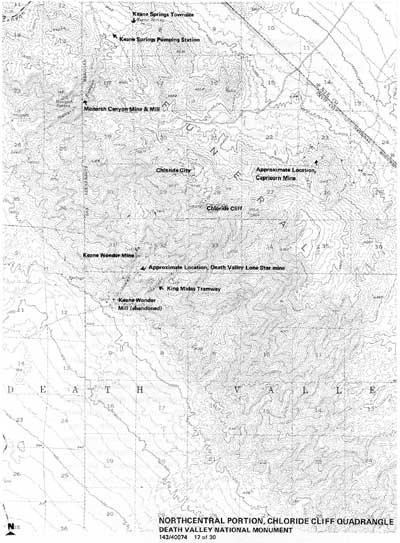
|
| Illustration 125. Map of Northcentral Portion of Chloride Cliff Area. |
The rush was such that in August of 1905, less than a year after the Bullfrog strike, there were so many prospectors in the area that they decided to organize a new mining district, designed to bring an element of order into the numerous conflicting claims which had inevitably built up when hundreds of prospectors were looking over a limited amount of choice ground. Thus, on August 18th, the South Bullfrog Mining District was organized. At a meeting at Keane Springs, a few miles north of Chloride Cliff, the miners of the region met and agreed upon several rules and regulations for the establishment of the new district. C. Kyle Smith, who was later to be shot by Johnnie Cyty, was elected recorder of the district, and was thus given responsibility for keeping the claim and assessment books in order, to prevent future legal or physical struggles over mining claims. In addition, the boundaries of the district were laid out, and were roughly described as being from Surveyor Well in Death Valley, east to the Nevada state line, down the state line to the northeast line of the Echo Canyon Mining District, west to Furnace Creek, and then northwest to Surveyor Well. These boundaries included several well known mines, such as the Keane Wonder, the Chloride Cliff and the Big Bell, and unnumbered prospects and infant mines which had been opened in the past year. Recording fees, including district and county charges, were $2 per claim, and the money was used to reimburse Smith for his pains and expenses of keeping books. Due to the extreme crowding of prospectors into the district, the meeting agreed to severely restrict the time allowed for prospectors to improve their claims, giving them only ninety days from the time of location to perform $100 worth of assessment work, compared to the usual year.
As the rush continued through the fall of 1905, the prospects for the district looked extremely good. The Inyo Independent wrote that "this district has a brilliant future," and the Rhyolite Herald in an understatement, said that "this portion of the country is attracting considerable attention of late on account of the excellent showing made by the Keane Wonder, and property in that section is much sought after." By the end of 1905, as the initial flurry of prospecting settled down somewhat, the mining promoters and money men began buying and consolidating claims and forming mining companies to exploit the mineral wealth which everyone was sure lay just under the surface of the ground. The South Bullfrog Mining District, in the popular term of the day, was a "comer." [39]
As 1906 progressed, the South Bullfrog District continued to boom, and mining companies began to incorporate and begin work on their claims. With the advent of actual mining in the area, the local residents and prospectors, most of whom lived at or near their mines, began to take steps to advertise their district, for everyone realized that in order to keep the investment money flowing in, public exposure was necessary. It was also nice, of course, to have a genuine mine, but until anyone knew whether there were any in the district, public advertisement was the next best step. Accordingly, on March 16th, the South Bullfrog Booster's Club was organized, composed of miners from the area, and an advertisement campaign was begun. In addition, the Booster's Club was directed to look into the annoying fact that a new town, located southeast of Rhyolite, was also using the name of South Bullfrog. In order to limit the confusion of potential investors, a committee was appointed to meet with the new townsite agents and. try to persuade them to change their town's name. The meeting was unsuccessful, but since the town of South Bullfrog quickly died, the matter resolved itself.
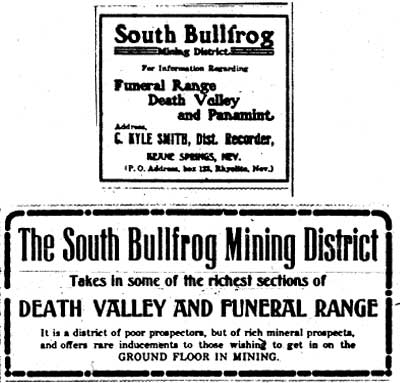
|
| Illustration 126. Two advertisements, as printed in the Bullfrog Minier, for the young South Bullfrong Mining District. The top appeared on January 12th, and the bottom, on March 9th, 1906. |
The Booster's Club also voted to begin work on a new, road from Rhyolite to Chloride Cliff, in order to provide better access to the district for visitors and supply wagons. In the meantime, Richard Willis of Rhyolite started a stage line and burro train between Bullfrog and the town of Keane Springs, which was becoming the heart of the district. The stage line would run twice a week, and the burro train on demand.
Between January and May of 1906, at least nine mining companies incorporated and began work in the district. Numerous 'prospectors were also still hunting for good locations, or else sitting on them, waiting for a higher bid for their potential gold mines. Although the district looked good, the Bullfrog Miner put it back into perspective in late April, when it remarked that with "the exception of the Keane Wonder and the Chloride Cliff mines, but little real active work has been done" in the area.
For the better part of two years, the miners and promoters of the South Bullfrog District plugged along, hoping that sooner or later the one great mine would appear in their midst, which would make everyone's fortune. Unfortunately, exactly the opposite happened. One mine after another looked good, and made plans for shipping ore or for building a mill, only to find out after the shafts and tunnels had bit a little deeper into the mountain, that their ore had pinched out. In addition, the economic troubles of the times plagued the district, for mines were forced to close after the San Francisco disaster of 1906, and more were shut down by the general financial panic of 1907. Without a big mine to pull in the money, the rest of the South Bullfrog mines could hope for little investor support, and few if any of the local promoters were able or willing to develop a mine out of their own pockets.
South Bullfrog District Mining Companies
| Company Name | Date Work Started | Last Date Mentioned |
| California Bullfrog Mining Company | 11 August 1905 | 28 August 1909 |
| Trio Mining Company | 26 January 1906 | 30 September 1908 |
| Golden Horn Mining Company | 26 January 1906 | 13 March 1909 |
| DeForest Mining Company | 9 February 1906 | 29 March 1907 |
| Hartford-Montana Mining Company | 2 March 1906 | 4 May 1912 |
| Calvada Gold Mining Company | 6 April 1906 | 6 April 1906 |
| Highland Boy Gold Mining Company | 7 April 1906 | 21 December 1907 |
| Death Valley Golden Buck M.C. | 13 April 1906 | July 1907 |
| Inyovada Gold Mining Company | 26 May 1906 | 30 April 1910 |
| Vermont Rose Mining Company | 3 August 1906 | 28 October 1911 |
| Lulu Mac Mining & Milling Company | 7 September 1906 | 20 August 1910 |
| Death Valley Gold Mining & Milling | Fall 1906 | 4 January 1907 |
| War Eagle Mining Company | 25 January 1907 | 8 March 1907 |
| South Bullfrog Mining Company | 8 March 1907 | 30 April 1910 |
| Rising Sun Mining Company | 29 March 1907 | 29 March 1907 |
| Death Valley Exploration & Development Company | 12 April 1907 | 30 December 1908 |
| Kentucky Mining & Milling Company | 15 June 1907 | 15 June 1907 |
| Golden Chief Mining & Milling Company | 20 July 1907 | 2 December 1911 |
| Bullfrog Comstock Mining Company | 26 September 1907 | 26 September 1907 |
| Lee Gold Crest Mining Company | 11 October 1907 | 26 February 1910 |
| Bullfrog Midas Mining Company | 21 March 1908 | 11 April 1908 |
| Utopia Consolidated Mining Company | 20 February 1909 | 14 April 1909 |
| Henrietta Mining Company | 24 March 1909 | 14 April 1909 |
| Minerou Mining Company | 10 July 1909 | 10 July 1909 |
One after another, the remaining mines closed during 1907 and 1908, although a few continued the struggle through 1909 and 1910, and two lasted even until 1911. But the longer life of the latter mines had more to do with the subbornness of their owners, rather than of any mineral content in the ground, for none of the mines listed in the table above ever produced any gold. With the exception of a very few hopeful miners, the entire South Bullfrog Mining District was deserted by the end of 1910, and an assessment of the district's boom can only be that it was a total failure. The miners left behind little more than numerous pits and holes around the mountainsides, most of which show little signs of anything beyond preliminary development work, and all of which serve to confuse present investigators who try to pick out a few of the more significant mines from the numerous hales in the ground. [40]
It would be interesting, however, to take a quick look at a few of these South Bullfrog mines, in order to detail the life and death of several of the typical efforts which took place.
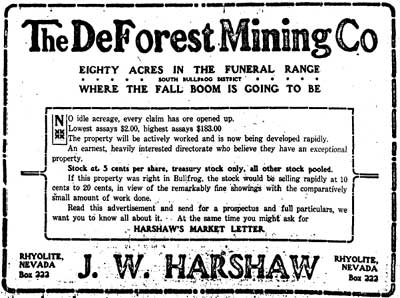
|
| Illustration 127. From the Bullfrog Miner, 1 June 1906. |
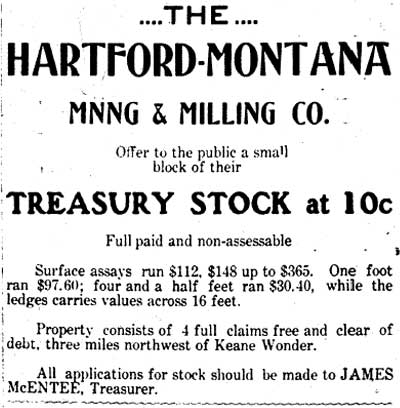
|
| Illustration 128. A typical advertisement for a South Bullfrog District mining company. From the Bullfrog Miner, 5 April 1907. |
b. Death Valley Lone Star Mine
The first claims of the Lone Star group were located in the summer of 1904, shortly after the Keane Wonder strike had stirred interest in the area. Little is heard of them, however, until December of 1905, when the Death Valley Lone Star Mining Company was organized. The organization was rather typical for the time, with a capital stock of 1,500,000 shares being created, 750,000 of which were designated as treasury shares for sale to the general public. The officers, who kept the rest of the shares to themselves, were headed by S. R. Phail, president, and Victor O'Brien, vice president. The company had six claims, described as being just below the Keane Wonder Mine, and two claims in another part of the district. Stock was immediately offered for sale at 104 per share, and large full-page advertisements appeared in the Rhyolite newspapers. Early in 1906, the company began work on its claims.
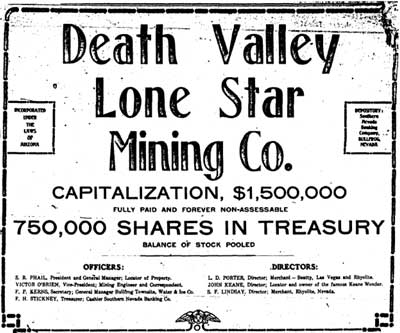
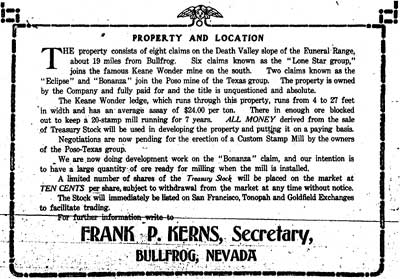
|
| Illustrations 129-130. Top and bottom half of a full page advertisement which appeared in the Bullfrog Miner, 9 March 1906. |
Small strikes were found from time to time, but nothing good enough to warrant calling the Lone Star a real mine. As the Bullfrog Miner, put it, the developments at the property were "interesting, if not sensational." Four men were employed at the mine in April of 1906, and despite the financial distress caused by the San Francisco earthquake and fire, the company reported that it would- "continue work for an indefinite period.". S. R. Phail, the president, tried all the usual tricks to publicize his mine, such as bringing in specimen ore for display at the Southern Hotel in Rhyolite. But despite these efforts, and the fact that Lone Star stock was listed for sale on the San Francisco, Goldfield and Rhyolite stock exchanges, interest in the mine never developed. The Rhyolite papers never reported any trading activity in Death Valley Lone Star stock, and towards the fall of 1906, work at the mine was stopped, probably due to financial reasons. [41]
Early in 1907, the Rhyolite Herald reported that the Lone Star had excellent ore in its mine, and that the company "expected that work will soon be resumed on the Lone Star." The company held its annual meeting in February,. which resulted in new officers being elected. J. P. Nelson, the new vice president, went out in March to examine the property "with the view of resuming operations." Nothing had been done at the property lately, said the Bullfrog Miner, "due to friction of management." But despite the reorganization, work was not resumed until late in December of 1907, when a force of men and supplies were sent out to the mine. Although the immediate purpose of the men was to perform the necessary annual work to enable the company to retain title to its ground, the company announced that it was "the purpose of the management to continue work with a view to placing the property on a paying basis as soon as possible."
But the hopes were soon demolished. The annual work on the property uncovered no new ore leads, and although the Rhyolite Daily Bulletin announced on January 22nd that the mine "has been amply financed and development will be rushed," work stopped in late January and no further work was done on the mine until November of 1908, when Sam R. Phail returned to the property to perform the annual assessment work. Despite the lack of work on the property for over two years, John A. Moffat & Co., one of Rhyolite's leading stockbrokers, felt able to write in October of 1908 that "We recommend this stock as a good speculative purchase." By the fall of 1908, the South Bullfrog Mining District had numerous stocks for sale which could only be described as "speculative."
Although the mine was dead in all reality by the end of 1907, efforts were made from time to time to revive its prospects. The Death Valley Lone Star Mining Company continued to hold its annual meetings as late as January of 1910, and presumably someone attended. Not until January of 1912 did the Rhyolite Herald feel safe to say that "no work has been started, nor does it appear that any is in contemplation on the Lone Star property." Like many others, the Death Valley Lone Star had not made that important transformation from a promising prospect to an actual mine. The transformation was difficult to make when there was no ore in the ground. The Death Valley Lone Star Mine has no historic significance. [42]
c. Capricorn Mine
As noted above, the Capricorn Mining Company was one of the few South Bullfrog District companies ever to ship any ore from its mine. In this respect it was unusual, but a short description of a marginally productive mine would perhaps be illuminating. The first notice of the Capricorn was in November of 1907, when J. P. Burns, its locator, gave up trying to develop it on his own, and began looking for buyers or lessees. It took him several months, but, in February of 1908 Burns leased a block of his claim to John Anglin and I. Peterson. The two men went to work at once, and soon reported that they had excellent showings.
In the meantime, Burns also continued to mine, and perhaps inspired by the example of his tenants, announced in March that he had found some ore. The luck of the first lessees in turn inspired more miners to try their luck, and by the end of March, Burns had let leases to L. J. Lock and Alfred Jones, another to Captain E. P. Miner and a third to Tom G. Murphy. All the leases were for blocks of land 200 feet square, and Burns continued to work on the unleased portions of his claim, taking out high grade ore for sacking. By mid-April he had an estimated $2,000 worth of ore on the Capricorn dump.
Through the rest of the spring and summer, Burns and his lessees continued to work on their respective portions of the Capricorn mine, and yet another lease was let to the Barton brothers in June. The Bullfrog Miner reported that twenty-five men were working on the combined portions of the Capricorn property in mid-June. In July, Captain Miner, dissatisfied with the ground covered by his lease, entered into a deal with Burns whereby the two men became partners in the development of another section of ground. In late July, they made the first shipment from the property, two tons of silver ore which they estimated to be worth $200 per ton.
When the smelter returns were received several weeks later, their prediction turned out to be remarkably accurate, as the ore was assayed at $195 per ton. The expenses involved, however, pointed out the difficulties which always faced operators of remote desert mines. Freight charges to get the ore to the Goldfield smelter had cost $32.26, smelter charges were $60 arid sampler charges were $50. Considering that the smelter had succeeded in recovering 95 percent of the ore content, Miner and Burns were left with a mere $289.18 profit from their first ore shipment. The men estimated that it would take them two months to assemble another such shipment, which indicates that they were willing to work for a little over $72 each per month. Unionized miners, such as those at the Keane Wonder Mine, earned more than that.
Undaunted, the men began another shaft on the property, in a more promising location, and continued to work. By the middle of August they were again sacking high grade ore for shipment, and on September 9th, a second shipment was made, consisting of 7,200 pounds of ore. This shipment, however, was not as rich as the preceeding one, and settlement with the smelter were made at an assayed value of $167 per ton. If freight, smelter and sample charges had not changed since July, Miner and Burns received a net profit of $224 for their second shipment, to split between themselves.
In October of 1908, since the various leases had proved that there was ore in the Capricorn Mine, Burns finally got his wish, and a group of capitalists financed his mine and incorporated the Capricorn Mining Company. A Mr. San Francisco of Cimarron, Kansas, was named as president of the company, and Captain Miner and J. P. Burns were listed as joint vice-presidents. After the new company was formed, all the previous lessees were denied any extensions of their leases, with the exception of Captain Miner, who continued to act both as a company officer and as a lessee from that company. Advertisements were placed in the local papers, and Capricorn stock went on the market at the initial price of 10 per share.
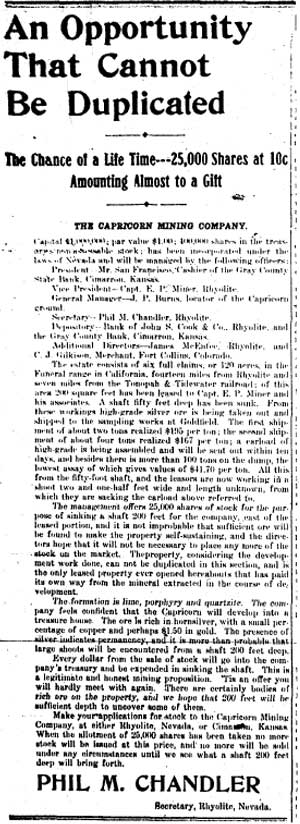
|
| Illustration 131. "The Chance of a Life Time," from the Rhyolite Herald, 25 November 1908. |
Development was initiated by the company, and in November the Rhyolite Herald reported that the company had eleven tons of ore ready for shipment. In order to avoid the high freight charges to Goldfield, Miner decided to ship the ore to a smelter at Needles, California, where he could get a better deal. In late November of 1908, ore teams began hauling the ore into the railhead at Rhyolite. With the mine operating and taking out ore, investors began to be interested, and the local papers, never loath to sing the praises of a local mine, began to boost the Capricorn. "Many people are now aware," said the Rhyolite Daily Bulletin that the South Bullfrog District had one of the "richest silver bearing mines in the United States. Should the quality of ore now being taken out continue with depth," the paper added, the Capricorn would be a "worldbeater." The company, in the meantime, announced that its eastern office, at Cimarron, Kansas, was selling stock as rapidly as it was received, and thanked the Rhyolite Herald for the effectiveness of the only advertisement placed in the state of Nevada. [43]
By late December, the Capricorn shipment had been assembled at Rhyolite, and amounted to a twenty-five ton carload of ore, estimated at $200 per ton. In mid-January of 1909, Captain Miner received returns on the shipment, and the result was not very impressive. His ore had been assayed only at $132.50 per, ton, and after deducting freight and smelter charges, his net profit was only $2,158.18, out of which wages and expenses of mining upon the company account would have to be taken. As a final note for 1908, it is interesting to observe that the Capricorn Mining Company was considering installing a horse-powered whim at its shaft, to replace the crude hand windlass in use up to that time--the company was still in the very early stages of development.
But the company kept on trying. The working staff was increased in early January of 1909, and advertisements for the mine again appeared in the newspapers. J. P. Burns was elected as the new president of the company, replacing Mr. San Francisco, and he immediately announced that a gasoline hoist would be installed by February 1st, at which time the company would start mining in earnest.
But Burns' promise was not carried out, and in March of 1909, Captain Miner was the only man working on the property. The company returned its miners to work in April, but they only remained until May, when once again they were laid off. Miner made another shipment, consisting of eight tons of ore, in early May, but smelter returns were not released to the papers. After several more months of idleness, the executive committee of the Capricorn Company met in late July, and reluctantly approved a decision to borrow money to continue the development work at the mine. But before, that could happen, they changed their minds, ad decided to close down the mine until fall rather than to "sustain liabilities Which would under present financial conditions necessarily would be very burdensome."
But the mine was closed longer than until fall. In October, J. P. Burns returned to Rhyolite and announced that "efforts are being made to resume operations," but the lack of finances made his hope futile. The next notice of the company comes in February of 1910, when an elaborate and quite complicated scheme of financing was announced, whereby the Capricorn would receive money for mining costs in return for a thirty-year bond upon its property. After examining the mine, however, the potential bonding firm, the Granite Securities Company of Los Angeles, decided note to go through with the deal, and the mine lay idle. Finally, in October of 1910, one John J. Barket was given a two-year lease on the entire Capricorn property, but he never made good on his lease, and the Capricorn Mine died a silent death.
Total production of the Capricorn Mine, taking the announced figures at face value, was a little over $5,000. Of this, net profits, once freight and smelter charges were deducted, were around $3,500, from which salaries and supplies must be deducted. Considering the number of years and the number of men working the mine, nobody, obviously, got rich from the Capricorn Mine. Indeed, most men would have earned far more money by spending the equivalent period of time employed as a shift miner in one of Rhyolite's bigger mines. But shift miners never get rich, and some mine owners do, and therein lies the compelling pull of the mining game. The Capricorn Mine has no historic significance. [44]
d. Howard Little Exploration Company
In direct contrast to companies such as the Death Valley Lone Star and the Capricorn, which made legitimate efforts to mine the ores of the Funeral Range, the South Bullfrog Mining District had its share of outright frauds. One such was the Howard Little Exploration Company, which was more unique in that its scheme was detected and publically exposed, then for the mere fact that it was perpetrated.
The company made its first appearance in September of 1908, when J. F. Howell, its promoter, managed to get an article printed in. the Bullfrog Miner. The nature of the article, which was little more than an advertisement, together with the quite obvious fact that the Miner editor had never heard of the company before printing the article and had not seen the property involved, says much for mining camp journalism. At any rate, the Howard Little Exploration Company, according to Howell, had a group of claims eight miles southeast of the Keane Wonder Mine. Work had been progressing at the mine for some time, and the company had a shaft down 104 feet into the ground, and was employing five men. One hundred sacks of high grade ore had been taken out of the mine for future shipment, and the company had ordered a hoisting plant and had begun grading work for the placement of that hoist. The company was headquartered in Boston, and, incidently, had stock for sale.
On the strength of that article, which was much more effective than a paid advertisement would have been, Howell sat back and watched stock subscriptions come in. His game lasted until December of 1908, when the scheme collapsed. All the Boston stockholders were not as easily fooled as Howell had hoped, and a group of them pooled their money to send an attorney and a mining engineer to inspect the mine which they were financing. Upon arrival in: Rhyolite, the two men went out to Howell's mine and found that things were not quite as Howell had said. Instead of a 104-foot deep shaft, they found merely an exploration hole. No one was working at the property, and no one had been working there since last March, before Howell obtained title to the property. No hoist had been ordered, and no grading work had been done for a hoist. In short, the whole thing was a fraud, and Howell had bilked the investors out of about $10,000. His scheme had been simple, for he had been drawing upon the company treasury to pay wages to non-existent miners, and to pay for non-existent lumber and supply bills. Happily for the Boston stockholders, Howell was immediately arrested and put behind bars, and as much of the investors' money as could be, recovered was returned to them.
Howell was unusual, in that his fraud had been detected in time to recover some of the investors' money, and in that he had been put in jail. The Bullfrog Miner, realizing that this was the case, hoped that his imprisonment "will serve as an object lesson" for other con men "that may be lurking mid the sagebrush of these parts." The Miner, also recognizing that it was largely responsible for the success of Howell, printed a long apology.
The Bullfrog Miner confesses to some duplicity in the matter. Howell's story was printed in these columns in the issue of September 19 last, and if the currency given to Howell's report assisted the faker in getting a single cent from the Boston stockholders we are very sorry for it, even though all the statements were qualified as those of Howell and not of the paper.
The Miner has always aimed to keep faith with the public in its mining reports. It enjoys a reputation for conservatism. This reputation is prized highly. It is the purpose to continue to merit the public confidence and good will.
But the Miner is not immune from imposition. No paper is. Howell worked the reporter just as he worked the Bostonians. There was no reason for doubting the correctness of the "dope" given to the scribe, and it was impossible, owing to the great distance to the "mine," to verify Howell's story.
But the damage had been done. Not only were certain Boston stockholders swindled out of their money, but the entire Bullfrog District suffered as well. Frauds such as these gave Nevada mining investments a bad image, particularly those in the area where the fraud was carried out. In addition, the honesty and reliability of the Bullfrog Miner was tarnished, which made its coverage of the rest of the mines in the area that much more suspect. All honest men, from the mine owner to the storekeepers of a district, lost when such a swindle was carried out, and it is no small wonder that feeling ran so high. The Howard Little Mine has no historic significance. [45]
e. Monarch Canyon Mine
1. History
This mine, which is one of the few of the South Bullfrog District mines to have left some physical remnants, is rather frustrating to trace. It was never a large enough operation to be incorporated into a mining company, or to have a common name, and is thus referred to today by its geographic location, in the heart of Monarch Canyon, about two miles southwest of Keane Springs.
First notice of this property was in December of 1905, when A. K. Ishmael, its locator, closed a deal with Frank Durham and a Mr. Gaylord of Los Angeles (probably the same Gaylord who was briefly associated with the Keane Wonder property). Durham and Gaylord obtained a bond and lease on the mine, with an option to purchase it from Ishmael for $20,000. Work began shortly after the deal was closed, and by January of 1906, a tunnel had been extended sixty feet into the mountainside on the Indian claim, the major claim of the group. Work was rather brief, however, and ceased sometime shortly after April of 1906, probably due to the effects of the San Francisco disaster. No further notice of the mine can be found until 1909.
Sometime in the interval between the spring of 1906 and 1909, the mine was sold by Ishmael to the Keane Springs Mining Company, an outfit which never worked the property. Then, in March of 1909, Ishmael procured a 21-year lease on the property from the Keane Springs Company, with the financial backing of Frank P. Raridati. The Indian claim of the mine was described at that time as having a seventy-foot tunnel, which indicates that hardly any work had been done between 1906 and 1909. But preliminary assays showed that the mine had $18 to $20 ore in sight, and three men were sent to start work on the property.
Ishmael took a partner named Richard E. Clapp, and the two men proceeded to develop their mine. Water near the sight was of adequate supply for a small mill, and after two months of digging the men decided that milling tests were in order. They were not thinking of a large mill, since their mine was not large, but rather of putting in a small one in order to save themselves the backbreaking labor of packing out raw ore from the mine to a Rhyolite mill. Among other improvements, Ishmael and Clapp built an assay office at their property, in order to test their ores, but the office burned down only a month after it had been completed. Nevertheless, the men stuck to their mine, and reported. good progress being made in August of 1909. Four men were employed at the site, and two tunnels were being driven, one to a length of sixty-five feet and the other to one hundred feet.
Such a small operation did not deserve much space in the Rhyolite newspapers, but periodic reports were printed, especially in the spring of 1910, when Ishmael and Clapp decided to build a small mill. In May of that year, the two men purchased a small Nissen reduction plant, and the machinery soon began to arrive. The men also bought the Hoffman House swimming pool at Rhyolite, which had closed, and tore it down and used the lumber to house their new milling, plant. By late June, a pipe line from a local spring had been completed to the mill site, and foundations were being laid. Late in August, the mill was completed and began to operate. It was a small one-stamp mill, and combined a concentration and amalgamation process of ore reduction. Cyanidation was not a part of the mill process, but could be added later.
The mill was reported to be running well in mid-September, and in October several small bars of crude bullion were sent to the Selby smelter. No returns were announced. Clapp and Ishmael, in Rhyolite for a periodic supply trip, admitted that there were some minor difficulties with the mill, but stated that on the whole it was running well. But for some reason, the mill was not regularly run after October of 1910.
Between them and April of 1911, the mine and mill were idle, and in April the Rhyolite Herald reported that work on the mine would resume soon, as the property was to be amply financed and the small mill utilized. Such, however, was not the case. The Montana-Hartford Mining Company, another South Bullfrog outfit, used the mill in June to test some of its ore, but that was its only use in all of 1911.
Although I. K. Ishmael gave up and left the country, his former partner, Richard Clapp, was not yet ready to give up. In February of 1912, Clapp reported that the Indian claim was very encouraging, and that developments would continue on the property. In May, Clapp again reported that he had a new ore shoot, and that he was in touch with eastern parties and hoped to start up on a large scale soon. In the meantime, he said, he would continue with steady development work on his own.
But with the demise of the Rhyolite Herald Rhyolite's last newspaper, in June of 1912, we come to an end of our printed detail regarding the mine. Given the general history of other such mines in the area, it is doubtful that Clapp was able to do much more with his property. Physical evidence at the site indicates that if the mine was worked at all after June of 1912, it was not worked extensively, or for a very long duration. [46]
2. Present Status, Evaluation and Recommendations
Ishmael's and Clapp's little mill still stands in Monarch Canyon. It consists of a one-stamp Nissen crusher, built by Fairbanks & Morse, with a patent date of November 29, 1904. Most of the machinery and controls of the mill are still extant, including a one cylinder engine, two large wooden flywheels, and miscellaneous controls. The mill is built on a concrete pedestal, with a small wood and tin building around the engine and mill machinery. The structure, however, is largely demolished, due to wind and weather.
Above the mill, which is situated on the floor of the canyon, the rest of the complex rises up the steep side of the canyon wall. An ore bin is directly above the mill, and a long ore chute connects the bin to an ore tipple perched high above the mill site. From the tipple, portions of the old tram track may be followed around a bend to the mine itself, which consists of a tunnel adit and a small stoped area. Other remnants on the site include a collapsed shack near the mine, the foundation for a tent or frame building near the ore tipple, and what appears to be the stone ruins of a powder house near the mill.
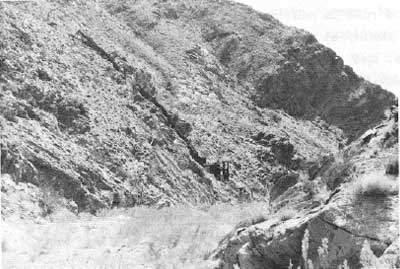
|
| Illustration 132. Mill ruins in Monarch Canyon. The ore tipple is out of sight above the ore chute, and the mine is around the corner from the tipple, towards the top center of the photo. 1978 photo by John Latschar. |
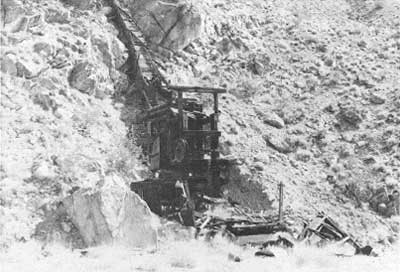
|
| Illustration 133. Closer view of the mill mechanism. The flywheel which shows prominently was connected to the one stamp of the mill, and was powred by the engine, housed in the small building below. Most of the debris on the ground is portions of the engine house and mill coverings, which have been blown off. 1978 photo by John Latschar. |
The road to the mill has been washed down from the side of the canyon wall, but a one-mile hike from the end of the road to mill is not overly strenuous. The site is interesting and useful, as it depicts a small-time mining operation of the early 1900s, and should be exploited for interpretation, either on the site or elsewhere. The site is not of National Register significance. The mill machinery, however, has both historic and interpretive value, due to its rare Nissen-type character. Thus the mill equipment should be protected and preserved, either on the site or in the Monument's museum.
f. King Midas Claim
About half a mile to the east of the Keane Wonder. tramway, as seen on the Chloride Cliff topographic map, is located another aerial tramway which has puzzled visitors for many years. The second tramway, however, is not and has never been connected with the Keane Wonder Mine, and although it was not connected with the South Bullfrog Mining District either, this opportunity will be taken to clear up some of the past confusion.
The King Midas Claim, which covers the ground over which the tramway passes, was located and worked between 1949 and 1955 by Joseph Harris, who at one time called his mine the Keane Wonder Extension. Since Harris' mine was located high on the side of the Funeral Mountains, he constructed an aerial tramway from the mine down to the canyon floor below, in order to extract his ore. The tramway was 3,000 feet in length and descended from an elevation of 2,800 feet at the mine shaft down to 1,700 feet in the canyon floor. The tramway originally consisted of galvanized cables, towers, and a hoisting mechanism. It is still partially in place, but the power cable, tramway buckets and loading facilities are missing. An ore bin at the foot of the tramway is in disrepair. In 1975, Harris estimated that total production from his mine between 1949 and 1955 had been 300 tons of ore, and from all evidence the mine and tramway have been idle since 1955.
Although the King Midas claim appears to have no historic significance, neither the mine site or the upper portions of the tramway were examined for this study. Such an examination must take place before a final recommendation can be made for this site. [47]
g. Keane Springs and Townsite
1. History
As one of the main watering spots of the northern Funeral Range, Keane Springs was always important in the life of the South Bullfrog Mining District. Indeed, the use of the springs predates the district itself, since one Eugene Lander had a claim to the springs as early as 1878, presumably to sell its water to the Franklins who were working on their Chloride Cliff Mine. But Keane Springs saw its peak of activity during the Bullfrog mining boom.
As soon as miners and prospectors began to enter the area, Keane Springs was recognized as a major source of good water. During the summer of 1905, water was packed from the springs to the Chloride Cliff mines; as well as several other small mines in the region. As the boom continued, and more and more prospectors came into the area, the Springs also took upon a commercial and social life as a business and gathering place for the district. As early as February of 1906, S. A. C. Nelson opened the Death Valley Mercantile Company at Keane Springs, undoubtedly in a large tent, and retained C. Kyle Smith, the district recorder, as clerk of the store. In March of 1906 work was started on a wagon road from the springs to Chloride Cliff, some three miles away, and during the same month, the Kimball brothers of Rhyolite established a stage line from Rhyolite to Keane Springs, to serve the passenger and mail needs of the South Bullfrog District.
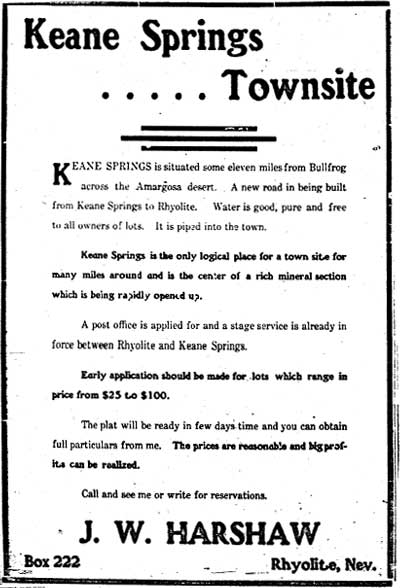
|
| Illustration 134. Advertisement from the Bullfrog Miner, 20 April 1906. |
By mid-April of 1906, the convenient location of the springs, as well as its good flow of water, caused a group of promoters to put their heads together and start the Keane Springs townsite. The town was promoted by the Keane Springs Land Company, and lots were put up for sale. Advertisements appeared in the Rhyolite newspapers, and the town was described as containing a boarding house, a store and a saloon. Since the actual site for the town was located a short distance from the springs, a pipe line was laid directly into the townsite, and all lot purchasers were guaranteed an ample supply of water at their doorsteps. Lots were advertised from $25 to $100 apiece, and a post office was applied for. Total acreage claimed by the townsite company was estimated at between 100 and 120 acres.
By late May, when the townsite was less than a month old, further improvements were noted. The springs were cemented in, in order to prevent pollution, and a pipe line was laid under ground for 500 feet to the center of town, with another 150-foot line being put in to bring water to a reservoir being built. A new road was being cut, which would eliminate much of the roundabout travel through the Funeral Range between Rhyolite and Keane Springs, and in addition to Kimball's stage tine, a regular burro train service was established to supply the needs of the inhabitants. The town at this time was described as having a store, a boarding-house, two offices, a saloon, a corral, a stable. and several tent houses. Surveying for the purpose of obtaining a patent was in progress. Work continued through the summer of 1906, and by September streets had been cleared and more tent houses erected for rent. A new frame office building, the town's first, had been completed, and although the post office was not yet approved, the postal authorities were said to be favorable towards the proposal.
But by the fall of 1906, Keane Springs had already seen its height. Many of the major mines of the region, such as the Keane Wonder and the Chloride Cliff, established their own living camps, and the minor mines never got off the ground. Chloride City became a competitor for the supply center of the district, and Keane Springs slowly declined back into a favorite watering hole, an occasional stopover for travelers and prospectors. The town, like so many of its ilk through the desert mining regions of the west, had died before it was really born.
The subsequent history of Keane Springs is one of the long periods of idleness, followed by short bursts of activity. As noted above, the Keane Wonder Mining Company purchased Keane Springs sometime around 1907, as a hedge against the mill's recurring water problems, and maintained a watchman at the property for several years, in order to protect its potential water source. A couple of prospectors were still living at the springs in 1909 in crude tent houses, but even they were washed out by a destructive cloudburst that fall. In 1910, the springs were developed by the Pennsylvania Mining & Leasing Company, which was attempting to, increase the water supply for its little one-stamp mill below Chloride Cliff, but that effort was short-lived.
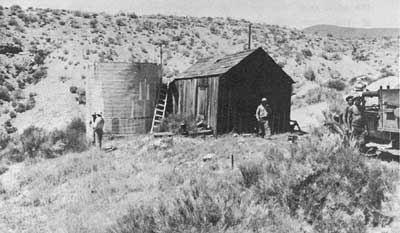
|
| Illustration 135. Ca. 1935 photo of the Keane Springs pumping station and water tank, built by the Coen Corporation between 1935 and 1937. The old Keane Springs townsite is across the low hill behind the pump, towards the top right of the picture. Photo courtesy of Death Valley National Monument Library, classification 622.1. |
Between 1911 and 1912, W. W. Wilson, who listed his residence as Keane Springs, planted "all kinds of garden vegetables," in an attempt to start a truck garden, probably for sale to the small core of miners left in the area. His effort was also short-lived. Following the departure of Wilson, the springs were relatively undisturbed until the 1935-1937 years, when the Coen Corporation began mining at the Big Bell. In connection with that mining effort, improvements were made at the spring, including the installation of a large pump house and engine, and a galvanized iron holding tank. Pipe was laid from the spring up to Chloride Cliff and then back down to the Big Bell Mine, with the pipe line generally following the Keane Springs-Chloride Cliff trail, and then the cable road from the Cliff down to the mine. After the demise of the Coen Company's efforts in 1937, the equipment was abandoned. [48]
2. Present Status, Evaluation and Recommendations
The most prominent remains in the vicinity of Keane Springs today are the water tank and the ruins of the pumping machinery installed by the Coen Company. The pump was powered by a diesel engine, was manufactured by the Fulton Engine Works of Los Angeles, and has three pumping cylinders. The water tank is approximately ten feet high. Pipes from the pump run in two directions, and may be traced along the road from Keane Springs most of the way up to Chloride Cliff and from there down the side of the cable road to the Big Bell Mine. In the other direction, the pipes can be found leading towards the Keane Springs townsite, which is nestled in a small wash among the low hills of the Funeral range plateau. Much of the potential of the townsite was lost through the flood of 1909, but several level tent platform sites remain, some of which have low retaining walls still standing. No more than seven such sites can be found, indicating the destruction of the flood and the fact that the townsite never prospered. The setting, however, is quite picturesque, and since the townsite can be reached by passenger cars, could prove quite an interpretive attraction. A brief story of the short life of this ill-fated mining camp would make an interesting contrast to the more permanent camps, such as Chloride City, and the real boom towns of the early 1900s, such as Rhyolite.
Although the site is interesting, its brief life and lack of any real contribution to the history or development of the area do not qualify it for National Register consideration.
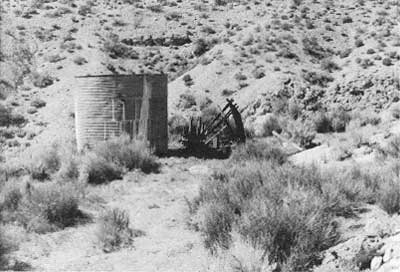 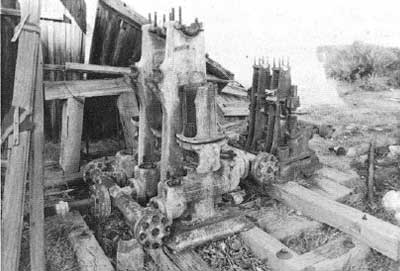
|
| Illustrations 136-137. Ruins of the Keane Springs pumping machinery in 1978. Bottom: Close-up of the ruins of the pump. 1978 photos by John Latshcar. |
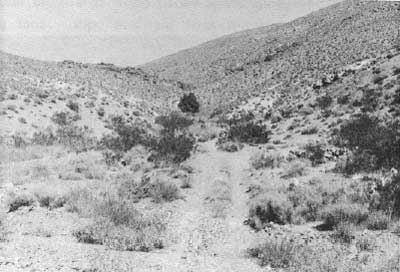 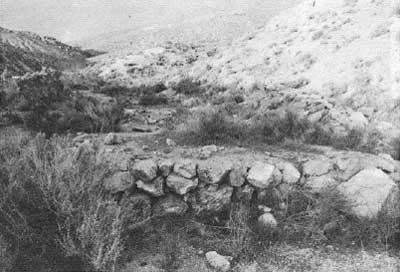
|
| Illustrations 138-139. Top: The Keane Springs townsite area began about where the road disappears in the middle of the photo. The main living areas appear to have followed the bottom of the shallow wash, which was not particularly good planning in a desert environment with its occasional flash floods. Bottom: A closer view of the same wash, showing one of the larger remaining leveled tent sites. 1978 photos by John Latschar. |
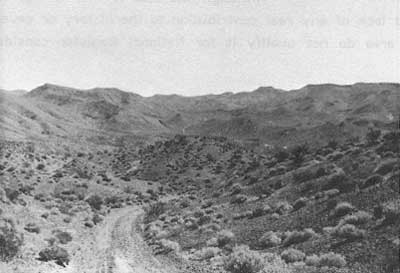
|
| Illustration 140. A typical view of the northern Funeral Range, in the vicinity of Keane Springs. The townsite is located to the left of the road, about a half a mile, and the springs are just beyond the low hill in the foreground. The Keane Spirngs-Chloride Cliff trail may be picked out in several places, winding towards the top of the picture. Chloride Cliff itself is located just below the highest range of mountains in the extreme background. 1978 photo by John Latschar. |
6. Echo-Lee Mining District
a. History
In the southern part of the Funeral Range lies another miners! district which boomed during the great Bullfrog years. From the former site of Schwab on the west side of the range, this district paralleled a line drawn east and northeast through Echo Canyon out to Lee, California, on the east side of the mountains, and on across the Nevada state line into the Amargosa Valley. Although this mining district covered portions of both California and Nevada, the greater part lay in California, Since the Death Valley National Monument boundary runs along the state line in this area, this section will deal primarily with that portion of the mining district which lay within California and the Monument boundaries.
The first locations in the area are credited to Old Man Finley, a veteran desert prospector, who traced his connections back to the days of Breyfogle. Finlay had accompanied Breyfogle on several of his futile searches for the Lost Breyfogle mine, and during one of those trips in the late 1800s, noticed and located several gold prospects on the east side of the Funeral Mountains, near the Nevada state line. His locations, however, lay neglected until the impetus of the Bullfrog rush hit the region. Then, accompanied by Richard and Gus Lee, two brothers from another old desert family, Finlay relocated several prospects in November of 1904 and the early months of 1905.
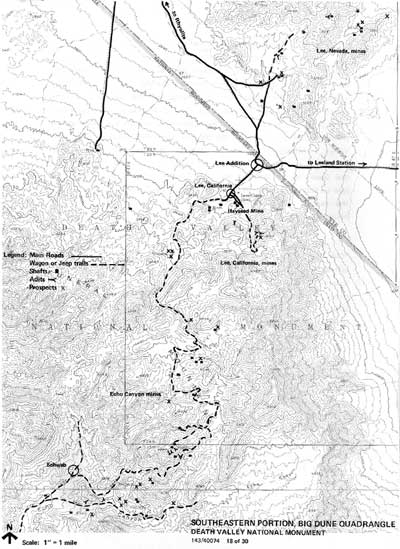
|
| Illustration 141. Southeast portion of Big Dune Area. |
At about the same time, other prospectors were beginning to wander into the southern Funeral Range, as the splash caused by the Bullfrog strikes sent ripples flowing out in all directions through southern Nevada and southeastern California. Between January and March of 1905, Chet Leavitt discovered a gold prospect on the western side of the Funerals, in Echo Canyon. When the news of these two strikes hit the booming towns of Bullfrog and Rhyolite, a minor rush to the southern Funeral Range began, as those prospectors who were too late to cash in on the Bullfrog District began to search elsewhere for their gold. Within a short time, more locations were made between Leavitts strike on the west and Finlay's and the Lee brothers' on the east.
By March of 1905, enough prospectors had filtered into the area for a new mining district to be created, and on the 31st of that month, the first movements to establish the Lee Mining District had started. A few months later, in October, a similar condition existed on the west side of the Funerals, and the Echo Mining District was organized. The two districts, which soon merged and became known as the Echo-Wee Mining District, had boundaries which can roughly be described as the Amargosa Valley on the east, the South Bullfrog Mining District on the north, Death Valley on the West, and Furnace Creek wash on the south. By October of 1905, interest in the new district was high, but although the Rhyolite Herald reported that "considerable work" was being done, the boom was still in its beginning stages. [49]
But in 1906 the action began to heat up By the end of January two companies had begun to work on the Lee side of the district and six companies on the Echo side. Preliminary efforts were begun to improve the communications of the district, especially those on the Echo side. Since anyone wishing to reach the Echo District had to travel from Rhyolite west through Daylight Pass, south down the Death Valley floor, and then back east up Echo Canyon, work on a road to cross the Funeral Range from the Lee side of the district over into the Echo side was begun. As time went on, and more and more locations were made along the mountains between the two sides, such work became easier.
By the end of April, 1906, when two more companies had begun operations on the Lee side and two more on the Echo side, the district was beginning to boom. The new railroads coming into Rhyolite kept a dose eye on this new activity, and the Tonopah & Tidewater in particular made it known that their line would hug the east side of the Funerals, in order to be in the best position to capitalize upon the new mines of the Echo-Lee and South Bullfrog districts. The Rhyolite newspapers were also well aware of the amount of business which new mining districts would bring to their town, and several editorials specifically pointed out this tact.
As the summer and tall of 1906 progressed, it became apparent that enough mineral content was present in the southern Funeral Range for the new mining district to be there to stay. By the end of that year, another company had begun work on the Lee side of the range, and six more had begun on the Echo side, making 19 companies in all working in the new, district. As the population swelled, several major problems surfaced, two of the most important of which were the troubles in communication between the mines of this remote region, and the lack of water. The miners banded together to solve both these problems, with subscriptions taken up to drill a well along the road from Rhyolite into the Lee area, and a similar contribution being taken to fund the building of a road all the way from Rhyolite, through Lee, to the Echo Canyon side of the range. By the end of 1906, both projects were underway. [50]
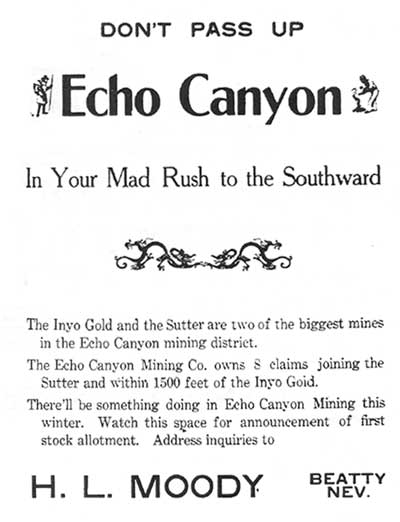
|
| Illustration 142. One of the earliest adverisements for the Echo Canyon mines, which appeared in the Rhyolite Herald of October 12, 1906. |
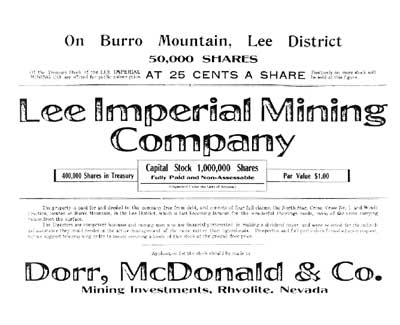
|
| Illustration 143. A later advertisement, which appeared in the Rhyolite Herald of December 21, 1906. |
PARTIAL LIST OF LEE, CALIFORNIA, MINES
| Name | Date First Mentioned | Date Last Mentioned |
| Hayseed Mining Company | 5 January 1906 | 6 January 1912 |
| Tenderfoot Mine | 15 January 1906 | 9 December 1908 |
| Honeysuckle Mining Company | 23 February 1906 | 3 August 1907 |
| Lee Hidden Treasure Gold Mining Company | 20 April 1903 | 2 December 1911 |
| Bullfrog Echo Mining Company | 1 October 1906 | 15 February 1907 |
| Honeysuckle Extension Mining Company | 24 January 1907 | 3 August 1907 |
| Lea Gold Grotto Mining Company | 25 January 1907 | 6 November 1909 |
| Flapjack Mine | 1 February 1907 | 28 January 1911 |
| Lee Whale Mining Company | 1 March 1907 | 25 May 1909 |
| Lee State Line Gold Mining Company | 1 March 1907 | 8 May 1908 |
| Lee Cold Crest Mining Company | 15 March 1907 | 3 August 1907 |
| Lee Buster Mining Company | 5 April 1907 | 15 November 1907 |
| Daddy Lee Mining Company | 5 April 1907 | 24 May 1907 |
| Georgia Lee Mining Company | 5 April 1907 | 10 December 1908 |
| Nero Mining Company | 26 April 1907 | 8 August 1908 |
| Jumbo Consolidated Mining Company | 3 May 1907 | 8 November 1907 |
| Ducks Mine | 10 May 1907 | 27 April 1912 |
| Hayseed Extension Mining Company | 8 June 1907 | 3 August 1907 |
| Lee Bank Mining Company | 6 July 1907 | 2 December 1908 |
| Utopia Mining Company | 6 July 1907 | 28 December 1907 |
| Gold Shield Mine | 3 August 1907 | 11 January 1908 |
| Peerless Lee Mining Company | 3 August 1907 | 6 December 1907 |
| Pumpkin Mining Company | 3 August 1907 | 2 December 1911 |
| Lee Florence Mining Company | 24 August 1907 | 24 August 1907 |
| Lee Comstock Mining Company | 14 September 1907 | January 1908 |
| Chambers Mine | 2 September 1908 | 10 September 1910 |
PARTIAL LIST OF LEE, NEVADA, MINES
(Outside Death Valley National Monument Boundary)
|
Anna Mine Lee Bonanza Mining Company Apache Mine Lee Bonanza Extension Mining Company Blue Grass Mine Lee Consolidated Mining Company Bullfrog View Mining Company Lee Mines Company Cala-vada Mining Company Lee Mohawk Mining Company Calvin Mine Lee Nevada Mining Company Combination Mining Company Lee Princess Mining Company Cornucopia Mine Lee Virginia Mining Company Frisco Mine North End Mining Company Goldstone Mining Company Swan Hilda Mining Company Grandee Mine Swan Hilda Annex Mining Company Greater Nevada Mining Company Skookum Mining Company Lee Bell Mining Company |
PARTIAL LIST OF ECHO CANYON MINES
| Name | Date First Mentioned | Date Last Mentioned |
| Inyo Gold Mining Company | January 1905 | 27 January 1912 |
| Bradshaw & Paymel Mine | 15 March 1905 | 27 April 1912 |
| Sutter Mine | 17 November 1905 | 1 March 1907 |
| Sunnyside Mining Company | 5 January 1905 | 14 August 1909 |
| Nellie. B. Mine | 12 January 1906 | 26 February 1910 |
| Lee Burro Gold Mining Company | 12 January 1906 | 25 February 1911 |
| Lee Jumbo Gold Mining Company | 23 March 1906 | 17 June 1909 |
| Echo Gilt Edge Mining & Milling Company | 13 April 1906 | 7 June 1912 |
| Echo Canyon Gold Mining Company | 29 June 1906 | 5 October 1907 |
| Mesquite Mine | 9 November 1906 | 17 May 1907 |
| Burro Extension Mining Company | 30 November 1906 | 2 December 1908 |
| Skybo Mining Company | 19 October 1906 | 13 June 1912 |
| Echo-Lee Gold Mining Company | 21 December 1905 | 14 August 1909 |
| Lee Imperial Mining Company | 21 December 1906 | 3 August 1907 |
| Ready Cash Mine | 4 January 1907 | 22 February 1907 |
| Lee Theresa-Clyde Mining Company | 1 February 1907 | 17 May 1907 |
| Gold Top Mine | 1 February 1907 | 1 February 1908 |
| Rosario Mining Company | 15 February 1907 | 11 January 1913 |
| Echo Consolidated Mining Company | 22 February 1907 | 7 November 1908 |
| Pearl Mine | 1 March 1907 | 18 April 1908 |
| Gold Pick Mine | 1 March 1907 | 1 March 1907 |
| Inyo Ventura Mining Company | 1 March 1907 | 12 April 1907 |
| Lee Golden Gate Mining Company | 22 March 1907 | 18 January 1908 |
| North Burro Lee Mining Company | 19 April 1907 | 19 April 1907 |
| Idaho Mine | 3 August 1907 | 15 August 1908 |
| Angelus Mining Company | 31 August 1907 | 8 November 1907 |
| Portland Gold Mining Company | 12 October 1907 | 18 October 1907 |
| Ready Money Mine | 1 February 1908 | 7 March 1908 |
Early in 1907, the Echo-Lee District emerged into a completely full-fledged mining boom. Between January and April of 1907, ten new mining companies opened operations in the Lee side of the district, and ten additional mines were started on the Echo side. Several towns were platted on both sides of the range, with Lee, California leading the list on the east side and Schwab on the west. In mid-January of 1807, the Rhyolite Herald observing the beginnings of a real boom to the south, noted that the district had been held back in the past by a scarcity of water and difficulties in getting supplies, but that those conditions were now almost a thing of the past. "It is typical of Nevada to astonish the mining world and to offer sensations in mineral products," said the Herald "and it is predicted that the Lee District will not only astonish but will become another sensation of Southern Nevada." Being based in Rhyolite, Nevada, the Herald naturally called the most attention to the Nevada portion of the Echo-Lee District.
The Bullfrog Miner also took note of the genuine rush to the district. Early in February, that paper blazed in its headlines that the "STAMPEDE 5 ON TO LEE," and reported that twenty-five outfits had been counted on the road to Lee in one day. "The rush appears to be on in earnest. The stock brokers of Rhyolite also took a keen interest in the new mines, for every new mining company meant more stock for them to trade and thus more commissions. Although Taylor & Griffiths, one such firm, acknowledged that the less said about the stock market now the better for all hands," they went on to add that the Lee and Echo District mines were doing well. Promotion stocks in the good companies were much in demand, and twenty to forty rigs were seen going into the new district every day.
As the rush continued in February, the Bullfrog Miner began to see visions of wealth and glory for Rhyolite, which could add to the fame from its own mines by becoming a major supply center for outlying districts such as Lee and Echo. While the mines of those districts had not yet been developed to any great degree, the Miner noted that when they were the Lee and Echo districts promise to surpass Goldfield and all others, and as a consequence "RHYOLITE WILL PASS GOLDFIELD," and become the single most important mining center in Nevada. A week later, the Miner was still singing the praises of the new district. "Echo and Lee at present occupy the center of the stage of mining excitement. For months local operators have had their eyes on these funeral range camps . . . and many sagacious Bullfrogs stand in the way of making a mint of money by their timely investments in Lee and Echo Ground."
Taylor & Griffiths, in turn, were only too glad to echo these sentiments. "The Echo-Lee district is the center of the greatest activity seen in this section of the country since the early days of the Bullfrog," they wrote. "We predict that the Echo Lee district will be the sensation of the year in the gold mining camps." In honor of the new district, the Bullfrog Miner published a special sixteen-page Lee-Echo supplement to its regular eight-page paper on March 1, 1907, packed full of descriptions of mines in the district, as well as advertisements for most of them.
Toward the latter part of February, as more and more companies began work, enough wage-earning miners were hired to justify the formation of a union. On February 27th, the Death Valley Miner's Union was organized, and the Rhyolite scale of wages, $4.50 per day for normal underground miners, was adopted. In early April, the miners on the Echo side of the district followed suit, and organized the Echo Miners Union, headquartered at Schwab, the leading mining camp on that side of the range. As the boom continued, the stock brokers reported good business in Lee and Echo stocks, and Taylor & Griffiths reported that the "interest in the Lee district remains unabated.
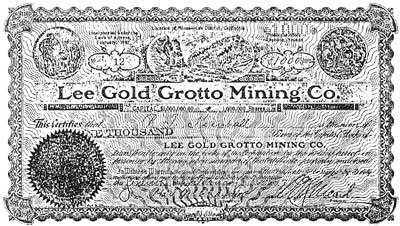
|
| Illustration 144. Courtesy of the Allan Metscher collection, Central Nevada Historical Society. |
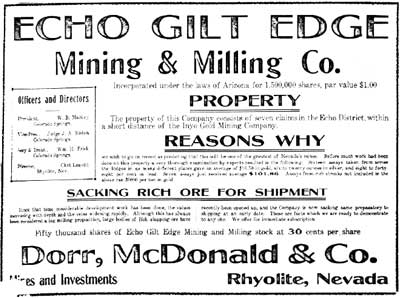
|
| Illustration 145. From the Rhyolite Herald, 1 March 1907. As evident from these advertisements, Rhyolite stock brockers and mining promoters were instrumental in promoting the Echo-Lee mines. |
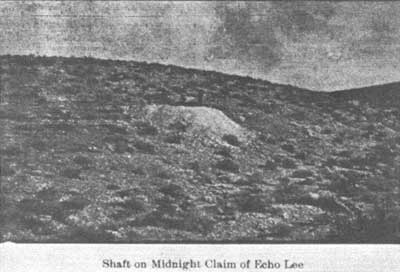
|
| Illustrations 146-147. Although this is a relatively poor picture, it helps put the Echo-Lee District mining boom into perspective. The shaft in the middle is the main working shaft of the Echo-Lee Mining Company, which was a fully incorporated mining company, owning fifteen claims. Stock in the company at the time of the photo was selling for 15¢ per share. Note the lack of structures around the mine, and the crude hand windlas used to hoist the ore. Such opertaions were very typical of the Echo-Lee District, and each of these isolated mines hoped to strike it rich. The Echo-Lee Mining Company, however, was not one of the lucky ones, and its mine never saw much more activity than what is depicted here. Compare this photo, taken from the Rhyolite Herald of 15 March 1907, with the following advertisement, from the Herald edition of March 1, 1907. |
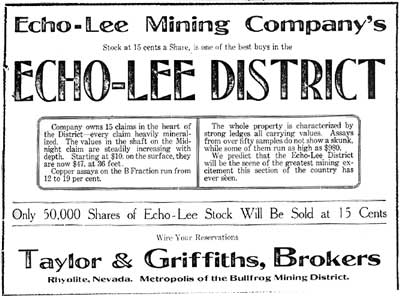
|
When spring turned into summer, even the heat of the Death Valley climate could not slacken the pace of the boom. Two new companies started work in Echo and nine in Lee. The Inyo Independent reported in late May that eighty men were employed as wage-earners in the mining companies operating in the district, and estimated that another 500 could be found prospecting around the hills, or working their own small mines. Some water had been found in the vicinity of Lee, which alleviated one of the problems of the district, but water still sold for $3.00 per barrel, and much of it was still hauled in from Rhyolite. In mid-July, the Bullfrog Miner reported that eight to ten companies had hoists in place and operating, and more had hoists on order--a prime indication that many companies were passing from the earlier stages of development where hand windlasses and horse whims were used to raise the ore.
But in the fall and winter of 1907, the bloom went off the Echo-Lee boom, a direct result of the Panic of 1907. This financial panic, which hurt all the mining districts of the west, even those proven areas such as Goldfield and Tonopah, arrived at the worst possible time for the young district in the southern Funeral Range. By the end of September 1907, when the effects of the Panic began to make themselves felt in the area, a total of fifty-two mining companies had begun operations in the Echo and Lee Districts--plus another, twenty-five on the Nevada side of the Lee District. Although nine of these companies had failed shortly after they were formed, the Panic caused the demise of numerous more companies. Between August of 907 and the end of the year, a total of thirteen mines went out of business, and no new mines began operations.
The panic had hit just when most of the Echo-Lee mines were beginning to make the transition from the exploration stage into more serious development work. Many mines had proved that they had ore in the ground, which was the purpose of the early stages of exploration, and were just now beginning to start the expensive work of proving the extent of their ore reserves and extracting that ore for shipment or milling. For this purpose, eighteen hoists had been ordered and placed in the district during 1907, and miners had been hired to work the ore deposits. All this was done through funds supplied by stock sales and in a few cases by individual owners of mines. But now, with the panic affecting all segments of western mining, investors and mine owners began to pull in their horns. Small investors were forced to sell off their stock holdings in order to meet loan obligations called in by failing banks, or even to pay for food when their jobs were lost. Larger investors and promoters, most of whom came from Rhyolite and Goldfield, quickly dumped their smaller holdings in the Echo-Lee District in order to protect their larger and much more important investments in Rhyolite and Goldfield, which were their main sources of wealth and support. The Echo-Lee District, at the time when it most needed investor confidence and large treasury funds in order to mine the ore in the ground, suddenly felt itself cut off from all funds whatsoever, and mine after mine was forced to close down for lack of money to pay for labor and supplies.
Some of these mines closed for good, but many were able to weather the panic and resume operation in 1908! But the boom was now definitely over, and investors, once. burned by the Echo-Lee District, were loath to reinvest in those mines--even though they had been burned by circumstances far beyond the control of the mining companies. Consequently, after the fall of 1907, a decided change took place in the Echo-Lee District, as the mines which were left struggled to survive in a much more pessimistic atmosphere than that which had prevailed during the rosy days of the boom during the spring and summer of 1907.
In late December of 1907, reflecting this trend, the Rhyolite Herald noted that only ten companies were actively operating in Lee, although many others were expected to resume once the financial distress had passed. "In ordinary times," wrote the Herald Lee would experience a strong boom, and I predict as money becomes easier, you will see much of it invested in Lee." [51]
During the early months of 1908, the Panic gradually eased its hold upon the district. Only six more companies gave up during that period, and one new company started, although it also failed after only a few months. Several of the old mines, which had closed during the previous fall, were relocated by individual prospectors on midnight of December 31st when the old claims became invalid. But most of these were small, one-man operations, and never amounted to much.
As the district slowly revived, several individuals began to look into one of the major sources of the district's troubles. The Echo-Lee District had no milling facilities of its own, and thus had to transport its ore into Rhyolite for treatment there or elsewhere. This necessitated a large freight expense, which kept mines with low grade ore from becoming paying propositions. Ore of the content, for example, which kept the Keane Wonder Mill operating for years, was present in the Echo-Lee District in smaller quantities, but the expenses of transporting it to Rhyolite made it unprofitable to mine and mill. Thus J. D. Cushman and several other leading mine owners proposed the erection of a custom milling plant for the district, which would be able to treat ore from all the local mines. The idea was a good one, but unfortunately, no one had a combination of money and faith in the district necessary to finance such a project.
In the meantime, more and more of the Echo-Lee mines gave up on developing the mines themselves, and began to turn to the leasing method, a sure indication of hard times. Lessees were not hard to find, for most of the mines had enough promise to put stars in the eyes of desert prospectors, but with the exception of an occasional small sack of high-grade ore, none of the lessees made good. Finally, in May of 1908, one of the final unmistakable signs of the decline of a mining district appeared when the Lee State Line Gold Mining Company's property was put up for sale at a sheriff's auction. The State Line Mine had looked so promising only the previous spring that its claims had been patented. Although such a move made title to its claims absolutely secure, it also made the company's property subject to property taxes from the county, and now the company could not pay those taxes.
Three more mining companies went broke during the summer of 1908, as the trend continued. The Rhyolite Herald reported in mid-June that the camp of Lee was quiet, a far cry from the year before. During the remainder of 1908, five more companies went broke, and even nature took a hand against the district, when a major cloudburst washed out a large part of the road from Lee to Schwab. Several thousand dollars was estimated as being necessary to repair the road, and no one in the district had that kind of money. By the end of 1908, only eighteen companies were left in the entire district, and many of those were only performing the annual assessment work necessary to retain title to their claims, while awaiting better times. [52]
But the Echo-Lee District did not die easily. As 1909 opened, the Rhyolite Herald noted renewed interest in the district, and gave an assessment of the previous years. The panic . . . was probably felt in the Lee district a great deal worse than in most other of Nevada's gold camps . . . during the hard times it was next to impossible to secure sufficient capital to properly develop its mines. Today, mining conditions are decidedly better, and from this time on Lee-Echo will begin to give an account for herself that will surprise the world. The Bullfrog Miner agreed with that assessment, and reported in early February that "Slowly, but surely, conditions are improving at Echo Lee. . . ."
But, unfortunately, such conditions did not improve enough. The trend of 1908 continued through 1909, and during that year, five more companies gave up and abandoned their claims, leaving only thirteen that still retained hope. The Ash Meadows Water Company, which had intended to lay a pipe line into Lee, and had even surveyed such a line the previous year, abandoned its plans to supply the district with water, for a lack of customers. Likewise, the Tonopah & Tidewater Railroad, which had talked several times of extending a branch line to the district during the balmier days, abandoned its plans, due to a decided lack of freight demand. The Bullfrog Miner, perhaps not understanding the situation as well as it should, wondered in September why there were only twenty-live men working in the entire district, when everyone knew that there was good ground to be had for the picking.
The year 1910 proved no more fortunate. Although only two more companies abandoned their mines that year, the majority of the eleven which were left were reduced to being able to do little more than their annual assessment work. More companies which had patented their claims in prosperous days, such as the Lee Jumbo Gold Mining Company, were forced to miss their tax payments, and saw their property sold at sheriffs auctions. The district died hard, however, and still had enough inhabitants in 1910 to qualify as a poling place for both the primary and general elections of Inyo County. But in 1911, even though a few mining companies struggled on, very little more than assessment work was done. Four more companies gave up that year, leaving seven in token operation, and more fell under the sheriff's hammer. But by 1912, even the most foolhardy had given up, and six more companies folded, leaving only the Rosario Mining Company on the active list--and it gave up in January of 1913.
The Echo-Lee Mining District, after a grand beginning and a boom which was in the best traditions of western mining, had been fatally crippled by the Panic of 1907. Although many of the mines had continued to struggle through the succeeding years, their hopes were futile. Once Rhyolite itself began to show signs of dying around 1910, the final fate of its surrounding districts was almost a foregone conclusion. Although a few sporadic attempts were made in the depression years of the 1930s to revive a few of the mines, those efforts also failed rather quickly, and the Echo-Lee District has been virtually deserted ever since. [53]
b. Lee California
An integral part of every self-respecting mining boom, regardless of size, was the establishment and promotion of a town. The Lee District was no different from any other boom area in this respect, and was actually slower that most in starting a town. But eventually, a group of enterprising individuals decided to cash in on the boom spirit. Starting a town, however, was a little more difficult than it seems. On the surface, all one had to do was to locate and claim a parcel of land, within comfortable distance from the mines which he wanted to serve, and then just stake out lots for sale. But unless the townsite promoter could persuade people to buy his land, he would go broke, and since everyone was living on free land before he came, he needed a powerful incentive. That incentive was business. If the promoter could get the business houses, especially the saloons, boarding houses and restaurants, as well as the grocery and hardware stores, to locate in his town, then his townsite could offer the advantages which would overcome the cost of buying a lot. Thus the town promoters would normally enter into reciprocal agreements with merchants, and would offer them prize locations at cheap prices or even for free. The merchants, who were just as anxious to be the first into a new town, and who wanted locations near the center of the future town, were usually more than happy to enter into this kind of deal.
Such was the case of the Lee District. With the start of the Lee boom, in late 1905 and early 1906, miners and prospectors who came into the area merely pitched their tents wherever they wished, and set up housekeeping--provided, of course, that they were not or anyone's claim. It was not until November of 1905, when the Lee District was first beginning to experience a real boom, that rumors of a new townsite were heard, and sometime during the next month a town was laid out. In early January of 1907, the Lee Townsite & Mining Company was organized to promote this new town of Lee, named after the district and the Lee brothers who were instrumental in opening the district. The townsite was platted, and tents, building materials and supplies were sent in. The company announced that it would be ready to accept inhabitants by January 10th. The town was situated twenty-five miles from Rhyolite, and advertised that it would soon have a telephone connection, a corral and feed yard, a restaurant, rooming house, and, of course, a saloon. The new town was located in Nevada, just east of the California state line, and thus outside of the Death Valley National Monument boundary.
But more than one group of promoters had the same idea, and another townsite was soon started. Interstate rivalry played a part, for the second town, which was situated inside California, was named Lee, California, and was promoted by the Lee Hidden Treasure Mining Company, upon whose property the townsite was platted. As the Bullfrog Miner observed, "it is claimed that a camp is never fairly certain of a good future until it has a townsite fight," and such a fight was now on.
The timing and the location was right for Lee, California, and the town quickly began to grow. Rhyolite merchants established branch stores and other individuals opened up places of business, hoping to capitalize on the new mining boom. By February 8th, the town boasted of a restaurant, a rooming house and a saloon, as well as a general store, and plans for a feed lot, a lumber yard, a grocery, a liquor store, and a general merchandise store were in the works. Twenty-six people had purchased lots towards the middle of town, all under agreement that wooden buildings would have to be erected, and one eighteen by thirty foot frame building and seventeen temporary tent stores and houses were already in the town. The Kimball Brothers of Rhyolite established regular service to Lee, with thrice-weekly stages leaving Rhyolite every Monday, Wednesday, and Friday morning.
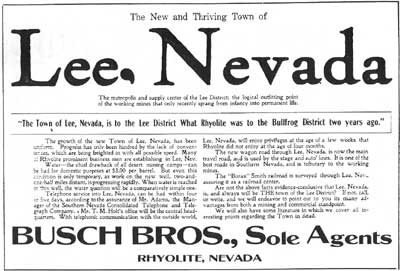 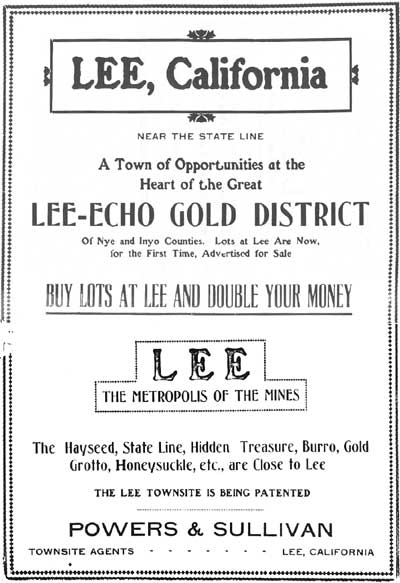
|
| Illustrations 148-149. Ad for Lee, Nevada (top), full-page ad (bottom) from the Bullfrog Miner, 1 March 1907. |
By mid-February, the papers reported that both Lee, Nevada and Lee, California were booming. About 150 people were in the two towns already, lumber was coming in by the wagon load, and tent buildings were given to frame structures. F. S. McArthur established a daily auto service between Rhyolite and the two Lee towns, in competition with the Kimball Brothers' stages, and the autos were scheduled to leave Rhyolite at B A.M. each day and Lee at 10 AM. for the return trip. Lee, California, was platted and plans were laid for the establishment of six business blocks, with the residential district surrounding them.
As February moved into March, and the Lee boom went into full swing, the two towns heightened their competition. Newspaper ads were placed, extolling the virtues of each townsite, and much behind the scenes bargaining took place between the two groups of townsite promoters and the merchants coming into the district. By March 1st, Lee, California seemed to be winning the tight, with an estimated population of 100 citizens, although the only real difference between the two towns, as the Death Valley Chuck-Walla pointed out, was that gambling was legal in Nevada and was not in California. Even that, however, made little difference, as no one seemed particularly concerned with controlling gambling in California. Indeed, neither town had any peace officers or county officials appointed as yet, so a certain freedom from restraint was definitely present.
On March 1st, in its special Lee-Echo edition, the Bullfrog Miner described the towns in some detail. Lee, California had forty tents and several frame houses at the time, and included businesses such as two restaurants, two rooming houses, three saloons and a bakery. Water cost $3 per barrel, already down from the $5 of the previous year, and would get cheaper as soon as some new wells were dug. The telephone line into town was expected to be completed within a week. On March 5th, the plat of Lee, California was approved by the Inyo County Board of Supervisors. The townsite was roughly in the shape of a squat triangle, with a width of five blocks at the base, and a height of five blocks. Provisions were made for the sale of 400 lots.
By the end of March, the Rhyolite Herald predicted that Lee, California would win the townsite battle, as it "seems to have the call." In reality, the mines around Lee, California were showing greater promise than those around Lee, Nevada, which was of primary importance. Between sixty and seventy tents and buildings were in the California town, and additional structures were going up as fast as carpenters could work A new lumber yard was established, and another saloon and a fresh meat market headed the list of new businesses. An ice house was added the next week, making the preservation of meats, produce and drinks much easier for all concerned, and an average of six buildings were started each week during the latter part of March and the first of April.
Then, on April 19th, the fatal blow to the hopes of Lee, Nevada, was struck, S. J. Hernstadt, who was a principal owner of the Hidden Treasure Mining Company as well as a chief promoter of Lee, California, struck pure water at a depth of 120 feet, 3-1/2 miles east of Lee. Since Hernstadt was so closely connected with Lee, California, there was no doubt in anyone's mind that none of his water would find its way to Lee, Nevada. Hernstadt immediately announced plans to lay a pipe line and build a pumping station to bring the water into Lee, California.
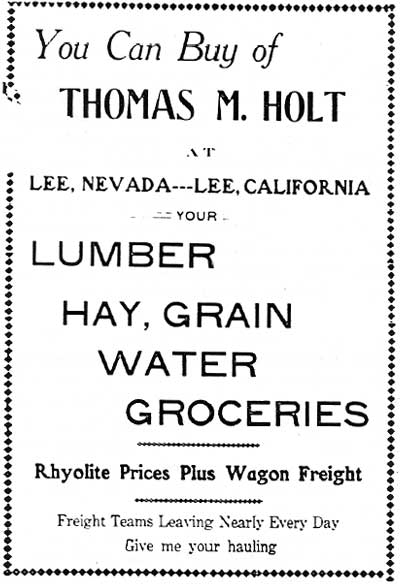
|
| Illustration 150. An early advertisement from an enterprising merchant who set up stores in both Lee, Nevaga and Lee, California, until he determined which town would win the townsite fight. From the Bullfrog Miner, 8 March 1907. |
By mid-April, the town of Lee had grown magnificently. A post office had been established in the Colorado House, which was already Lee's leading saloon and gentlemen's club. In addition, the town had four restaurants, one meat market, four general stores, three feed yards, four office buildings, four saloons--including one which was built of corrugated iron and measured twenty by forty feet--one dry goods store, one assay office, two lodging houses, one ice house, a miners supply store, one barber shop, one surveying office, one brokerage office, two lumber yards, and a stage station. Not to be left out the Death Valley Miners Union was just beginning to erect a Union Hall, a traditional ingredient of any western mining town.
In addition to all these frame or iron buildings, the downtown business district was literally surrounded by a sea of white tents, the homes of miners and business men recently moved into the district. Lots were selling from $30 to $450 each, depending upon location, and the population was put at 300 men and twenty ladies. According to the Bullfrog Miner, these twenty ladies were "very much contented and happy with this new camp life. . . ." Dances were held "every time a new building is dedicated, which is quite often indeed." [54
But such prosperity was not to go unchallenged. On April 19th, "one of the largest townsite and mining property transactions yet consummated in the history of southern Nevada trading was made, when the L, P. McGarry Brokerage Company of Rhyolite, which we have already met as the operators of the Bullfrog West Extension Mining Company, secured control of the Hayseed Extension Mining Company, the North Bullfrog Lee Mining Company and the Gold Shield Mine. Since, as McGarry announced to the papers, the Lee, California townsite lay in a wash which was unsuitable for a real town, McGarry planned to start a new one, called Lee Addition, upon his new land. The new town was described as being "one of the prettiest" sites in that portion of the country. "The people of the old town," McGarry boldly told the papers, "are moving just as rapidly as they can to get locations, and the new town of Lee [Addition] is a lively rival" to both Lee, California and Lee, Nevada.
Within a week, McGarry's Lee Addition was taking shape, with fifteen to twenty tent sites upon the ground, and a boarding house. But the promotors of Lee, California were not worried, and asked "the Herald to state that the town is just where it always has been, and always will be; in other words, that Lee, Cal., is doing business at the same old stand." Despite its new rival, Lee, California had the upper hand, and continued to grow. The new well did a "land office business," with men lining up to draw water, and the flow was sufficient to satisfy their demands. Preparations were made to put in the pipe line from the well into town, and to build the pumping station. Late in April, realizing that his town was now big enough to require some sort of governmental authority, S. J. Hernstadt submitted a petition with eighty signatures to the Inyo County Board of Supervisors, asking that a Justice of the Peace be appointed for Lee.
During May of 1907, with the Echo-Lee boom in its fullest bloom, Lee continued to grow. The Death Valley Miners Union reported a membership of seventy miners, and stepped up construction of its union hall. The telephone exchange was finally completed, which linked Lee to the outside world, and J. P. Nelson announced plans to build a $5,000 hotel. By this time, the Bullfrog Miner reported that Lee, Nevada had "all but given up and moved to California," but the Lee Addition remained as a rival to Lee, California. The two townsites, however, were so close together that the Miner predicted that instead of slugging it out, they would eventually grow together and become one town. A new general store was built, J. E. Saunderson announced plans to open a bank in the fall, the Pacific Express Company moved into town, another saloon opened, and C. E. Kincaid was appointed as Justice of the Peace and deputy tax collector for Lee and its environs.
As May progressed, the rivalry between Lee and Lee Addition continued to keep pace with the district's boom. The plat of Lee Addition was approved by the Inyo County Board of Supervisors on May 6th. McGarry was even more optimistic concerning his town than the promoters of Lee, California had been, as his plat shows a townsite eight blocks long and five blocks wide, with over 800 lots staked out for sale. One week later the two townsites came to an agreement whereby the water from Hernstadt's well would be shared between the two towns, since there was sufficient for both. On May 17th, the Miners Union at Lee gave an informal dance as a house warming for their "magnificent Hall," a frame structure measuring twenty-eight by sixty feet. The hall was big enough for six sets to dance at one time.
As summer began, and the boom at Lee showed no signs of abating, the Kimball Brothers increased their stage service into town to a daily schedule, and reported that their stages were "loaded down each trip." The stage left Rhyolite at 7:30 each morning and returned about 6 P.M. Recognizing the need for law and order, the Inyo County Board of Supervisors let out bids in late June for the erection of a jail at Lee. Late in that month, the Lee, California citizens also organized themselves for government by the establishment of a Board of Trade. A charter membership was appointed to look after the general welfare of the camp. Like those at Rhyolite and many other mining camps in the west, such a board of trade exceeded its legal authority in assuming the right to govern a town, but no one seemed to complain, given the need for some sort of civic direction.
In late July a two-story, ten room wooden hotel building was completed at Lee, and Hernstadt's well was cased up and the pump put in. The Tonopah & Tidewater Railroad, which was then building into Rhyolite, sent a representative to assess the freight potential of the district, and announced that it would run a spur track into town in the near future, "if conditions justify it." The Rhyolite Herald in conjunction with S. J. Hernstadt, announced that arrangements were almost completed for a paper to be started at Lee, which would be published at the Rhyolite office until a printing plant could be brought into town. Just to complete the requirements of the town, Dr. D. C. Parnsworth moved in towards the end of July, giving the miners and their families the promise of medical attention. As a final note depicting the prosperity of a booming mining camp, on August 17th, the Lee Board of Trade passed a resolution restricting the redlight district to two blocks and warned that the restriction would be rigidly enforced. Lee had arrived. [55]
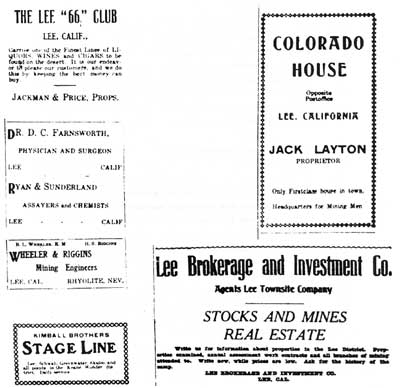
|
| Illustration 151. A selection of advertisements for various Lee, California businesses, from the Bullfrog Miner, 3 August 1907. |
As the fall of 1907 began, the town of Lee, California had reached its height, although its inhabitants did not yet know it. Indeed, signs seemed most promising, especially when the Tonopah & Tidewater Railroad came into the vicinity and established a station, known as Leeland, along its main line into Rhyolite. With the tracks now a reality, General Manager John Ryan of the railroad visited Lee to assess the freight situation and left, saying that "little doubt is entertained but that the branch will be built into Lee. A week later, the Ash Meadows Water Company, a corporation formed to pipe water into the booming districts of Lee and Greenwater, finished the survey of its pipeline into Lee. Water would be brought to Lee, the company announced, before the line was built into Greenwater.
In early October, Lee even had its own newspaper, as the Lee Herald a branch publication of the Rhyolite Herald issued its first paper. Although it was only a six-page folio newspaper that was printed at Rhyolite and shipped to Lee, that was enough to establish the prestige of any mining camp. On October 15th, Leeland Station on the Tonopah & Tidewater Railroad opened for service. With the railroad now only six miles from camp, freight and transportation costs between Lee and the outside world were cut considerably. But the rail service had a drawback. With the new railroad, stage demand for the Lee-Rhyolite line dropped drastically, and the Kimball Brothers cut back on their operations. Since the Kimball stages had brought the mail into Lee as an optional service, Lee was suddenly left with no regular mail delivery, and it began to pile up in Rhyolite.
By late October and early November, the effects of the Panic of 1907 began to be felt in Lee. As mines began to shut down and miners left to find work elsewhere, the town slowly began to lose its population. Even though Lee was estimated to have 500 citizens in early November of 1907, the decline had started. Nevertheless, the town carried on. A daily stage service between Leeland and Lee was established, with the six miles being covered in one hour In late December a new mail contract was let, and the Leeland stage also began to bring in Lees mail, which made the inhabitants seem much less isolated.
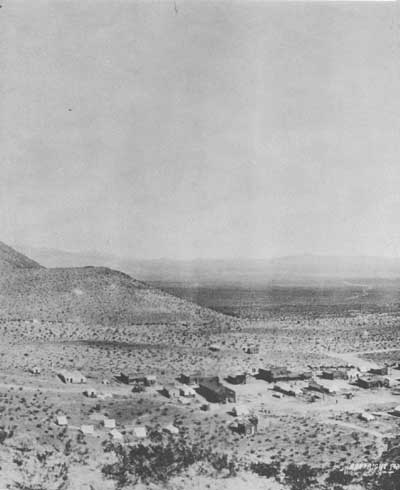 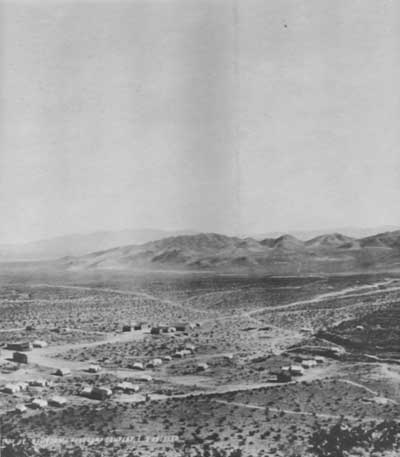 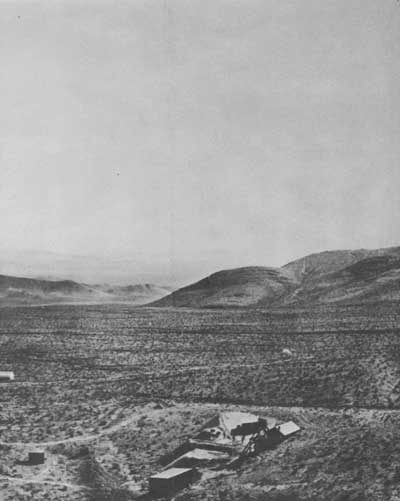 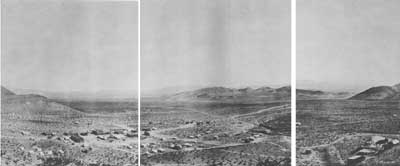
|
| Illustrations 152-153-154-154a. Panoramic view of Lee, California. The center of town is evident on the left, the dump and shafthouse of the Hayseed Mine is in the right corner, and a few tents of Lee Addition are visible in the center distance. Note the number of tents as compared to wooden buildings in town, which indicates that the photo was taken before the peak of Lee's Boom. The wagon road to Rhyolite fades out of the photo towards the left top, as it enters the Amargosa Valley. Bottom photo: Merged view of three preceeding photos. Photo courtesy Nevada Historical Society. |
And there were still a few people migrating into Lee, helping to ease the flow of migrants moving out. One such was the town's second doctor, who was described by the Rhyolite Herald "Mrs. Dr. Sellier," as she was called, was lately of Rhyolite, and opened an office in Lee on December 27th. "Dr. Sellier uses electricity in the practice of her profession, and is said to be very successful. She is also a phrenologist, palmist and telphthist [sic], and is endowed with physic and magnetic power to a wonderful degree, and being a thoroughly posted mining expert is able to give advice in matters connected with this industry." Medical help was not always the best in a mining camp. [56]
Storekeepers and other merchants, who depended upon a stead flow of cash to stay solvent, usually left a dying camp sooner than did the miners and prospectors who were willing to live on bacon and beans while digging for gold. Lee was no exception to this rule, During the first half of 1908 most of the town's business establishment sold out, packed up, and departed for other booming camps, to try again. Although there were still eleven mining companies active to some degree in the Echo-Lee District in June of 1908, the town had dwindled to only three stores, a saloon and a restaurant. The camp was described in an understatement as being quiet, although those who were left were expecting "better days when the universal hard times are over."
Many of those stores which had survived closed for the summer season, as the heat caused most of the mining companies to shut down work for several months. The Lee Hotel, for example, was closed sometime in the spring of 1908 and did rot reopen until early December, when its proprietor returned from San Francisco. One of the lumber yards also reopened in early December, as a winter work in the mines called for a limited supply of timbering material. Although the town had dwindled drastically, its post office was still functioning at the end of 1908.
Very little is heard from the town of Lee for the next few years. Mining camp newspapers, such as those at Rhyolite, were much more eager to cover the growth of a new mining town than the death of an old one. It was bad business to give publicity to a mining district which was dying, and the Rhyolite papers soon began to ignore Lee, hoping that its troubles would go away. Thus mentions of the town are few and far between during 1909 and 1910, and it is much more difficult to keep track of the rate of decline. We do know that Lee had at least one store left in October of 1910, as it was used as a polling place in Inyo County's general election that fall.
The next mention of the town is in January of 1911, when a short article describing Lee's social life was printed in the Rhyolite Herald During that month, Mrs. D. C. Brown had given a card party at her home, with eleven guests, and W. H. Lillard, proprietor of Lee's last store, held a party complete with dancing, music and light refreshment. In June of 1911, Lee was again in the newspapers, but this time for less fortunate reasons. The Lee Hidden Treasure Mining Company, the owner of the Lee townsite, was listed in the Inyo County papers on the delinquent tax list. The Hidden Treasure Company, like many others, had patented the land upon which its mine and Lee townsite lay, and was now no longer able to pay its taxes.
Lillard's store was again listed as a polling place or the Inyo County election in the fall of 1911. Lillard, who was one of the last to give up on Lee, told the Rhyolite Herald in January of 1912 that the camp had "never looked better than at present." But it was just wishful thinking, for by this time even the post office had left town, and had been reestablished at Leeland station. Lillard's wishful quote in January of 1912 was the last mention we have of Lee, California. Sometime shortly after that, even an optimist like Lillard found it necessary to pack up and leave a busted desert mining town. Within a few years, all the lumber, metal and other useful materials that could be salvaged from an abandoned town had been hauled away, and the former bustling camp reverted to its original quiet and forlorn state. [57]
c. Hayseed Mining Company
The Hayseed was the first mine located on the Lee side of the Echo-Lee District, and was also the only company on that side of the district which ever produced more than an occasional sack of gold. The first mention of this mine is in November of 1904, when Richard and Gus Lee located what they called the Hayseed and State Line claims. The two prospectors held on to their claims until February of 1906, when they sold them to Campbell, Metson and Brown, of Tonopah, for between $7,500 and $10,000 in cash. Unfortunately, however, the Lee brothers sold their mine more than once--a practice which was not that unusual--for in early March Charles del Bondio brought suit against Richard and Gus to enforce a performance of contract in writing to sell the Hayseed and State Line claims to him. Although the Lee brothers might be forgiven for breach of contract, since neither of them could read or write, the plot thickened in ate March, when they sold the mine again, this time to Russ Sutherland and Hector McKenzie, for $10,000.
Apparently the Lee brothers took their money and ran, leaving the various claimants to their mine to sort out their difficulties among themselves. Naturally, given the complex problems involved, it took almost a year for a solution to be worked out, and mining did not start on the Hayseed and State Line claims until shortly before February of 1907. Once mining did start, however, excellent results were almost immediately obtained. At a depth of twenty-five feet, the Hayseed shaft struck an 18-inch gold vein which assayed from $8,600 to $123,600 per ton. Although there was considerably less than one ton of gold in that streak, it was still a magnificent strike.
With ore in the ground, and the tricky questions of ownership resolved, the Hayseed Mining Company was organized in March of 1907. Sam F. Lindsay was president of the company, and J. P. Nelson served as vice-president and superintendent of the mine. Although details of the ownership compromises were not made public, the fact that none of the previous owners of the mine appeared anywhere in the organization of the new company indicates that all the former claimants had sold out to the new owners. With its problems solved, the Hayseed Company began advertising and promoting stock sales, and since it was the original mine in the district and had a high-grade streak of gold ore, Hayseed stock sold "like hot cakes." Over $56,000 worth of stock was sold at 50¢ per share within two hours after the announcement of the incorporation of the company was made, including $25,000 worth to one Goldfield firm.
Work at the Hayseed property commenced, and within a few weeks, a tunnel had been run into the ledge for a distance of 100 feet. As work and time progressed, the mine looked better and better, and by the middle of March, the price of treasury stock for sale to the general public had been raised to 70¢, an almost unheard of price for a mine which was just starting its exploratory stage of development. That rich ore was present in the mine was made evident by the fact that one of the Hayseed's miners was caught high-grading (stealing ore) from the shaft. By the end of March, Superintendent Nelson had purchased ore sacks to prepare a shipment of the mine's high-grade ore, and a 25-horsepower hoist had been ordered for the 50-foot-deep shaft. More miners were added to the work force, 260 sacks were filled with high-grade ore, and Nelson started to build a 100-ton ore house to store the riches. [58]
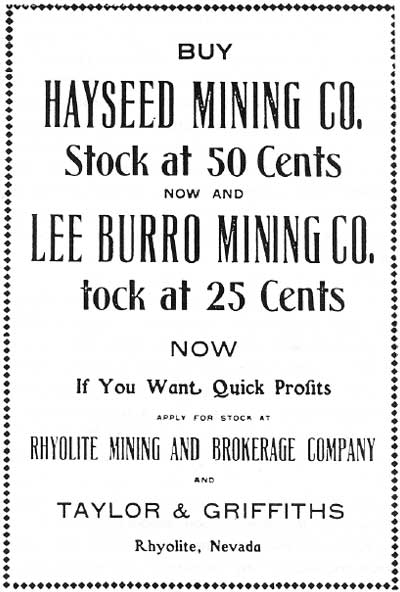
|
| Illustration 155. Advertisement for the Hayseed Mining Company and the Lee Burro Mining Company, both of which were owned and operated by the same interests. From the Bullfrog Miner, 15 March 1907. |
As spring turned into summer, the sensational nature of the Hayseed Mine continued. Taylor & Griffiths, the Rhyolite stock brokers, announced in early April that the mine would make a carload shipment of $150 ore within a month, and reported that Hayseed stock was selling at 75¢ per share, with a heavy eastern demand. On April 5th, a strike was reported at the mine, with the miners taking out between $1,000 and $1,500 worth of ore in one day. Two hundred seventy-five sacks of ore were filled on the dump, the incline shaft was down to a depth of seventy feet, and the ore house was finished. One week later, on April 12th, Superintendent Nelson announced that the shaft was down to eighty-one feet, and that the company had twelve tons of high grade ore sacked. By the end of that month, Hayseed stock was selling for 53¢ on the local stock exchange, and the heavy demand for the company's stock had enabled it to pile up a balance of $26,384.05 in the John S. Cook bank at Rhyolite.
During May, the framing and foundations for the new gas hoist were prepared at the mine, while a few miners stayed underground and worked with the help of a hand winze. But as the months passed by, and the promised high-grade ore shipment did not take place, investors began to become suspicious, and the price of Hayseed stock on the open market began to slump. Stock which sold for 50¢ on the third of May had slipped to 47¢ by May 10th and to 41¢ by May 31st.
Then, during June, legal problems again arose to plague the company, as Charles del Bondio decided that he was not satisfied with the compromise reached the preceeding spring. The Hayseed owners, after several months of negotiating, settled the matter out of court, in order to get back to mining, and especially to divert the publics' attention away from any possible claims against their property, since such had disasterous effects upon public confidence and stock sales. In the meantime, mining continued, and in late June the Hayseed shaft had reached a depth of 150 feet, and ore was still being sacked for shipment.
During July, encouraging progress was made, as the Hayseed Company decided to push ahead with development work despite the intense heat of the summer. J. P. Nelson reported another ore strike on July 6th, with high grade ore which assayed around $100 per ton, and with the help of the new Fairbanks-Morse gasoline hoist, the shaft was quickly sunk to a depth of 215 feet. By the end of July, the shaft had been pushed even deeper to 300 feet, where it struck a rich body of ore. This new strike, coupled with the resolution of the latest ownership struggle, helped Hayseed stock to rebound, and it rose to 55¢ by the end of the month.
On August 3d, the Bullfrog Miner reported that the Hayseed had finally made its first shipment, but that report turned out to be in error, for no shipment had been made. The shaft, however, was down to 330 feet, which was correctly reported on August 3d, but after that news from the Hayseed mine suddenly became scarce. Superintendent Nelson did report briefly on August 17th that good ore bodies had been found on drifts pushed out from the 100 and 300-foot levels of the shaft, but little other work came from the mine. Investors, made wary by the silence of the company and by the long delay of an ore shipment, started selling off their stock again. By the end of August, Hayseed stock had slumped back down to 43¢ per share.
The picture remained much the same for the rest of the year. Nelson reported once a month to the papers about the progress in the different drifts and crosscuts from the main shaft, but other than affirming that the mine had ore, he refused to release assay figures or give the usual estimates about richness of the mine. This, coupled with the disastrous effects of the Panic of 1907, pushed Hayseed stock completely off the trading boards, and after August, no more trading in Hayseed shares was reported. Although the company was still working on its own in the main shaft, rumors began to spread in mid-October that the Hayseed mine was planning to let leases on other portions of its property. The letting of leases, which always indicated hard times for a mining company, was a bad sign, but once again the management took no steps to confirm or deny the rumors.
Then, inexplicably, without any of the usual prior public knowledge, the Hayseed Company sent out a carload of ore in late October. Although the number of tons sent out was not announced, the ore was estimated to be worth between $150 to $200 to the ton, and the usual carload shipments from other mines averaged between twenty and twenty-five tons. Once again, however, no smelter returns from the ore shipment were announced, which effectively killed any promotional potential of the shipment, and news releases from the mine remained few and far between. On November 16th, in a very brief announcement, the Bullfrog Miner said that the Hayseed was thinking of putting in a mill, but nothing further was mentioned--a highly unusual fact, considering the importance of a mill to the district. Such an event was usually chewed over to the point of tedium by the local newspapers.
During the remainder of 1907, the puzzling situation at the Hayseed Mine continued. The Rhyolite Herald reported on November 22d that the Hayseed Mine was looking good.
Encouraging values, it said, were reported in the crosscuts from both the 100 and the 300-foot level, and the company was employing seven miners. The Bullfrog Miner, in turn, reported in late December that the Hayseed definitely had plenty of shipping and milling ore, and was continuing work. Superintendent Nelson, according to the Miner, said that he could keep a good sized mill running for a long time with the ore already blocked out in the mine. [59]
During the first half of 1908, the situation at the Hayseed Mine stayed much the same. The Bullfrog Miner reported in mid-January that the mine looked better than ever, and had $60 to $100 ore in the drift from the 100-foot level of the shaft, which was now out to 380 feet. The mine, according to another report in late January, was sacking ore from four places in the underground workings. Although the company still retained its mysterious silence concerning its ore holdings, it obviously felt that the mine had a future, for on April 29th, it filed a notice of application for a patent upon the Hayseed and State Line claims, a total of 38 acres.
Only when the company had its annual meeting in June was the public finally given a chance to see what shape it was in. Superintendent Nelson, who presented the annual report to the meeting, announced that 1,700 feet of work had been accomplished during the last year, including sinking the shaft down to the 325-foot level. Over 460 feet of drifting and 150 feet of crosscutting had been done on the 100-toot level of the shaft, and 111 feet of drifting and 108 feet of crosscutting on the 300-foot level. The mine, he reported, had good milling ore on the 100-foot level, but had yet to find any on the 300-foot level. The property was equipped with a 25-horsepower gasoline hoist, an ore house, a blacksmith shop and a horse stable. 67,450 shares of the company's treasury stock had been sold to the general public, leaving the company with a balance of 382,550 shares for possible sale, although the general financial picture at the time made it doubtful that it would be able to sell any more. One shipment of ore had been made, of eighteen tons, which returned $73 to the ton, far less than had been estimated, for a total gross profit of $1,314.
Although Nelson said that the company had $30,000 worth of $15 ore in sight, that was not enough to warrant the erection of a milling plant, without which $15 ore was worthless, due to excessive costs of freighting. The rock on the 300-foot level, he said, was so hard that it rendered hand work too expensive to continue, and the company had no funds to invest in machine drills. All told, the picture painted by Nelson was not very optimistic, and it is no small wonder that the Bullfrog Miner reported that "it was decided at the meeting to let leases provided responsible people can be interested in the matter. An endeavor will also be made to bond the property, and raise funds for a milling plant" But apparently the company either changed its mined, or "responsible" leasees were hard to find, for the company continued to work on its own, using its dwindling supply of money, and had eight men employed in late July.
Shortly afterwards, however, the mine closed, and remained idle for the rest of 1908. J. P. Nelson took a vacation to Colorado, and when be returned in early December he would not say what, if anything, would be done with the Hayseed property. He did tell the Rhyolite Herald though, that he expected "to see a genuine revival" in the Lee District when the panic has passed away for keeps." The Rhyolite Daily Bulletin on December 28th, speculated that something would be done to revive the mine following the company's next meeting, scheduled for January 2, 1909. [60]
During 1909, the Hayseed Company began looking more seriously for a lessee, and for a while it seemed that the company would not have far to look. On January 9th, it was announced that negotiations were under way for J. P. Nelson, the vice-president and general manager of the company and S. J. Hernstadt, the secretary, to lease the mine, with the financial backing of Hernstadt's brother, W. L. Hernstadt of New York. Or February 3rd, S. J. Hernstadt announced that the deal had been completed, and that operations would begin soon, with an inspection of the mine and ore tests being made prior to a decision on whether or not to build a mill. The lessees, said Hernstadt, had an abundance of capital. Ironically, while this deal was being negotiated, the Hayseed patent application was approved by the U.S. Land Office, and a patent was delivered to the company, too late to do it any good.
But evidently W. L. Hernstadt of New York had better things to do with his abundance of capital than finance his brother, for the leasing arrangement tell through. Then in April, the Bullfrog Miner reported that some big stockholders of the Hayseed Company, together with the owners of the Crystal Bullfrog Mill at Gold Center were negotiating for a long term lease on the full holdings of the mine. Their object was to operate the mine and dump and treat the ore at the Crystal Bullfrog Will. Several weeks later, however, the Miner reported that the deal was not yet closed, and it never was. The only other mention of the Hayseed during 1909 was a notice that it had sent an ore specimen to the American Mining Congress Convention at Goldfield, but the specimen did not seem to interest any of the conventioners enough to attract a lessee for the mine. [61]
Finally, in early 1910, the Hayseed Company found the lessee for which it had been looking. On February 19th, Dr. F. H. Harding, of Fosteria, California, obtained a three-year lease on the mine. According to the Rhyolite Herald, which exaggerated somewhat, Harding had ordered a 10-stamp mill and would install it as soon as possible. Development and preparatory work was to start at once. Terms of the lease called for a sliding scale of royalty payments, from 10 percent on $15 ore to 35 percent on ore of $150 value or higher. Harding had the option to purchase any improvements which he made at the mine during the term of his lease, such as a mill or pipe line. He had nothing to lose, beside his time and labor, for his only payment requirements were in the form of royalties. If he found no ore, neither he nor the company got anything.
By the first of March, Harding had started to work on his lease, and by the middle of the month he was preparing the ground for the installation of a mill. Towards the end of April, the Rhyolite Herald reported that Harding was so pleased with the results of the first several months of his work that he had brought his wife and family in to live at Lee. On May 14th, Harding purchased a mill from the defunct American mine near Columbia, Nevada, and started to dismantle it for shipment to Lee. The mill had a capacity of thirty tons per day, and Harding hoped to have it in operation within seventy days, treating the tree milling ores of the Hayseed Mine. The mill had three Nissen-type stamps, and due to the lack of adequate water at the Hayseed Mine, would be installed one mile west of Leeland Station, four miles east of the mine, where there was a well with sufficient water to support the mill.
By the first week of August, Harding had his mill in place and running. The Rhyolite Herald reported on August 13th that the mill had run well during its first ten-day run. The three stamps had been treating about ten tons a day, about half its capacity, and was making a 70-80 percent savings, using amalgamation only The ore from the mine which was being treated averaged around $30 per ton, which would permit a profit, even considering the four-mile wagon haul from the mine to the mill and the shipping charges on the Tonopah & Tidewater Railroad to get the bullion to the mint. On September 10th, Harding turned out the first bar of gold bullion from the little mill, but when he brought the gold into Rhyolite, he refused to estimate its value.
One month later, on October 15th, Harding again came into Rhyolite, but this time he had no good news. The little mill, he said, using amalgamation only, would not save enough of the ore content to make a profit on $30 ore. Cyanidation would have to be added to make the mine and mill profitable, but Harding did not have the resources to add a cyanidation plant to his mill. Accordingly, Harding sold his lease to Ed Mellarkey and Hugh Leonard sometime prior to November of 1910, and the Hayseed Leasing Company was formed. The new partners resumed operations at the mine and mill in late November, and in mid-December reported that a twenty-day run at the mill had yielded a gross profit of $607.54 in gold bullion.
But Mellarkey and Leonard soon realized that such returns were not enough to make a go of the mine, and they ceased operations. With both the lessee and the sub-lessee out of business, the Hayseed Mining Company had no funds to pay county taxes upon the mine or mill, and on March 11, 1911, the mill was sold at a sheriff's auction. As related above, Johnnie Cyty purchased the mill for $500 and moved it to his mill site on the Death Valley slope of the northern Funeral Range. In the best traditions of desert mining, the little three-stamp Nissen mill went to work for its third owner. The last notice we have of the Hayseed Mine is in December of 1911, when T. H. and E. M. Francis of New York, together with Ed Bevis of Rhyolite,, inspected the property. Although the Rhyolite Herald reported that they and the Hernstadts were again considering operating the mine, nothing happened. The Hayseed Mine, the largest producer of gold on the Lee side of the Echo-Lee District, was finally abandoned. Sometime during the subsequent years, the hoist and headframe, the ore house and blacksmith shop, and all other items of value were salvaged, and the Hayseed Mine was left to gaze down upon the deserted streets of Lee, California.
During the negotiations which led to the acquisition of the Hayseed property for Death Valley National Monument in the early 1970s, information concerning the mine's previous owner, W. L. Hernstadt, was uncovered. Apparently S. J. Hernstadt had finally convinced his brother, W. L., to take over the mine, although it was too late to do the mine any good. When W. L. Hernstadt died in 1964, 204,792 shares of Hayseed Mining Company stock were found in his estate. The stock, according to his lawyer, had been regarded as Hernstadt as being "worthless many, many years before his death." [62]
d. Present Status, Evaluation and Recommendations
The Lee, California townsite, as L. P. McGarry pointed out seventy years ago, lies along the side of a shallow wash at the very foot of the eastern slope of the Funeral Range. Although not much appears to the first glance when a visitor enters the area, a climb up to the top of a small knoll just west of the townsite brings things into focus. From above, one may observe the outline of the town, with three main streets connected by half a dozen side streets. Almost forty building sites of some degree may be discerned, ranging from leveled spaces which were no more than tent sites, to rock retaining walls surrounding the sites of wooden and iron buildings, and even the sites of two buildings which had basements. In addition, several dugouts were scattered around the fringes of the townsite. The Lee townsite, as it now appears, is one of the largest undisturbed townsite areas in the west. It is an outdoor laboratory for historical archaeology, as well as an excellent site for the interpretation of a traditional boomed and busted mining camp.
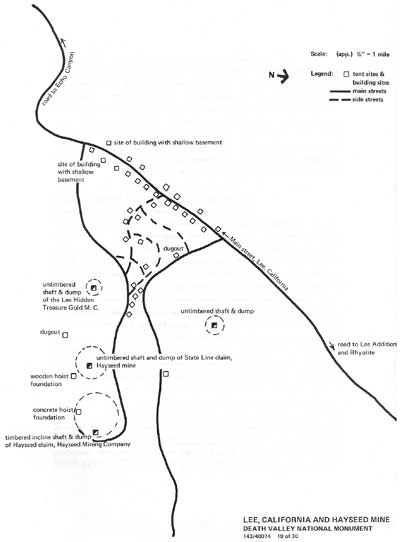
|
| Illustration 156. Map of Lee, California and Hayseed Mine. |
The townsite, as benefits a mining camp, is surrounded with shafts, adits and dumps, silent signs of the efforts of its citizens to wrest wealth from the earth. The largest of these is the Hayseed Mine, which sits just east and slightly above the townsite. The Hayseed claim of this mine has a large dump, a timbered incline shaft which sinks over 300 feet into the ground, and a three by eight foot concrete engine foundation, where the 25-horsepower hoist used to sit. The State Line claim, also owned by the Hayseed Company, is just to the west of the former claim, between it and the town, and has a smaller dump, with an untimbered shaft and a wooden foundation for its smaller hoisting engine.
To the northeast of Lee, California, nestled right up against the Nevada state line, lies Lee Addition. McGarrys timing in promoting this townsite could hardly have been worse, since he started it just before the Lee boom began to fizzle. Nevertheless, half a dozen tent sites can be found in the vicinity, as well as four stone walls, each measuring about twelve feet square, which were retaining walls for wooden structures. In addition, the main feature which dominates the Lee Addition site is a 75 by 85-foot rectangle, surrounded by two to three foot high stone walls, which probably was used as a feed yard and corral.
The Hayseed Mine, the Lee townsite and Lee Addition will be nominated to the National Register. Although these sites do not contain any imposing physical structures, myriads of smaller remains and ruins possess potential historical archaeological significance and are too valuable to leave unprotected. Although the site is now hard to get to from Death Valley, the old Echo-Lee road, which is now a jeep trail, is passable by four-wheel drive. With little improvement, the road could be used by the majority of the visitors. It that was possible, the park visitor, after a beautiful and exciting ride through Echo Canyon and over the Funeral Range, would have an unparalleled opportunity to see and learn about the life and death of a very typical desert boom camp. Such a trip would rival and perhaps surpass the famous Titus Canyon Road.
About one mile southeast of the Lee townsite is the ruin of a more active claim. Three adits are perched high on the side of the mountain, and below them, in a narrow wash, is a wood and tin cabin, beside the cabin stands a wooden loading platform, used to load the ore from the mine above into trucks which drove up beside the platform. No knowledge of the history of this mine has been found, although a sign on the door o the cabin notes that the claim was relocated in December of 1975, with the permission of the original owners, Mr. Kaylor (sp?) and Mr. Rambo (sp?). This site is relatively modern, and has no historic significance.
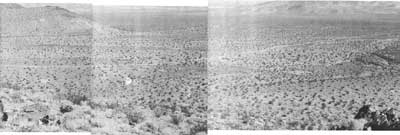
|
| Illustration 157. Panorama of Lee, California townsite. The main street of town may be seen traversing the photo from left to right. The road to the left goes to Echo Canyon and the one to the right leads out to Lee Addition and Rhyolite. The center of town was in the approximate center of the photo. 1978 photos by John Latschar. |
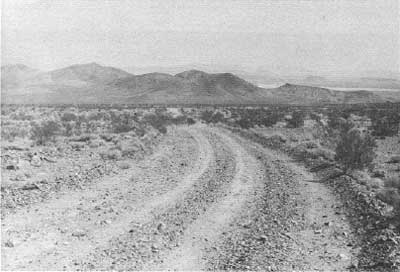 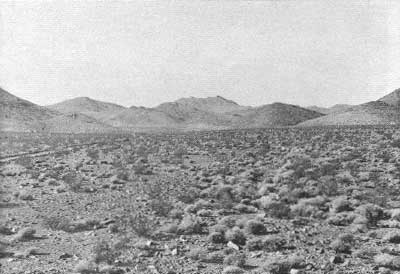
|
| Illustrations 158-159. Top: View looking norhteast down the main street of Lee, California, towards Nevada. Although not discernable in this photo, the sides of this street are lined with level sites, retaining walls and basements of the former structures. Bottom: View from the opposite direction, taken at Lee Addition and looking back towards the eastern slope of the Furneral Range. Lee, California is nestled at the foot of the range, in the very center of the photo. 1978 photos by John Latschar. |
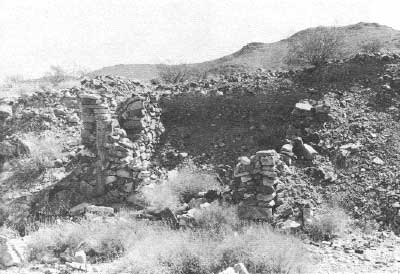 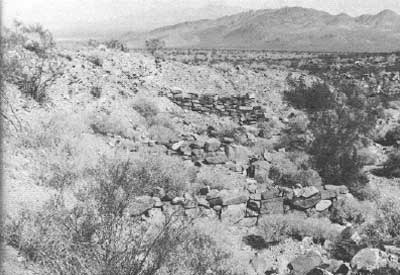
|
| Illustrations 160-161. Views of typical retaining walls at the Lee, California townsite. Some of these walls, such as those at top, probably had little more than a wood, tin, or canvas roof above, while others, such as those at bottom, served as foundations and wind shelters for wooden or tent buildings. 1978 photos by John Latschar. |
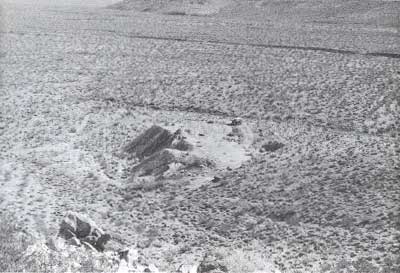 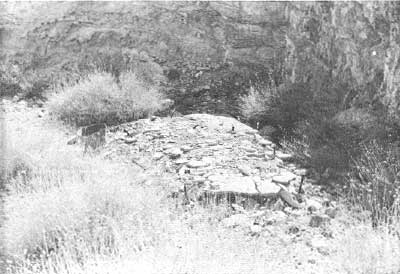
|
| Illustrations 162-163. Top: View of the Hayseed dump from above, with the vehicle for size comparision. Lee townsite is located out of the picture to the left. Bottom: The three by eight foot concrete foundation for the hoisting engine on the Hayseed dump. The concrete shell was rather thin and is crumbling, but the steel anchor rods were well driven into the rock below. 1978 photos by John Latschar. |
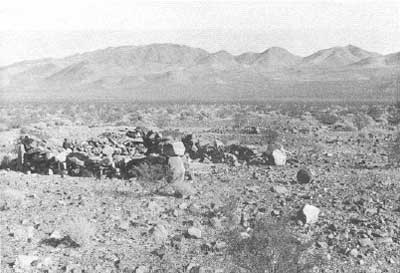 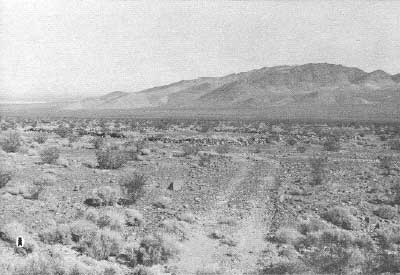
|
| Illustrations 164-165. Top: One of the retaining walls at the Lee Addition, formerly used as a foundation for a building. Bottom: View of the large rectangular stone wall at Lee Addition, probably used as a corral and feed yard. The low mountain in the background of both pictures is in Nevada, and is the site of the Nevada mines of the Lee District, as well as the townsite of Lee, Nevada. 1978 photos by John Latschar. |
7. Echo Canyon
Although the history of the boom and bust of the Echo Canyon mines and townsites does not differ much from that of the Lee side of the district, as already outlined in the stories of the Lee townsite and the Hayseed Mine, time will be taken to present the histories of several important aspects of Echo Canyon mining.
a. Inyo Gold Mine
1. History
Like the Hayseed Mine to the east, the Inyo Mine on the Echo side of the district represents both the earliest discovery on the west side of the Funeral Range, and also the only mine on that side which ever produced more than an occasional sack of gold. The first locations in Echo Canyon were made by Maroni Hicks and Chet Leavitt in January of 1905. After a brief trip to civilization for supplies, the two men returned to Echo Canyon in March, and made several more locations. By May of 1905, the prospectors had accumulated two groups of locations, consisting of twenty claims, and after staking out all the ground which they thought might be any good, they started to dig a tunnel on one of the claims in June.
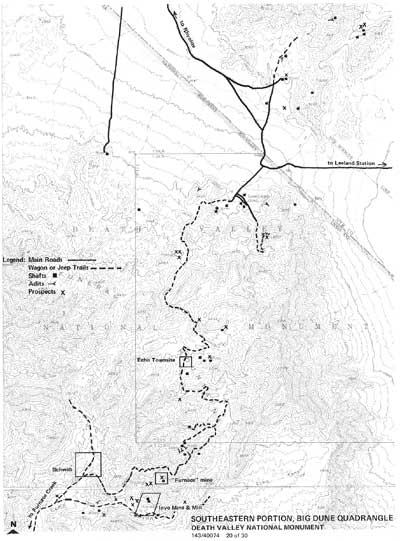
|
| Illustration 166. Map of Southeastern portion of Big Dune Area. |
During the summer of 1905, as the first movements into the Echo-Lee District began, the Hicks and Leavitt property became one of the most talked about in the region. It appeared that the prospector's dream was about to come true for the two men, as they found capitalists interested in purchasing their locations. In August, nine of their claims were bonded to Tasker L. Oddie for $150,000, and the remainder to Charles Schwab for $100,000. Schwab was to pay the prospectors $5,000 on September 1st, if he decided he wanted the mine. Oddie, in turn, was to pay $5,000 on December 1st and the balance of the money one year later. Although Schwab never paid, and apparently never tried to develop his portion of the mine, Oddie's men went to work at once. Soon they had a shaft 50 feet down in the ground, and were talking of erecting a mill, a wire rope tramway and an electrical power plant for the mine. Oddie also considered cutting a new wagon road to Rhyolite at a cost of $1,500, cutting off thirty-five miles from the present winding road.
But by November, Oddie had let his option expire, due to "a misunderstanding having arisen concerning terms, etc.," and the claims were bonded again, to two Colorado capitalists. The new agreement called for a payment of $10,000 immediately, and another $140,000 during later months. But again, the new purchasers were either not impressed when they began to work, or were not able to raise the $10,000 demanded by Hicks and Leavitt, for their option was soon cancelled.
Finally, in December, a sale was made. L. Holbrook and associates, a group of Utah mining promoters, purchased the entire mine and incorporated the Inyo Gold Mining Company. Maroni Hicks accepted cash for his half of the mine, but Chet Leavitt retained his interests and became the vice president of the new company. The Inyo Gold was incorporated in Utah, with a capitalization of $1,000,000, based upon 1,000,000 shares of stock with a par value of $1 each. The new company owned twenty-one claims, which represented all of the Hicks & Leavitt properties, including those which had formerly been bonded to Charles Schwab. Soon after the incorporation of the new company, development work in the mine began, and in early January of 1906, the property was surveyed. [63]
By the first of February the shaft on the Inyo Mine was down to sixty-five feet, and that depth had been increased to 100 feet by March. At that time, nine men were employed at the mine, under the direction of Chef Leavitt, who was general manager of the company. By the end of April, crosscuts were going out from the W0-foot level of the shaft in the search for ore, and a second shaft was started on another claim. In June, a big strike was made at the mine, as noted by the Rhyolite Herald "The Inyo Gold Mining Company has made the most phenomenal strike in the history of Funeral Range mining and one of the biggest uncoverings since the discovery of Tonopah Assays from the new strike, which was at the bottom of the new shaft at a depth of sixty-five feet, were close to $300 per ton."
Following the news of that strike, which seemed to prove that the Inyo Gold would make the transition from a developing to a producing mine, rumors began to circulate concerning the sale of the property. In August, the Bullfrog Miner reported that the mine had been sold to the Schwab interests for $2,000,000, and the Rhyolite Herald reported that all of the company's stock had been sold for $1 per share to a group of Salt Lake City capitalists. But nothing came of either rumor, and since the mine ceased work during the hot summer months, little was heard from it.
In October the Inyo Gold Mining Company was reorganized, although the changes were mostly internal. L. Holbrook, the principal owner, was still listed as president of the company, but Chet Leavitt lost his position as vice president. Work would be resumed shortly, the company stated, and now that the railroads were reaching Rhyolite, the shipment of medium grade ore from the mine would soon make it a producer. But work progressed more slowly than the company had hoped, and no shipments were made in 1906, although the company had its new shaft down to seventy-three feet by the end of that year, and several crosscuts were started. [64]
But as 1907 opened, work began in earnest on the Inyo Gold. The company ordered a small gas hoist in early January of that year, and by the end of that month reported that it had three shafts exploring for ore at depths of 100, 73 and 30 feet, respectively. In addition, tunnels and crosscuts were being driven, and ore bodies were being found, although the estimated extent and content of the ore finds were not greatly publicized. Chat Leavitt, who was still the mine superintendent, was employing twenty men in February, and a boarding house had been built at the property for their convenience, Plans were also in the works to construct a commissary store, and the company ordered ore cars and tramway tracks to facilitate the removal of ore from the mine.
Towards the end of February, the Rhyolite Herald took time out to describe and assess the Inyo Gold's property. Average values in the various shafts and tunnels, the paper stated, were around $44 to the ton. The ore was free milling, which meant that it could be treated in the simplest manner, and once the Ash Meadows Water company had completed its pipe line into the Lee district, the company was considering the construction of a mill. Water was now hauled from Furnace Creek, a distance of eight miles, at considerable expense to the company. The boarding house at the mine was feeding thirty miners. Since that overcrowded its accommodations, a new boarding house with an eighteen by thirty foot dining room and a fourteen by sixteen foot kitchen was being built. When it was finished the present boarding house would be converted into a rooming house. In addition, the company was building a sixteen by twenty foot commissary for the sale of groceries and mining supplies to the company's employees and other prospectors in the area. "The concensus of opinion, concluded the Herald "is that the Inyo Gold Mining company's property, the original Hicks & Leavitt group, is one of the most likely properties in the new gold fields along the Nevada-California border."
During March and April, work continued steadily, and the local papers faithfully reported the progress made in the company's shafts and tunnels. By mid-April, the company had begun preparations for the construction of a mill, and several loads of lumber were on the ground. The mill was to be built at the mouth of the main tunnel, near the new blacksmith shop. Thirty men were employed at the mine, and most were eating at the recently-completed boarding house, run by Mr. and Mrs. McKnight. By this time a portion of the mine's new hoisting machinery had arrived, and the company announced that it would not ship its high-grade ore, but would rather keep it on the dump until the mill could be built. In response to several inquiries, the papers reported that the Inyo Gold was a closed corporation, so that the company's stock was not being sold on the open market. Several blocks of shares, amounting to no more than 50,000, had been sold by one or more of the original incoporators of the company, but most of those had been bought back by other owners.
Once again, due to the heat of summer, work slacked during the hot months of 1907. Some miners continued to labor in the shafts and tunnels, but not with the pace of previous months, and the papers had little more to report other than the statistical advances of that work. But in September, the company, which was running out of development funds advanced by the owning partners, decided to go public. From its application for a license to sell stock in California, many details of the company's position are available. Fifty-two thousand of the 300,000 shares of treasury stock in the company had already been sold, and the Inyo Gold was now asking permission to sell the rest. The company had an indebtedness of $15,250 and no money in the treasury. The property was equipped with a hoisting whim, a blacksmith shop, a bunk house, and mining tools, and its employment roll had shrunk to seven men. Three hundred and fifty feet worth of shaft work had been done, in addition to 700 feet of tunneling and 75 feet of crosscutting. No ore shipments had been made, but the company claimed to have $650,000 worth of ore in sight. At the time of its application, the Inyo Gold had already been approved for stock sales in Utah.
The Inyo Mine could not have chosen a worse time to go public, for the Panic of 1907 hit the district shortly after the company put its stock up for sale. Had the decision been made six months earlier, the Inyo mine could have taken advantage of the height of the Echo-Lee District boom, when stock in much less worthy mines was selling at fever-inflated prices. Now, in the fall of 1907, mines were closing and very few investors could be found who were willing to risk scarce investment funds in an outlying district. Now, instead of a fat treasury which would have enabled the company to continue its development work on an extensive scale, and to build its mill, the Inyo Gold instead was faced with bankruptcy.
Nevertheless, the company continued operations for a few months. Work was continued during September and October, with a force of between fifteen and twenty miners. But after the middle of October, momentum slowed considerably and very little further work was accomplished for the rest of 1907, although the mine was reported to still be employing a "small force of men" at the end of the year. The Rhyolite Herald denied rumors that the Inyo had closed down completely in December, and went on to lament the general state of mining in Echo canyon. "The properties are among the best in the district and it is much regretted that the companies do not find it consistent to work on a large scale. But the ore is there and when the financial sky is clearer, the properties will show the world what kind of golden lining Echo canyon is made of." [65]
Like so many of the other Echo-Lee District mines, the Inyo Mine had been fatally crippled by the Panic of 1907. Following the onset of the panic, development work virtually ceased throughout the rest of 1907, and 1908 followed suit. No work was done on the mine during that entire year, and the only notices in the papers concerning it were several rumors of sale. The Bullfrog Miner reported that the mine had been sold to Thomas Lockart, president of the Florence Mine in Goldfield, in March, and the Rhyolite Herald reported that L. Holbrook had secured control of a majority interest in the mine during August. But neither of these rumors were borne out, as the Inyo Mine virtually dropped from sight. In July and August, both papers reported that the mine would be reopened soon, complete with a processing mill, and several paragraphs were taken up in discussions of the possibilities of such an event, but they never occurred. In November, Chet Leavitt promised that the mine would soon be heard from, and stated that all the claims of the company would be patented before the year was out. The company had even taken the opportunity for some nation-wide advertising, when the Weekly Advertiser devoted an issue to Nevada mining, but even the effect of a full-page ad was futile, for the depression upon mining was being felt across the entire nation.
During 1909, the situation did not improve at all. The Rhyolite Herald reported in April that Chet Leavitt had sold his interest in the mine, but a later issue noted that the dear was not definite, and it never was. The company did put some ore on display at the American Mining Congress convention in Goldfield that fair, but little else happened on the property. The company's application for a patent on seventeen of its claims--a total of 215 acres--was approved on August 15th, but like so many other mines of the region which had applied for a patent during the boom days, the papers arrived too late to do the company any good. In September, the Bullfrog Miner optimistically noted that the "Inyo property has arrived at the point where plans for a mill are next in order, and the next week printed a rumor that the Inyo mine "will be subject to the biggest leasing deal yet known in Nevada." Salt Lake City promoters, the paper reported, were negotiating for a long term lease and were planning to develop the ground to the extent of constructing a large size treatment plant. On the basis of this rumor, Inyo Gold stock suddenly appeared on the trading boards, for the first time ever, and was sold at the price of 6¢ per share. But like so many others, this deal also feel through, and the Inyo Mine continued to lay idle.
The rumors continued through the following years, as the Rhyolite Herald reported in January of 1910 that the company was again negotiating for the sale of the property, with the potential buyers proposing the installation of reduction facilities. Again, nothing came of the negotiations, The mine, which had not been worked since the fall of 1907, was not mentioned again until January of 1912, when its stockholders met in Utah with the intention of reducing the par value of the company's stock from $1 to 10¢ per share, apparently as an attempt to start another promotional and development campaign. But again nothing happened, and the Inyo mine was finally abandoned. [66]
Thus ended the first phase of the Inyo mine. Its officers had held onto the mine too long, and had made the decision to go public only after they had run out of private development funds, just in time to see the Panic of 1907 ruin their hopes. After 1907, little if any mining was done to what was once seen--probably correctly--as the best and most promising prospect in Echo Canyon.
But unlike the other mines of the Echo-Lee District, the Inyo Gold had a revival. Unfortunately, that revival took place long after Death Valley mining had lost its appeal, and little notice of the subsequent activities at the Inyo Mine reached the local newspapers. Thus although we know that the mine was operated for several years in the 1930s, we have very little day-to-day knowledge of those operations.
After the death of the mine in 1912, the next known reference to it comes in the fall of 1928, when it was sold to Earl B. Gilbert and Daniel Winzelor. Within a few weeks, Gilbert transferred his half of the mine to his wife. Following those transactions, the mine disappears again until 1937, when Mrs. Gilbert leased it to the Inyo Consolidated Mining Company. In August of that year, the Inyo Independent reported that Guy C. Ridell, a mining engineer from New York, had arrived at the Inyo camp to inspect the mines workings. The mine had apparently been operating for several months at the time of this report, for Loren Granger, the manager, was reported in Bishop, buying another load of supplies for the mine.
In March of 1938, the paper reported that the company was still operating, and had installed a ball mill at the mine, The mill was capable of treating twenty-five tons of ore per day, and water for operations was being hauled from Furnace Creek. Since this was costly and unsatisfactory, the company was planning to build a pipe line and pumping station, if operations at the mine continued on a satisfactory basis. The California Journal of Mines & Geology, in October of the same year, reported that the Inyo Consolidated Mine was working on the seventeen patented and five unpatented claims of the property. The principle development was an inclined shaft, 220 feet deep, and the report listed the lengths and depths of various other shafts, tunnels and crosscuts within the mine. At best estimate, by comparing the figures given to those released by the mine in 1907, the Inyo Consolidated had been working the property for less than two years at the time of this report. Ore from the mine, said the Journal was averaging about $25 per ton, and was being processed through the twenty-five ton capacity ball mill. The mill equipment consisted of a fifty ton ore bin, a six by ten jaw crusher, a thirty ton receiving bin, a reciprocating feeder, a three by six ball mill, amalgamation plates, two Simpson tables, and a drag classifier for dewatering. Water was still being hauled from Death Valley, and eight men were employed at the mine and mill.
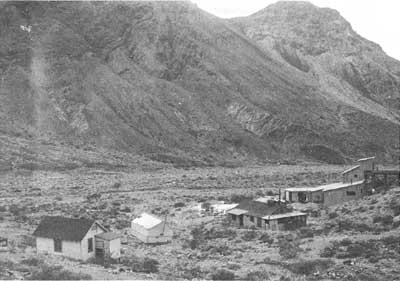
|
| Illustration 167. The Inyo Mine complex, ca. 1938, during the active period of the Inyo Consolidated Mining Company. The structure in the middle with the smokestack is the cook house, and the mill complex is shown to its right. The mining area is far above the mill, to the rear of the photographer. Photo courtesy Death Valley National Monument Library, Negative #1100. |
But shortly after that report, the Inyo Consolidated ceased operations due to a lack of further funds. Although present tailings at the mill site indicate that a limited amount of ore was treated no production record from this era of the Inyo mine exists. In February of 1939, Mrs. Gilbert again leased the mine, to an unnamed individual, who almost immediately found a rich ore shoot at the bottom of one of the shafts. Before the press coverage of this phenomenom ceased, the lessee had sipped thirty-six tons of ore worth $280 per ton to the smelter, for a gross profit of $10,080, and had hired several miners. But once again, the ore shoot ran out, and the lessee was soon out of business.
But the Inyo died hard. The mine was leased again to two men named Thomsen and Wright in 1940, and they installed a small smelter high on a ridge one-halt mile above the former mill site. There, for a short time, they attempted to smelt some of the high grade ore which they took out of a different portion of the Inyo Mine. Again, no production record is available for this effort, which had ended by 1941. A later mining engineer, who inspected this portion of the property, concluded that the furnace at the little smelter had been fired only once, which indicates that the last two lessees of the Inyo Mine were even less successful than had been their predecessors. This was the last attempt to work the Inyo Mine, although its claims are still privately owned. [67]
2. Present Status, Evaluation and Recommendations
Due to the relatively recent date of the last attempts to exploit the Inyo Mine, historic structures at the property are quite extensive. At the mill site are the remains of the ball mill and its supporting machinery, and a complex of living and support buildings. The mill ruins consist of the ore bin and chute, a jaw crusher and the settling plates--the ball mill apparatus itself has been removed. In addition a large metal tank and the old diesel engine which powered the mill still remain. Around the mill is a complex of structures in various degrees of deterioration, including five tent platform sites, some with wooden floors and remnants of canvas, a collapsed wooden frame building, and six standing wood buildings, ranging in size from a twelve by twelve shed to an eighteen by thirty foot cook and dining house. Most of these buildings are quite crude, being constructed of wood plank floors, with unfinished walls and ceilings, but the cookhouse, at least, has a cement floor and was equipped with plumbing. Although it is not possible to be certain, some of these buildings, especially the tent platforms and one old dugout in the midst of this complex undoubtedly date from the 1907 era of mining. But the adaptation and use of different structures and materials during the later period of mining makes a differentiation between the two eras hard to determine.
Above the mill and living area is the main mine complex or the Inyo Mine. Here one may find a stone powder house, another tent platform site, a fairly substantial ore bin, a collapsed wooden building, and a whole array of shaft and tunnel entrances running up and down the hillside. The ore bin has a tramway track leading into one of the adits, and a straight-six gasoline powered engine, adapted from a vehicle of some sort, which was used to hoist the ore Above this group is yet another complex of mine workings, which appears to be older than the first. This area includes another timbered ad-it, a tramway track, a leveled tent site, a small ore bin, and a crude ore chute leading down to a rickety loading bin. Close by is yet an shaft, with a winch left over from the ore hoisting days.
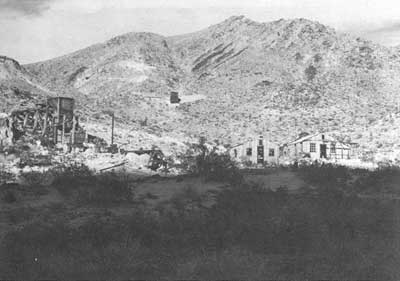
|
| Illustration 168. The Inyo Mine complex in 1973, as viewed from the lower Echo Canyon road. The mill buildings have been salvaged, although the skeletal remains of the mill are still standing. The cookhouse, which has deteriorated considerably, is seen at the far right, and the ore bin of the main mine complex is seen in the top center of the photo. The complex looked much the same in 1978. Photo courtesy of Bill Fiero, Las Vegas, Nevada. |
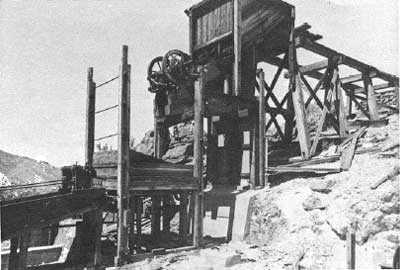 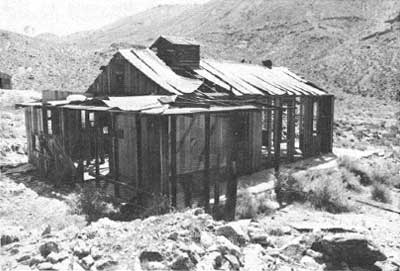
|
| Illustrations 169-170. Top: A closer view of the Inyo Mill remains, in 1978. The ball mill originally stood just below the wheels of the jaw crusher, seen in the top of the photo. Bottom: The cookhouse in 1978, showing the general deterioration of the building. Much of the damage is due to natural elements, but portions of the siding lumber has been stripped for use as firewood by the complex's occasional visitors. 1978 photos by John Latschar. |
Finally, far above the main working area of the mine, in the next ridge to the north, is the site of the 1940 smelter works, sometimes called the Furnace Mine, after its main feature. This complex can only be reached by a long and arduous climb up a twisting mule trail from the upper Echo Canyon road. A stone loading dock is at the bottom of the trail, as well as a crude corral used to tether animals when the owners climbed the hill. Far above is the smelter, perched on the side of the ridge. Machinery here includes the small furnace, with supporting tanks and equipment, connected to a collapsed tunnel entrance by tram tracks. Above the furnace is a deep and timbered incline shaft and a stoped area, evidently the main working area of this complex. Near it, on the very top of the ridge, is a four-cylinder diesel engine used for air compression, and another altered vehicle engine used to drag supplies up the ridge from the upper Echo Canyon road far below, via a cable dragway.
All told, the Inyo Mine complex holds a wealth of artifacts and structures, some of which can be safely dated prior to the 1930s. For this reason, despite the rather unproductive history of the mine during the original boom, it is recommended that the structures and equipment on this site be recognized and protected for their historic values, and the Inyo Mine as a whole will be nominated to the National Register. The site would make a good interpretive complex, since it is not too far from the Furnace Creek road, and is accessible, with a little improvement, to two-wheel drive vehicles. Visitor use of the Inyo Mine site is more frequent than for most of the other areas of the Echo-Lee District. Three nude sunbathers were surprised on the day that this site was examined.
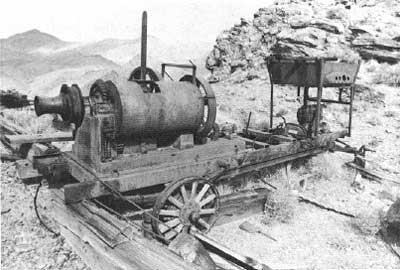 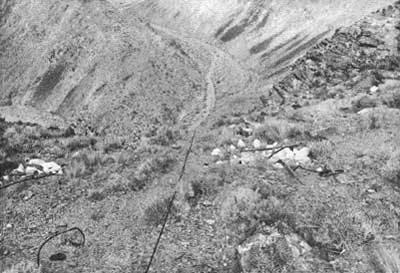
|
| Illustrations 171-172. Top: The winch drum and engine at the upper Inyo Mine complex, aka Furnace Mine. This mechanism was used to drag supplies up the steep side of the ridge from the upper Echo Canyon road below. Bottom: View of the descent from the "Furnace Mine" to the upper Echo Canyon road, with the winching cable still in place. 1978 photos by John Latschar. |
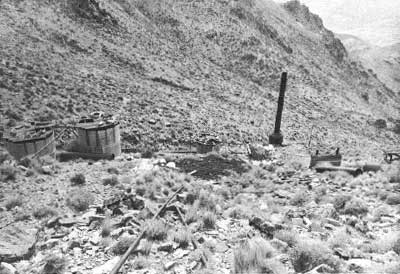 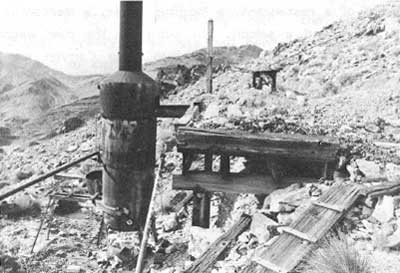
|
| Illustrations 173-174. Top: General view of the "Furnace Mine," looking down from the vicinty of the winching works. The mine and mill complex are located on the opposite side of the ridge from the upper Echo Canyon road, so that supplies were hauled up one side of the ridge from the road and then lowerd down to the mill site on the opposite side. Bottom: Close-up of the crude furnace smelter. 1978 photos by John Latschar. |
b. Schwab Townsite
1. History
in December of 1906, as the Echo-Lee District was beginning to swing into its real boom stage, a new townsite was started on the Echo side of the district to serve the many mines which were beginning to operate in the vicinity. In a fit a grandeur, the townsite was named Schwab, after the well-known steel and mining magnate, who had peripheral interests in the Echo-Lee District, The townsite was promoted by the Schwab Townsite Company, which was incorporated in Nevada on December 31st, and was financed by S. H. Black, J. C. Houtz and J. E. Cram. The company's treasury for promotion and site improvement was $30,000, and was fully paid in advance by the three principles, making Schwab a closed corporation.
Large, full-page ads were placed in the Rhyolite Herald and the Bullfrog Miner on December 28th, announcing the formation of the town, and proudly noting that it was the first town in the Echo-Lee District, which was true by only a few days. "The Price of Lots will Multiply by Five in Ninety Days," warned the ads, and to prove the point, the owners announced that arrangements had already been completed for the establishment of a restaurant, a lodging house, a mercantile store, an assay house and a saloon. In addition, the new wagon road from the Lee side of the district into Echo Canyon was almost finished, and would soon be upgraded into an auto road. Water would be provided to the townsite within thirty days, either by well or by hauling from Furnace Creek, and a stage line and telephone connections would soon arrive. An application had been made for a post office. Fifty lots, said the promoters, had been sold already. Schwab, summed up the ads, was "A Town with an Assured Future," and would "be the scene of the greatest mining excitement in all the history of Nevada."
The next week, as the Bullfrog Miner quaintly noted, "The town of Schwab started for the Nevada desert yesterday from Los Angeles in a box car." The materials for the new canvas city, added Mr. Houtz, would be enough to house several hundred people. Several loads had already gone out, including material for a restaurant, lodging house, store and feed yard, and arrangements had been made for a hardware store and a general merchandise store. By mid-January Black and Cram reported that the new town was flourishing. Demands for lots exceeded expectations, and inquiries had been received from as far away as Boston. Two carloads of townsite materials had arrived, and three more were on their way. The Kimball stage company had plans to put in a stage line, the well diggers had found water at a depth of only five feet, and arrangements for a bakery, a grocery store, a hardware store and another saloon had been made. Eighteen head of horses had been engaged by the town promoters in order to haul all this material from the railroad siding at Rosewell. Streets were being graded, and ample food, horse feed and water was now available to all travelers and prospectors, so they no longer needed to come fully self-sufficient when they entered the Echo Canyon region.
On January 18th, the Rhyolite Herald reported that seventy-seven lots had been sold in Schwab, "many of them being to eastern people who are already familiar with the Lee and Echo Districts through the ads in the local papers." A fourth carload of supplies, containing eight tons, had been delivered to the town, and a fifth, of three tons, was expected shortly. The population of the district surrounding Schwab was estimated to be 400, and twenty-nine men had been counted at the Schwab saloon at one time. Eight lots in the townsite had been sold to the Bohemian Club of San Francisco, and the Rhyolite Herald ruefully wondered if "Tuxedos will soon be fashionable there." The townsite company had ordered a 45-horsepower Apperson auto, which was expected in late January, and which would be put on the run from Rhyolite to the new town. The following week, the Bullfrog Miner reported that an abundance of good water was now available at the townsite, and that many good substantial tent buildings had been erected. The first stage for Schwab had left Rhyolite on January 24th, and the paper surmised that the new town was already "established as the distributing point of that district."
On February 1st, the papers reported that the feed yard was now ready to furnish food and shelter for horses, that the new automobile had arrived and was ready to start service to the town, and that the Kimball Brothers had established a regular stage service to Lee and Schwab, leaving Rhyolite every Monday, Wednesday and Friday. By the beginning of March, the Bullfrog Miner reported that 100 men were employed in the mines surrounding the townsite, such as the Inyo Gold, the Skibo and the Echo Gilt Edge. The Lee-Schwab wagon road, which was too steep in places for autos to negotiate, was being improved, and arrangements had been made to bring in a well drilling machine, in order to improve the water supply. "There are excellent accommodations for both man and beast at Schwab, and one is assured a visit to the new town will not be regretted."
By the end of March, the three-month-old town's population was estimated at 200. The Rocky Mountain Bell Telephone Company had its poles up and was to begin stringing wire from Lee to Schwab at once. The stage service had been increased to a daily basis, and the auto service also planned to go on a daily schedule soon. But by now Schwab had a greater claim to fame. "One of the most unique wonders of the new West," said the Bullfrog Miner, "is the town of Schwab, Cal., owned and promoted by women." This news was quite unique, and caused many headlines in local papers. "A Mining Camp Built by Ladies," as the Death Valley Chuck-Walla put it, was an unusual sight in the west. Yet when the matter is examined it seems much more natural than extraordinary. The first woman to enter the company was Gertrude Fesler, who had come to Rhyolite from Chicago and opened a brokerage office--Miss Gertrude Fesler, Stocks and Mines Bought and Sold." Fesler had purchased J. C. Houtz's interest in Schwab, and through her dealings with the other two owners, had become acquainted with their wives. A Col. Dunn, who had bought out J. E. Cram, decided that his wife could ably care for his interests in the townsite, leaving him free for other pursuits, and Mrs. Black--Mrs. Dunn's daughter-in-law--had also purchased her husband's share, thus forming the all-female company. Helen H. Black became president of the new Schwab Townsite Company, with Mrs. Dunn as the vice president and Gertrude Fesler acting as secretary, treasurer and chief promoter.
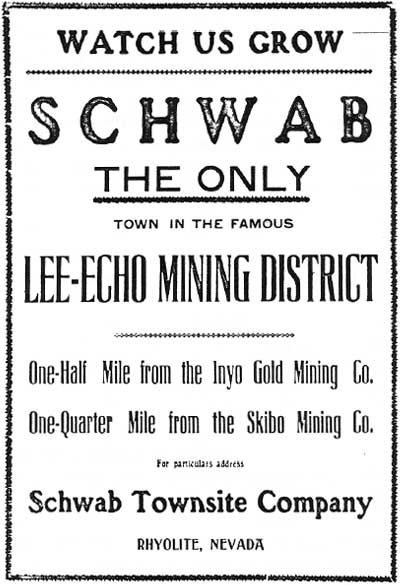
|
| Illustration 175. Advertisement from the Bullfrog Miner, 1 March 1907. |
Ownership by ladies such as these meant some unusual changes in a desert mining town, and the Death Valley Chuck-Walla was quick to point them out. "The gamblers were told to get out. Saloon men were frowned at and sporting women were positively refused entrance. Men said that a mining camp could not exist under such restrictions, but Schwab did. The women hastened to secure the postoffice, the first in the district, and everybody in the three towns [Schwab, Lee, California and Lee, Nevada] had to come to Schwab for mail."
In addition to the new postoffice, which was approved and established on April 5th, Schwab also was the home of the Echo Miners Union, organized early in April. By the end of that month, the union counted seventy-five members, who adopted the Rhyolite scale of wages of $4.50 per day. the townsite company donated a lot to the union, and a large tent was erected to be used until funds could be raised for a Miners Union Hall. Several more town lots were sold during April, but Mrs. Black reported that the one big need for the town was a general mercantile store, to enable miners and companies to get supplies close at hand.
But even with all these improvements, Schwab was never a serious rival to Lee, California. The two towns were separated by eight miles and the Funeral Range, and each was the center for approximately the same number of mines. But Lee, California had all the geographic advantages. All supplies and materials reaching Schwab had to come through Lee, so it was only natural that supply houses at Lee dominated the trade of the two towns. In addition, since Lee was much loser to Rhyolite, that town reaped all the advantages of frequent notices in the Rhyolite newspapers, which amounted to free advertising. Reporters and visitors could travel to Lee and back to Rhyolite in one day, but getting in and out of Schwab took longer, so it was only natural for them to concentrate their attention on the closer town. And once the town of Lee had the upper hand, it was quick to build upon the advantage. Miners and prospectors from the Echo District, for example, found that it cost them no more to travel into Lee to obtain their supplies than to purchase them at Schwab, and when this was coupled with the prospect of a night's entertainment in the larger camp, most began to do so. Perhaps the Death Valley Chuck-Walla was right, in that a mining camp suffering from the lack of female entertainment and gambling, and with drinking frowned upon, had too many disadvantages to survive in the mining frontiers of the early 1900s.
For a combination of these causes, the town of Schwab, after its first several months of growth, began to stagnate. It lost the townsite battle to Lee, and when the Panic of 1907 closed many of the mines in the Echo-Lee District, it soon became very apparent that two towns were one too many for the district to support. So many mines clued so quickly in the fall of 1907 that the Echo Miners Union was disbanded in November.
Schwab died a quick and unmourned death, after only a year of life, and was not heard of after 1907. The town had never even reached the stage where a wooden building was raised, so it was relatively simple for the disappointed merchants to pack up their tent stores and head for brighter horizons. [68]
2. Present Status, Evaluation and Recommendations
Schwab is not located where most writers of western lore have assumed it to be. According to most accounts, the townsite of Schwab was located directly below the Inyo Mine, in the lower Echo Canyon wash. For this reason, they claimed, no one has ever been-able to definitely find any remains of Schwab, since the 1930s mining activity at the Inyo site erased all vestiges of the former town.
But past historians have been mislead by the contemporary accounts of Schwab, such as the advertisements which placed it only one-half to three-fourths of a mile from the Inyo Mine. Operations at that mine, between 1907 and the 1930s, covered many different areas of the company's 214 acres of claims. In 1907, Schwab was only less than a mile from the Inyo Mine, but from a different portion of the. mine than that operated in the 1930s, where the ball mill and housing ruins now stand.
The best contemporary description or the location of Schwab is from the Rhyolite Herald of 22 February 1907.
The town of Schwab is situated just below the Inyo and Skibo camps at the junction of the wagon roads leading up the east arm of Echo canyon and to Death Valley on the south. In other words, Schwab is located in the north or upper branch of Echo Canyon, astride the main Echo-Lee wagon road, across a small ridge from the present Inyo ruins, and about 1-1/2 miles from those ruins. At this location, evidence of the old townsite may be found.
The remains consist of seven leveled tent sites, some with ow and crude stone retaining walls remaining. More tent sites were once present, but have been erased by high water in the adjacent wash during Death Valley's infrequent but violent flash floods. Two of the tent sites have eroded cellars behind them, about ten feet square and five feet deep. Since an immense pile of broken 1900 to 1910-dated beer bottles is located directly behind one of these tent-cellar sites, it is safe to say that this was the tent saloon, where once twenty-nine men were counted drinking at one time. The townsite covers several hundred feet along the-shallow wash which marks the northern branch of Echo Canyon, and remains are mostly restricted to the west side of that wash On the east side, however, is another tent location, and a shallow, unmarked grave, a lonely monument to one prospector who ended his days during the brief life of Schwab. About 300 yards to the west of the townsite is a crude derrick, the remains of Schwab's well. The well site is dry and completely filled in, but numerous five gallon cans are scattered along the trail from the well to the townsite.
The remains of Schwab are fragile and scant. The site needs to be examined by historical archaeologists and deserves interpretation as one of the west's many short-lived mining camps. It is also in need of some sort of protection to prevent it from disappearing back into the terrain of the canyon's wash. The Schwab townsite will be nominated to the National Register in conjunction with the Inyo Mine complex.
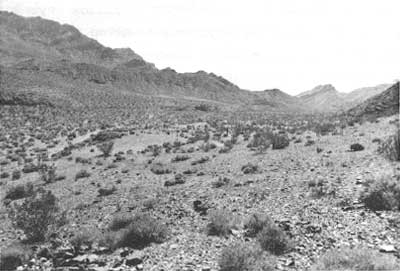 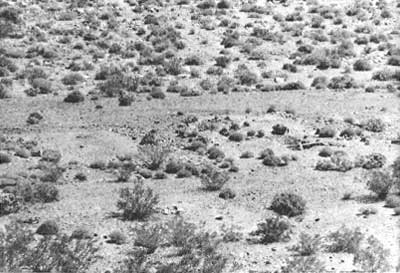
|
| Illustrations 176-177. Top: View of the Schwab townsite, looking southwest. The Inyon Mine ruins are located on the far side of the ridg in the background. Bottom: A closer view of a portion of the townsite area, showing the very fragile remains of two tent building sites. The tent site on the right has an eroded cellar behind it--or in front of it, according to this view. 1978 photos by John Latschar. |
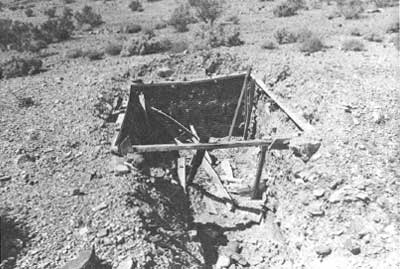 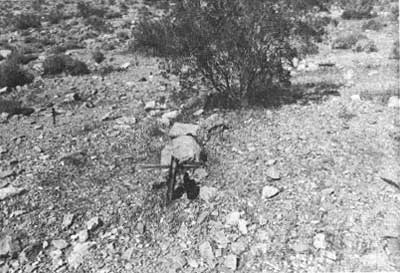
|
| Illustrations 178-179. Top: A close-up of the cellar seen in the previous photo. Bottom: Unmarked grave site on the east side of the Schwab townsite. 1978 photos by John Latschar. |
c. Echo Townsite
Schwab was not the only town started on the Echo side of the district, for in March of 1907 the owners of the Lee Golden Gate Mining Company inaugurated another town on their claims. Called Echo, this town was situated about half way between Schwab and Lee, along the road connecting those two towns, upon a low saddle near the summit of the Funeral Range. The formation of the new townsite was announced on March 22nd, but although the townsite owners put in an application for a postoffice, they seemed content to rely upon the business of the mines in the general vicinity for building their, town, and did not advertise or promote it in the manner of Lee or Schwab.
By the end of April, the townsite had been platted, and lots were on sale to the public. The plat was approved by the Inyo County Board of Supervisors on May 10th, but the town never caught on. Nothing more is heard of this townsite, which never prospered solely because the mines around it, in the eastern portion of the Echo District, never really got off the ground. The mines in this section, such as the Lee Golden Gate, the Sunnyside, the Echo-Lee, the Jumbo and the Burro, never really got out of the prospecting stage,, and thus never employed a large enough group of miners to support even the smallest of mining camps. Echo townsite disappeared shortly alter it was born, and was never heard of again. [69]
Remains at this site are even more scant than those at Schwab, and probably would not be discovered by anyone who was not particularly looking for a townsite in the general area.
No more than four level tent sites may be found, with the smallest of possible retaining walls. Near these is a pile of debris and tin cans, the size of which would seem to indicate that no more than halt a dozen people lived here for no more than half a year. The townsite scars are very fragile and probably will soon disappear, but the site is far from deserving National Register nomination, unless determined by a historical archaeologist to have archaeological significance.
d. Miscellaneous Echo-Lee District Sites
As might be expected from the history of the Echo-Lee District, the entire southern Funeral Range is dotted with shafts, adits and prospect holes. These may be seen along the Echo-Lee wagon road, from several miles below Schwab all the way to Lee. None of these sites have a significant role to play in the interpretation of the Echo-Lee District, but several will be discussed briefly.
Site 1: About a mile below the Inyo mill site stands the ruins of a cabin, commonly called the Saddle Cabin, for its location near a low saddle cutting the ridge which divides the lower from the upper Echo Canyon roads, This cabin, which measures twenty feet square, was standing in 1973 but has since fallen victim to the elements and collapsed. The cabin had a cement floor and stone foundation walls supporting that floor, and nearby is a crude dugout shelter, probably used as a vehicle cover. Although we cannot be sure, the cabin was probably built and used during the 1930s era of mining at the Inyo Gold, and has been unused since that time. Its general condition and lack of historical significance makes any preservation efforts unwarranted.
Site 2: In upper Echo Canyon, along the old Echo-Lee road, are some ruins which may be traced to an earlier date. Located along the sides of the wash about 3-1/2 miles up the canyon from Schwab townsite, are several old tent platform and building sites. One of the platform sites has little more than a collection of mining debris collected by a previous tourist, and another has the ruins of a wooden platform, measuring sixteen by twenty-four feet, which was used to floor a tent structure. Nearby are the ruins of a collapsed wooden building, measuring about fourteen by twenty-eight feet, and a well-preserved dugout. All these sites were undoubtedly used as living quarters during the Echo-Lee boom period, and the mines at which the inhabitants worked may easily be seen along the sides of the canyon walls. This general area also has a twelve by sixteen foot cabin, which still stands, and is in generally good condition. The cabin is still occupied intermittently by one of the west's desert hermits, who hangs out a welcome sign for all travelers who happen to come his way. None of the structures or ruins on this site are significant or deserve preservation efforts. However, they should not be demolished, reclaimed or naturalized, but rather should be allowed to suffer benign neglect" and the effects of natures forces.
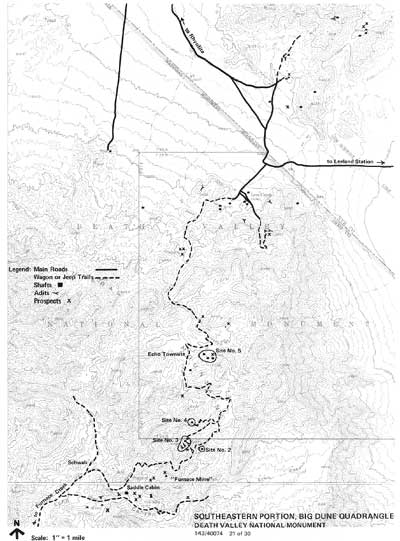
|
| Illustration 180. Map of Southeastern Portion of Big Dune Area. |
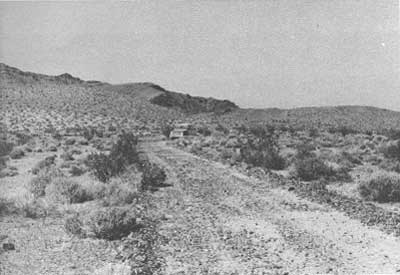 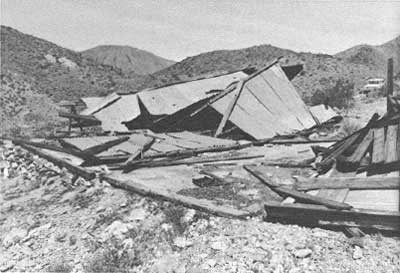
|
| Illustrations 181-182. Top: Echo townsite was located along the main Echo-Lee road, and stretched between the photographer and the vehicle as shown in this picture. The townsite scars are so minute that they will not show up in this general view. Bottom: The ruins of the collapsed Saddle Cabin. 1978 photos by John Latschar. |
Site 3: High above the previous site is a series of 1907-era mines, at the very top of the Funeral Range. Located at the end of a perilous wagon road which follows the lip of the ridge, this complex has four shafts, most of which are well timbered, and the usual traces of past mining efforts, including a concrete engine mount near one of the shafts, and a crude wooden hoisting frame near another. The road leading up to this complex was improved from a burro trail at some time, and the wagon road is complete with a circle at the upper end, where wagons could turn around, provided they were careful not to fall to the floor of Echo canyon, hundreds of feet below. This site is interesting, but due to the multitude of mines in the area, and the rather inexact descriptions given for most of them in the contemporary newspapers, it is impossible to connect a specific mining company to the site. Visiting it is well worth while for the exciting ride and spectacular view, but it does not deserve preservation efforts. Again, the ruins on this site should not be obliterated, but rather left to the ages.
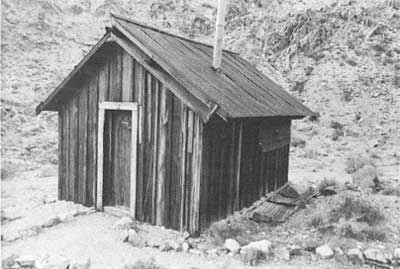 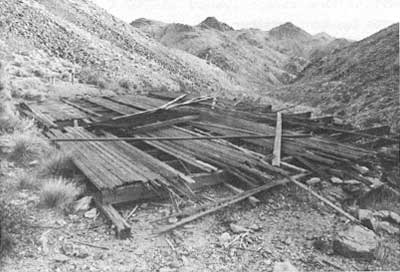
|
| Illustrations 183-184. The cabin and the remins of the wooden tent platform at Site #2, in Echo Canyon. The air vents of the dugout may be seen behind the platform in the lower photo. 1978 photos by John Latschar. |
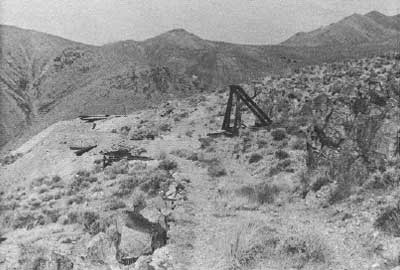 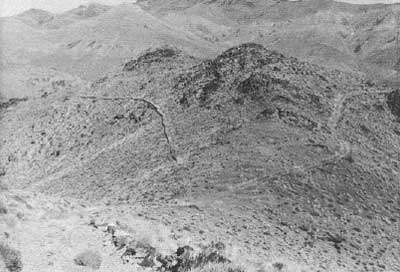
|
| Illustrations 185-186. Top: A general view of Site #3, high on a ridge in the Funeral Mountains. The wagon road, which provided access to this site, may be seen in the immediate foreground. Bottom: View of the access road and burro trail leading up to Site #3. The photographer is standing on the wagon road, which may be followed down towards the right side of the picture, while the older burro trail can be seen winding around the ridge to the left. 1978 photos by John Latschar. |
Sites 4: About a quarter of a mile away, in the next canyon to the north, stands the unappealing remains of a post-World War II mining effort. This site has a decripit wood and paper shack, the remains of a stone-walled building, a leveled tent site, and an untimbered shaft. The shaft has a crude whim, powered by a World War II surplus Dodge Power Wagon, and judging by the condition of the vehicle and winch, has not been used for quite a number of years. The shack, however, was lived in, at least on a temporary basis, as late as 1975, judging by the garbage and magazines strewn about inside. The site lacks significance and deserves no preservation efforts.
Site 5: Towards the Lee side of the district, once one has crossed the summit of the Funeral Range and begun to descent towards the Amargosa Valley, stands another relic of a 1930s-era attempt to revive one of the Lee mines. This site contains a rusty tin shack standing next to an older tent platform site, and was evidently used by some lonely desert hermit who tried to revive one of the several old mines visible in the immediate vicinity. It also lacks historical significance and deserves no preservation efforts.
e. General Echo-Lee District Recommendations
The Echo-Lee District offers Death Valley National Monument one of its greatest potential historic areas. Using the present roads and jeep trails, a four-wheel drive vehicle can easily negotiate the entire distance across the Funeral Range from Schwab to Lee. With periodic grading, normal passenger cars could be offered an exciting and adventurous excursion, similar to the Titus Canyon road experience--and probably at less cost, since maintenance costs for the Echo Canyon road would be less.
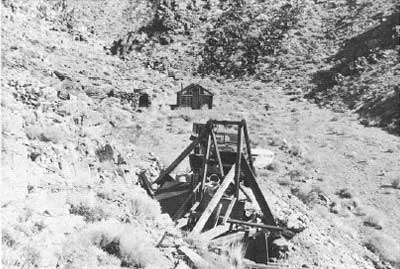 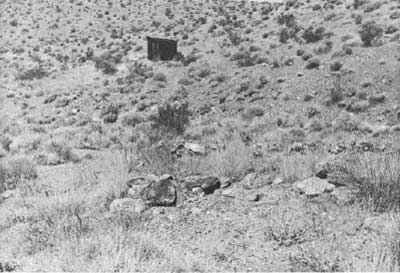
|
| Illustrations 187-188. Top: General view of the mine, Power Wagon, and cabin at Site #4. Bottom: The wood and tin shack on Site #5. 1978 photos by John Latschar. |
Starting at the junction of Furnace Creek road and the Echo Canyon jeep trail, the visitor would first travel up through lower Echo Canyon, where the walls of the canyon rise straight up cut of the desert floor in much the same way as does lower Titus Canyon. After passing through the impressive lower canyon, the visitor could then stop at the Inyo Mine and mill complex, then double back to the upper Echo Canyon road and stop at Schwab. Further up the canyon, on the old Schwab-Lee road, a short but arduous hike could be offered to the more energetic visitors, whereby they could view the "Furnace" mine complex. Further up the canyon road is Site #2, with its assorted ruins.
After climbing out of Echo Canyon along the old road, adventurous visitors could then follow the old wagon road along the crest of the ridge to Site #3, and the less adventurous could continue to follow the main road up over the crest of the Funeral Range and down to Lee. Along the way, the townsite of Echo could be seen, before the travelers descended into the Amargosa Valley at the sites of Lee townsite and the Hayseed Mine.
At this point, several options would be available. The route could be retraced back to Furnace Creek, or the visitors could continue on. Turning to the north, they could follow the old Rhyolite-Lee road out towards Rhyolite, crossing the grade of the Tonopah & Tidewater Railroad on the way, and return to Death Valley via Daylight Pass. Sidetrips could be made, as desired, to Rhyolite, the Original Bullfrog Mire, the Homestake and Gold King mill ruins, the Chloride Cliff District, or through Titus Canyon. To the south from Lee, the road to Leeland Station on the Tonopah & Tidewater could be followed, and then the visitor could return to Death Valley through Furnace Creek.
Whichever option is followed, a trip such as this would offer the visitor a combination of scenic beauty, spectacular views, an exciting ride, and numerous interpretive possibilities. The interpretation could be carried out either through signing at the sites, a trip booklet available at the visitors center, or a combination of both. Such a visitor experience as this is not available anywhere else in Death Valley National Monument.
| <<< Previous | <<< Contents >>> | Next >>> |
deva/hrs/section4b.htm
Last Updated: 22-Dec-2003